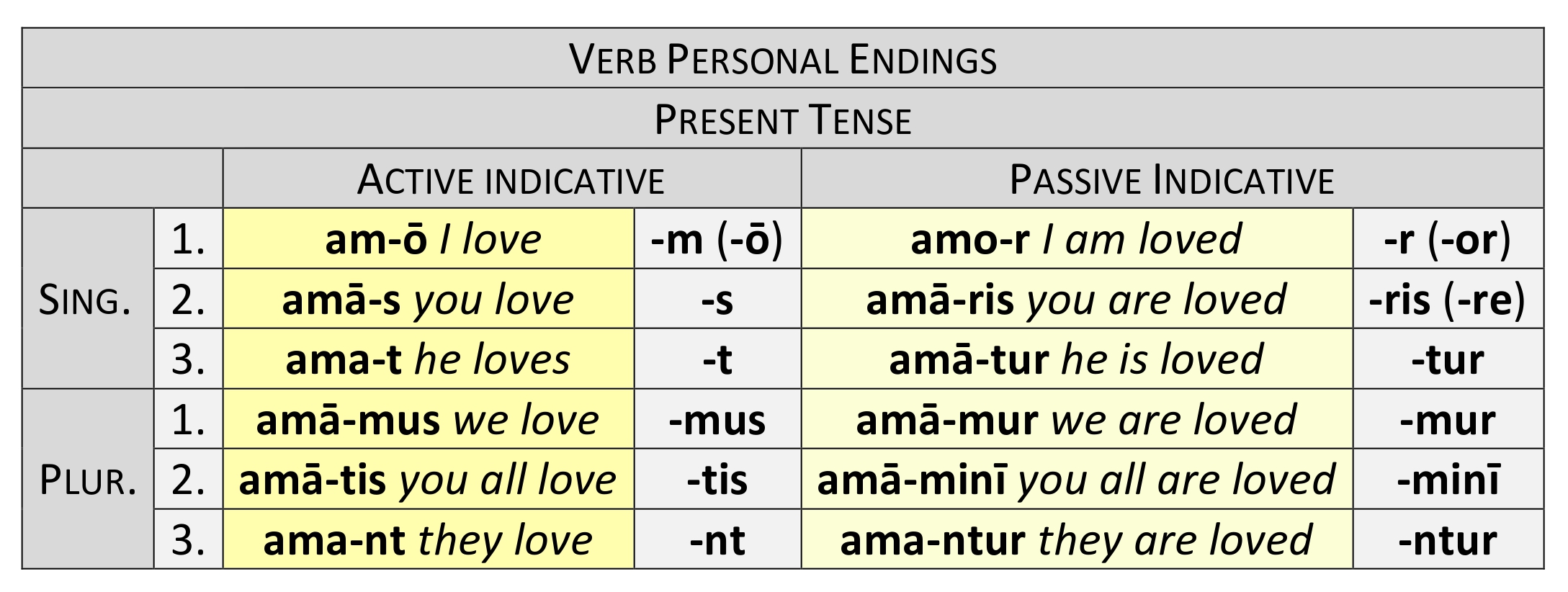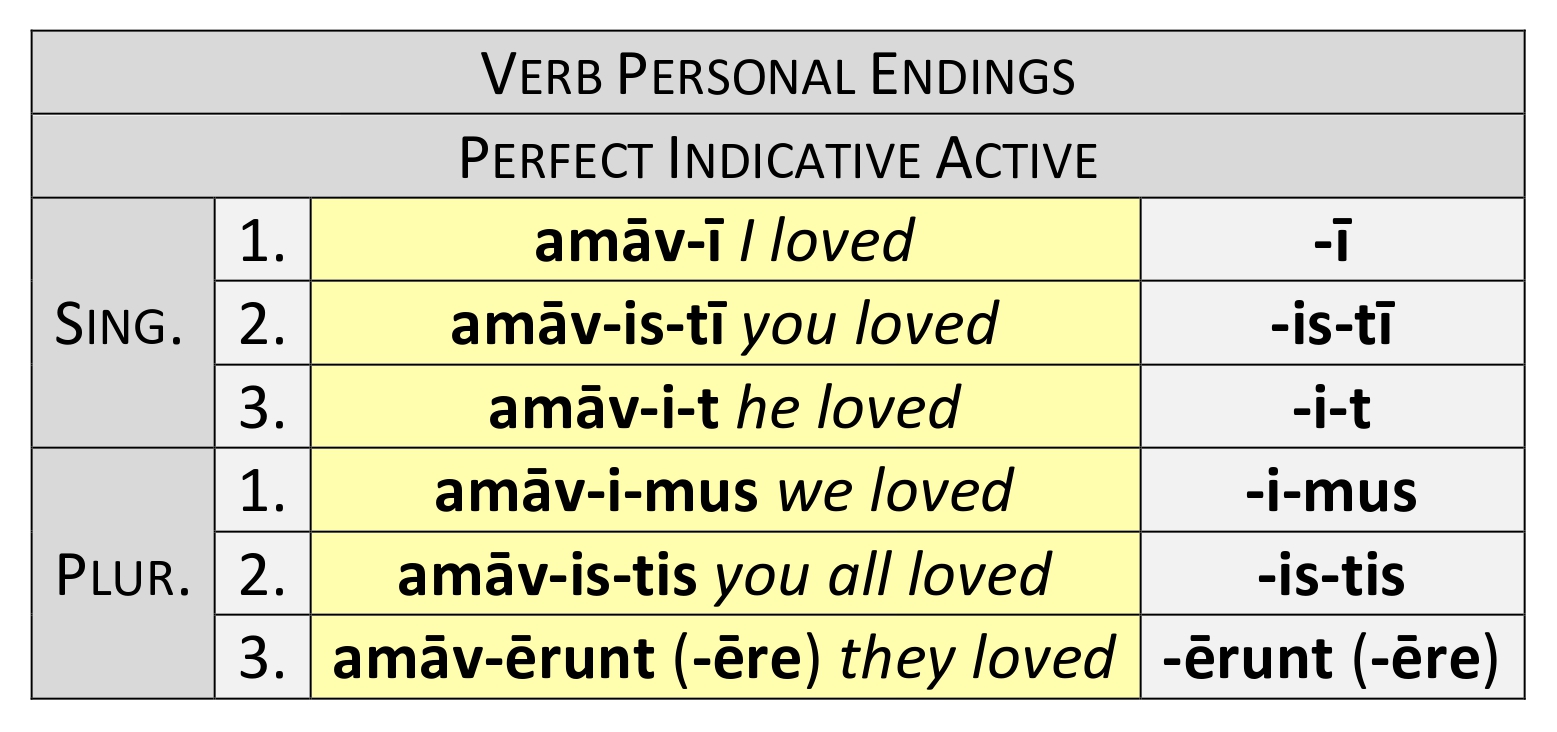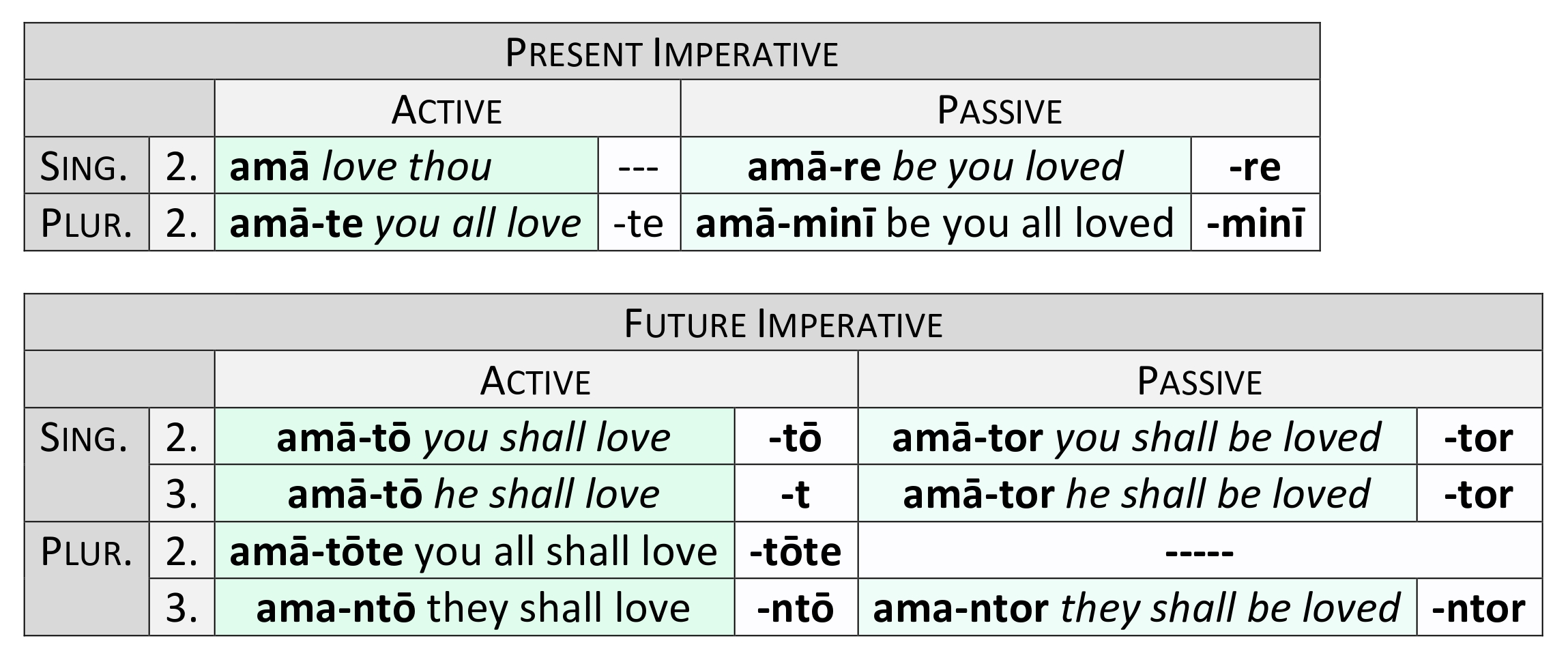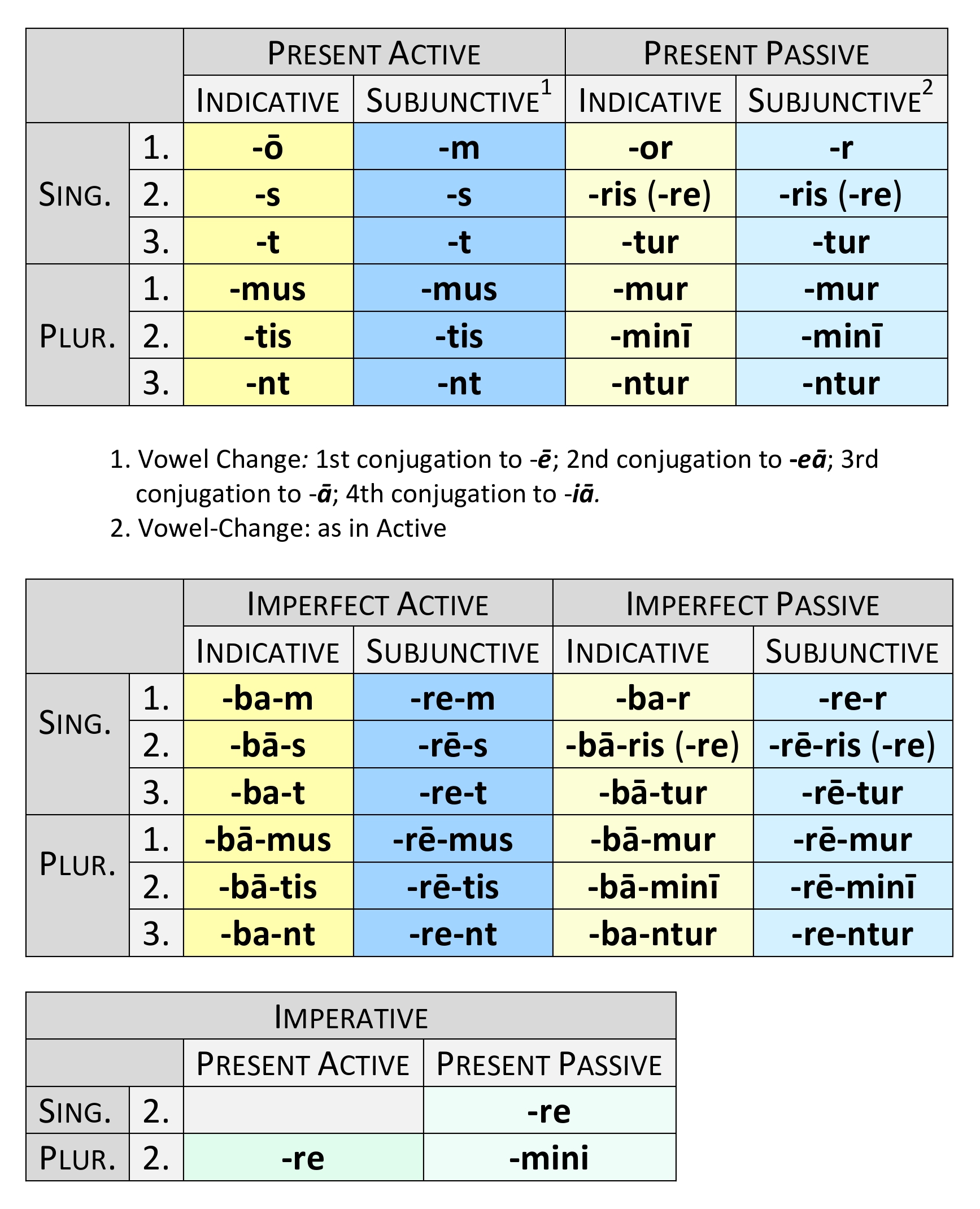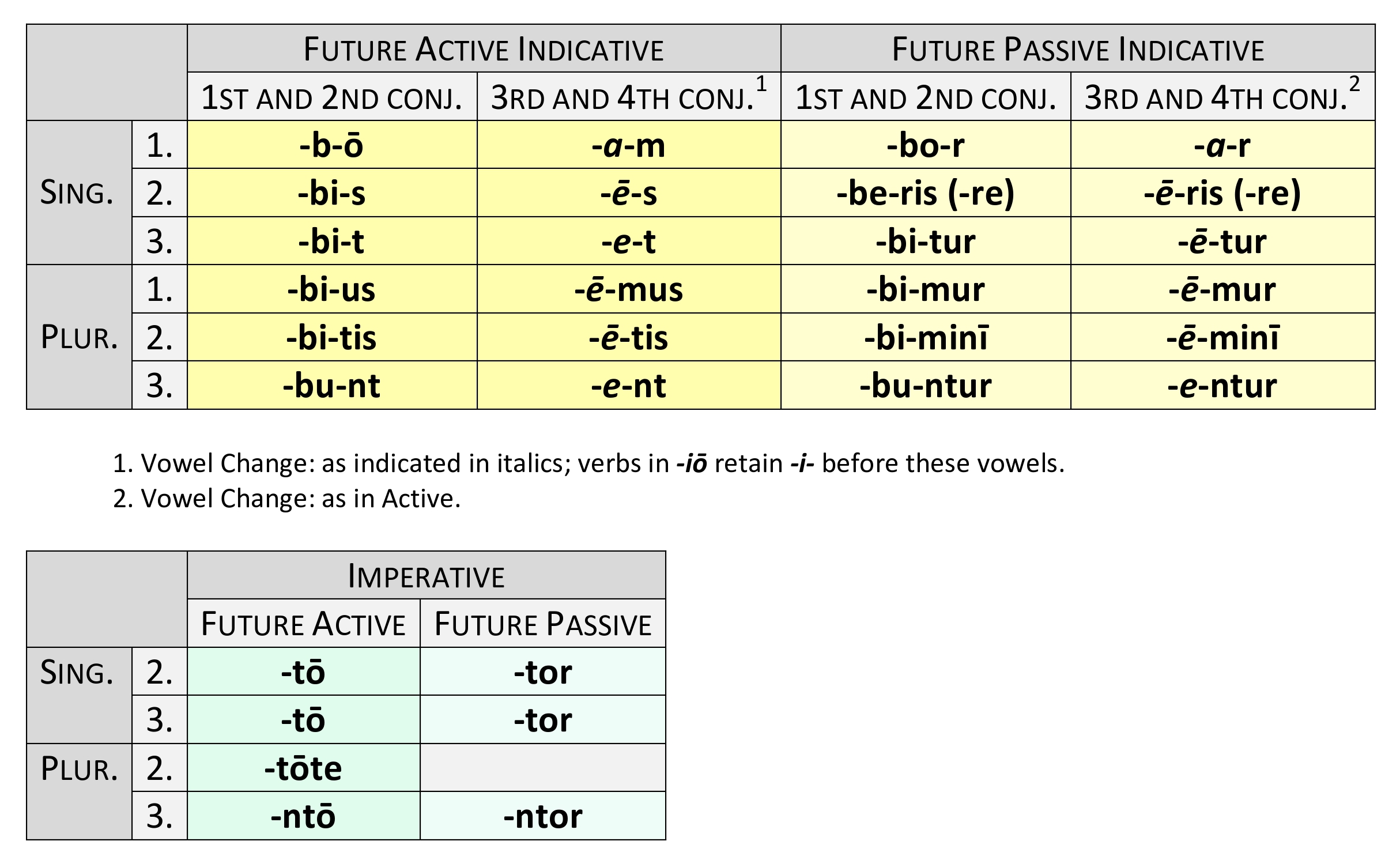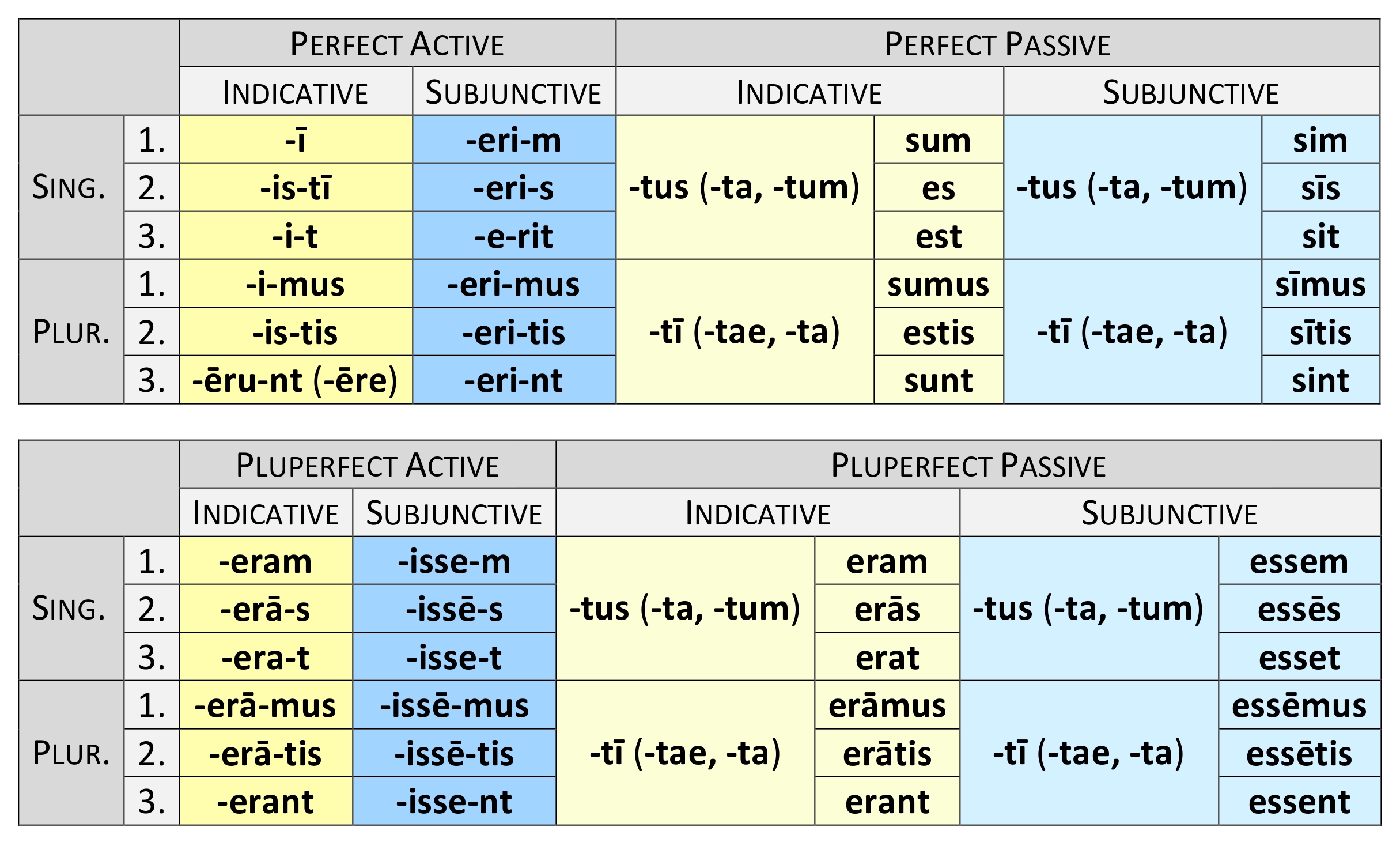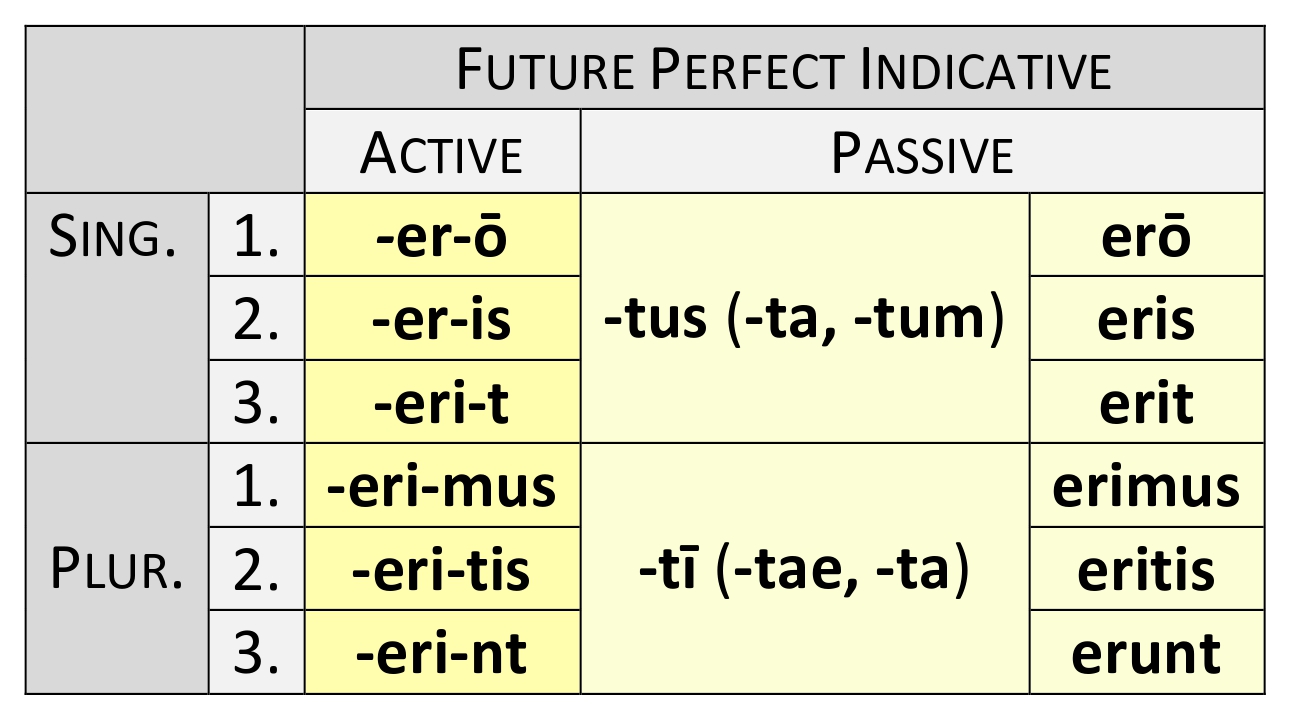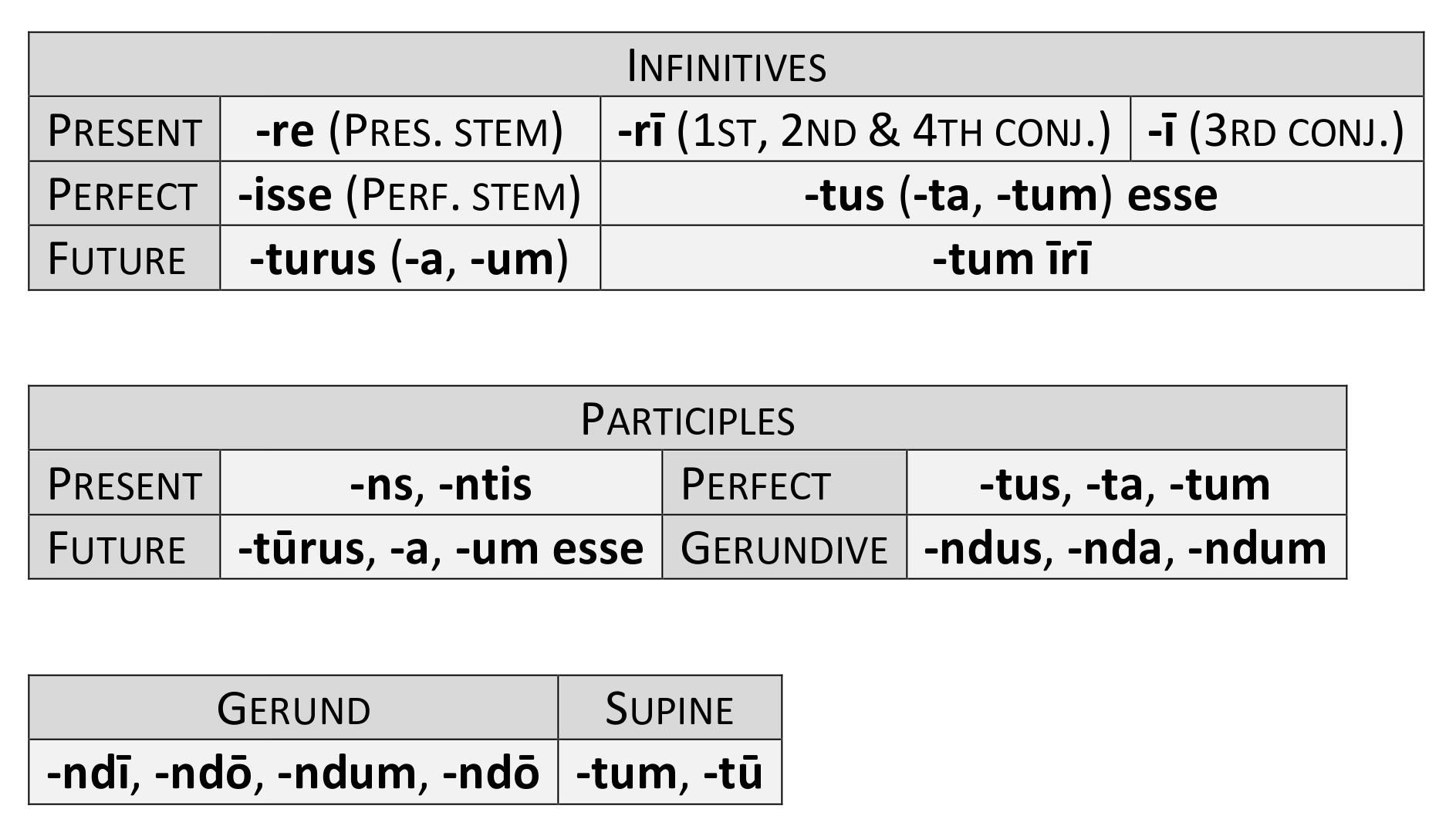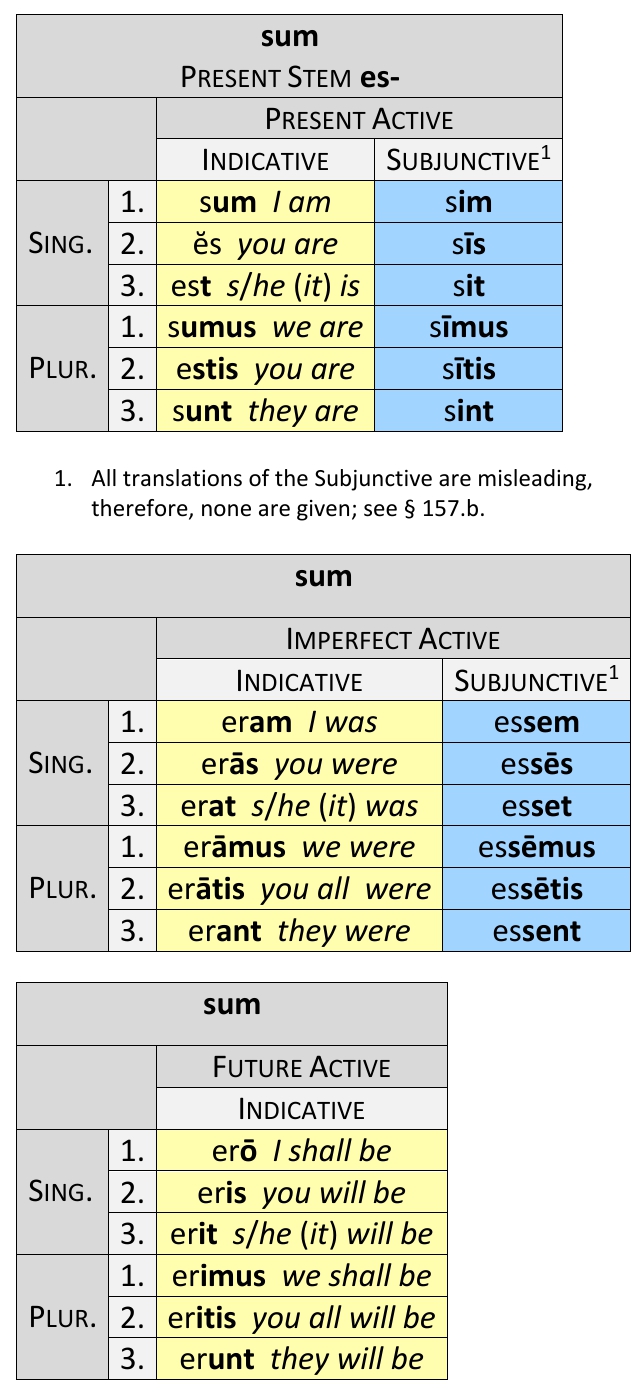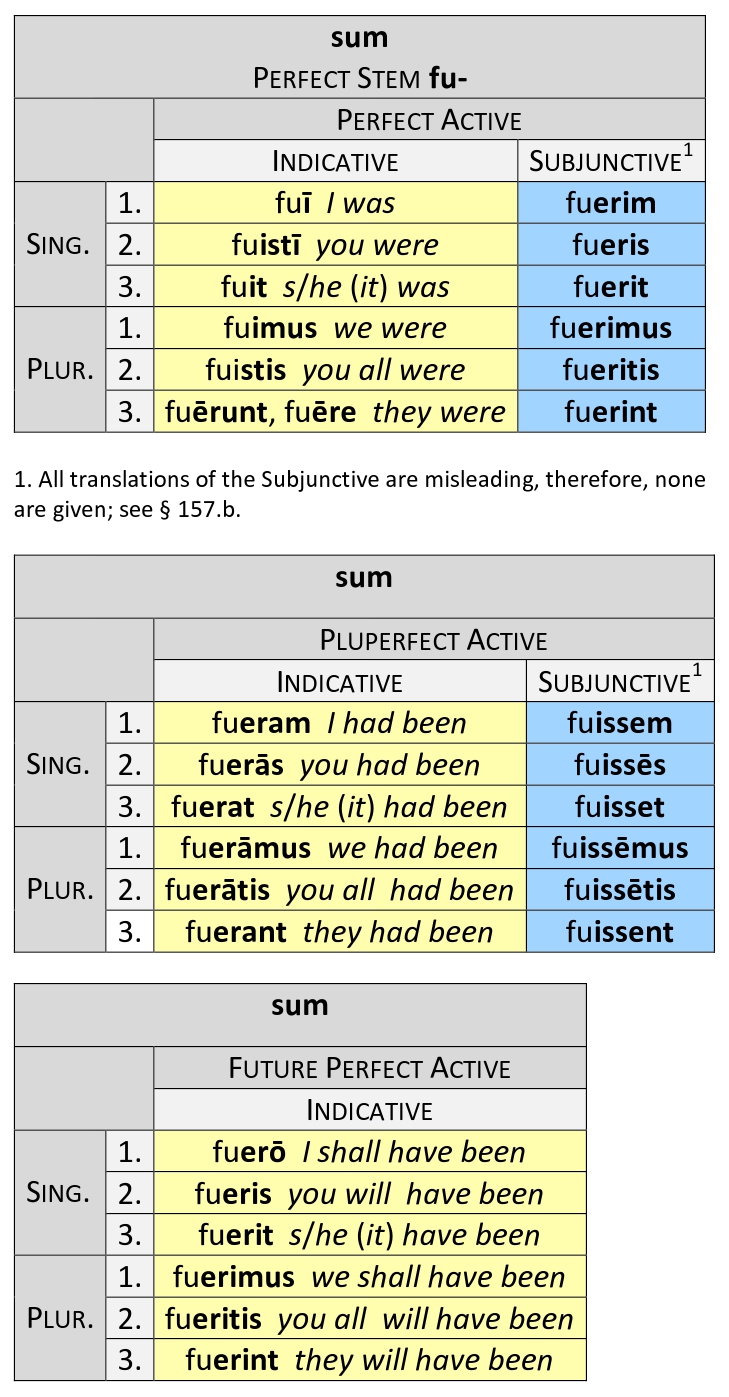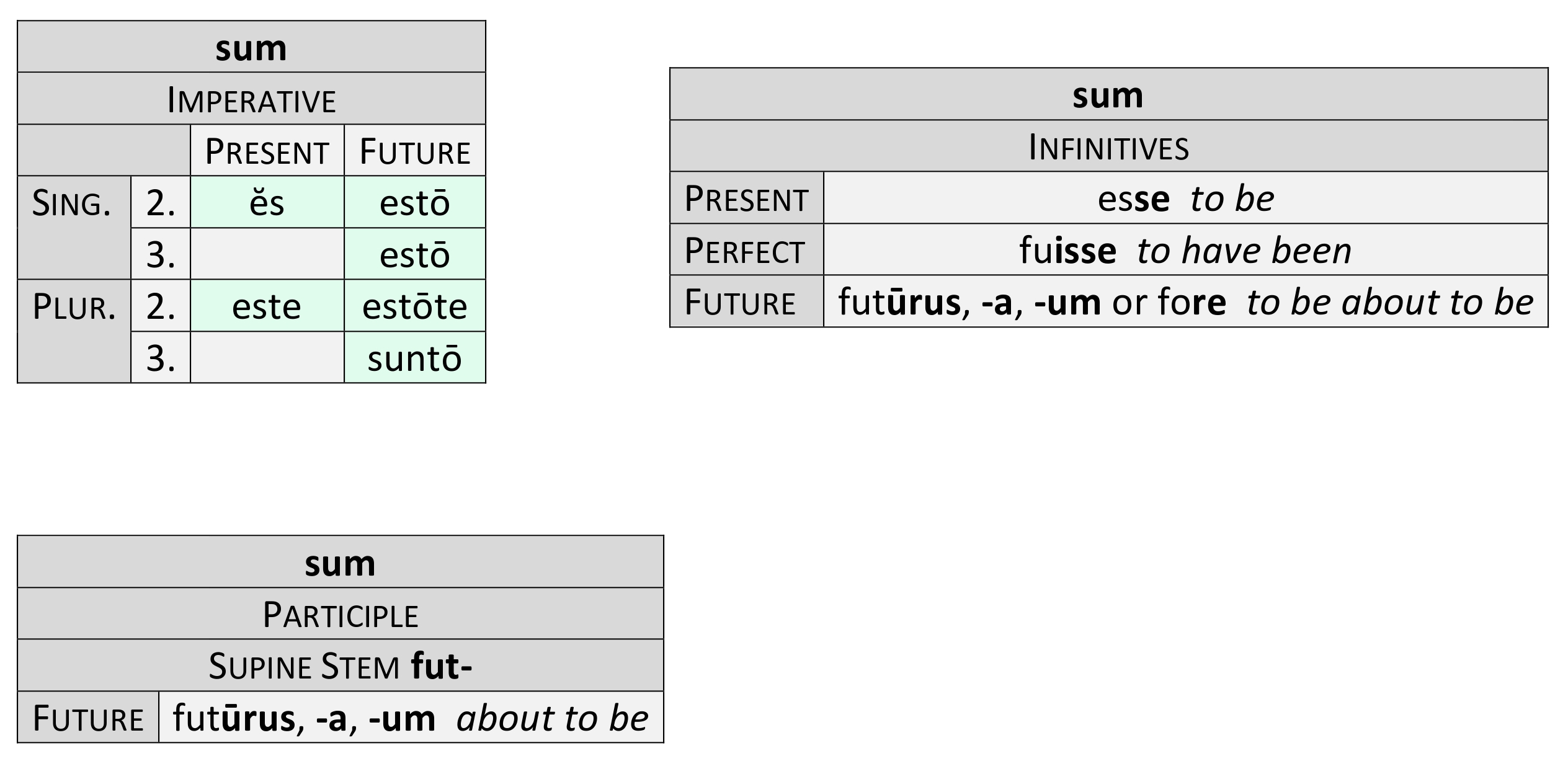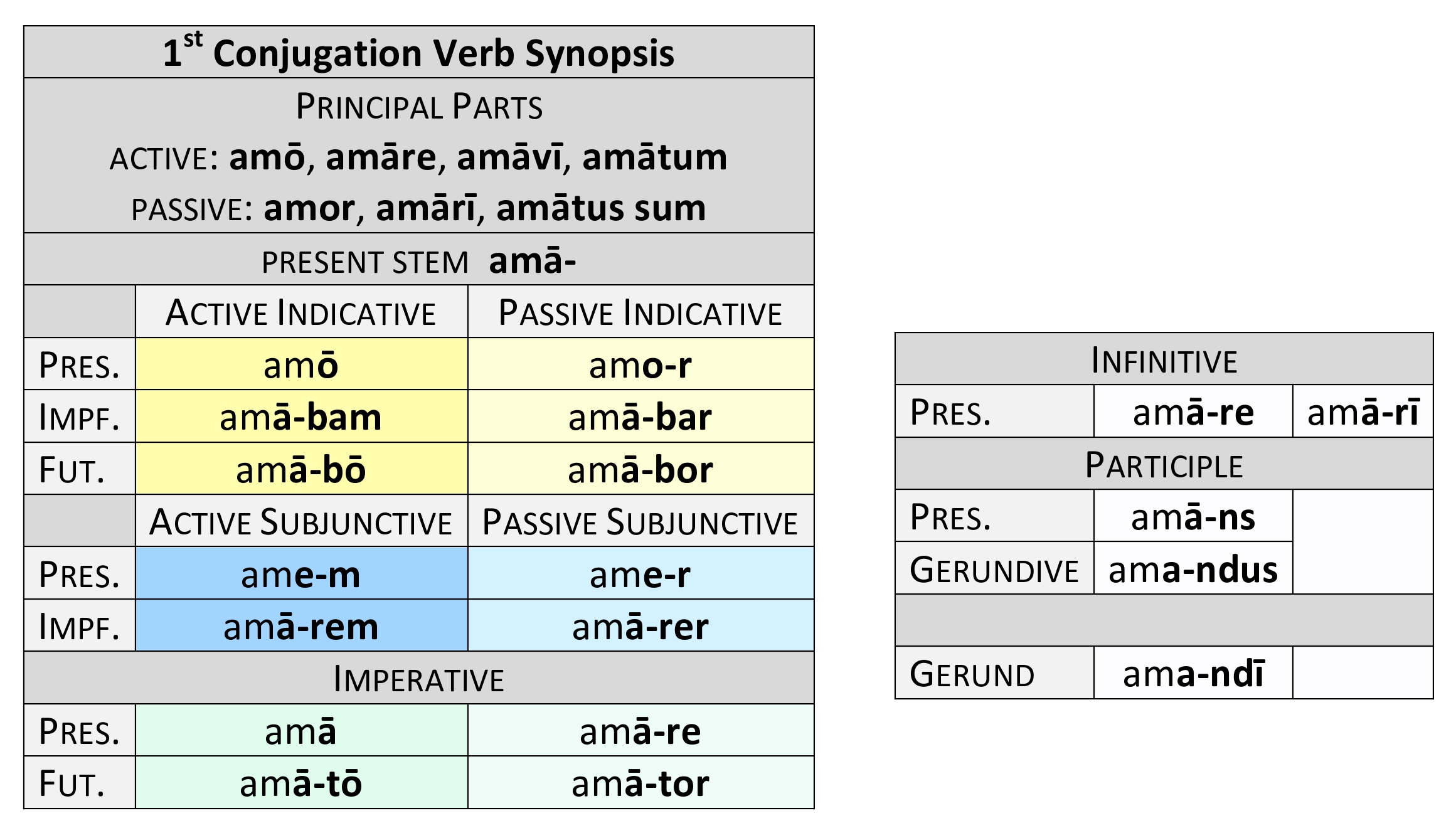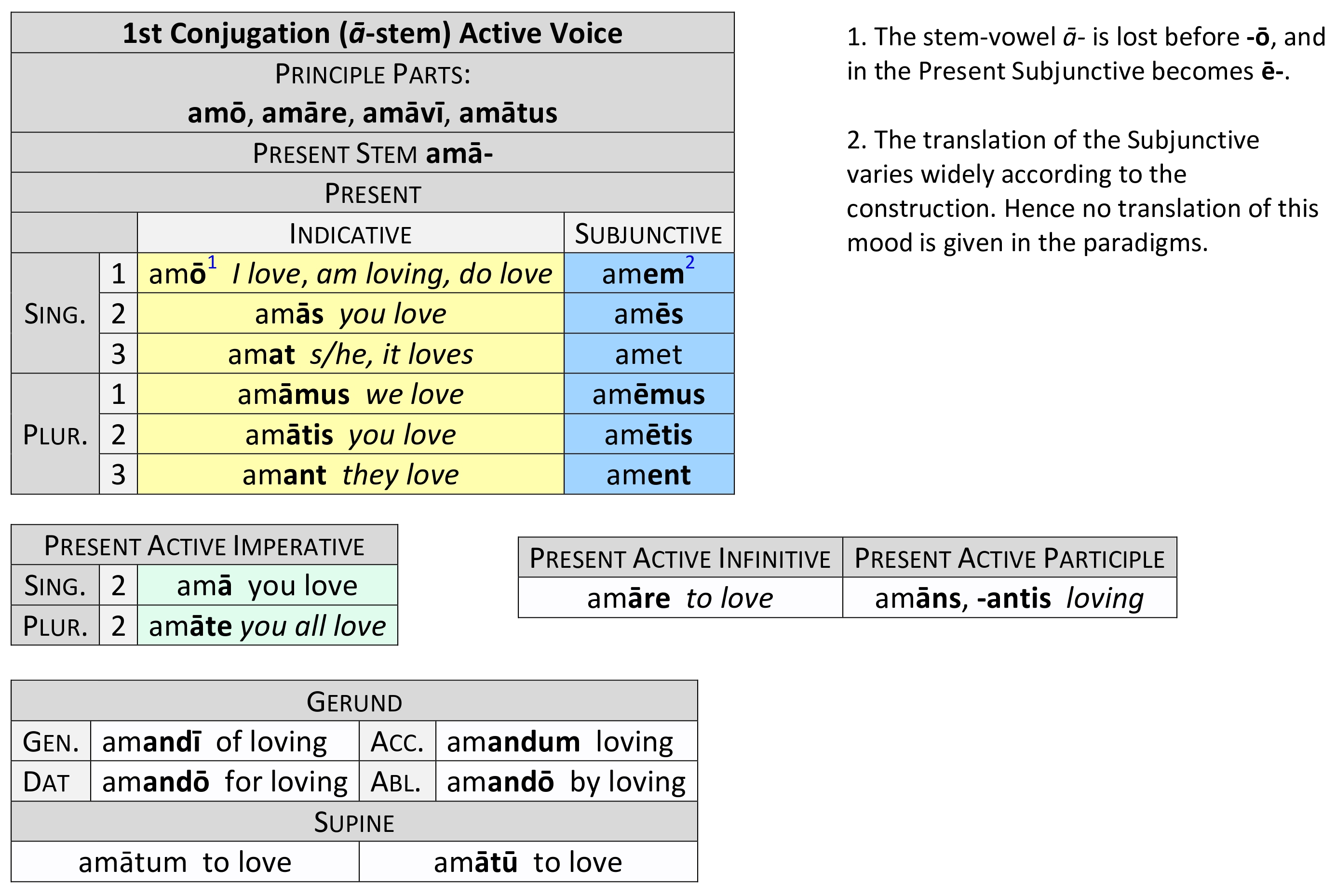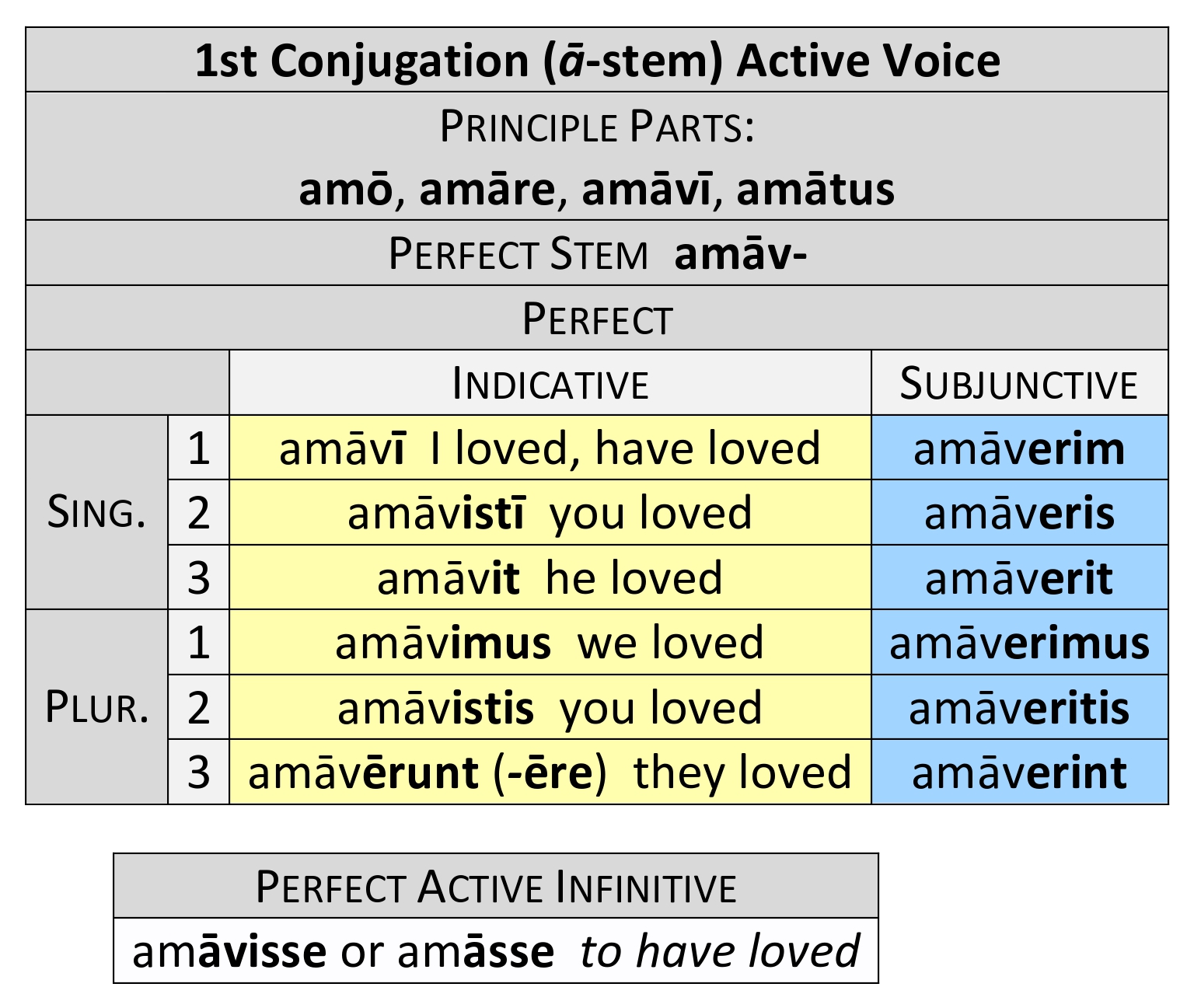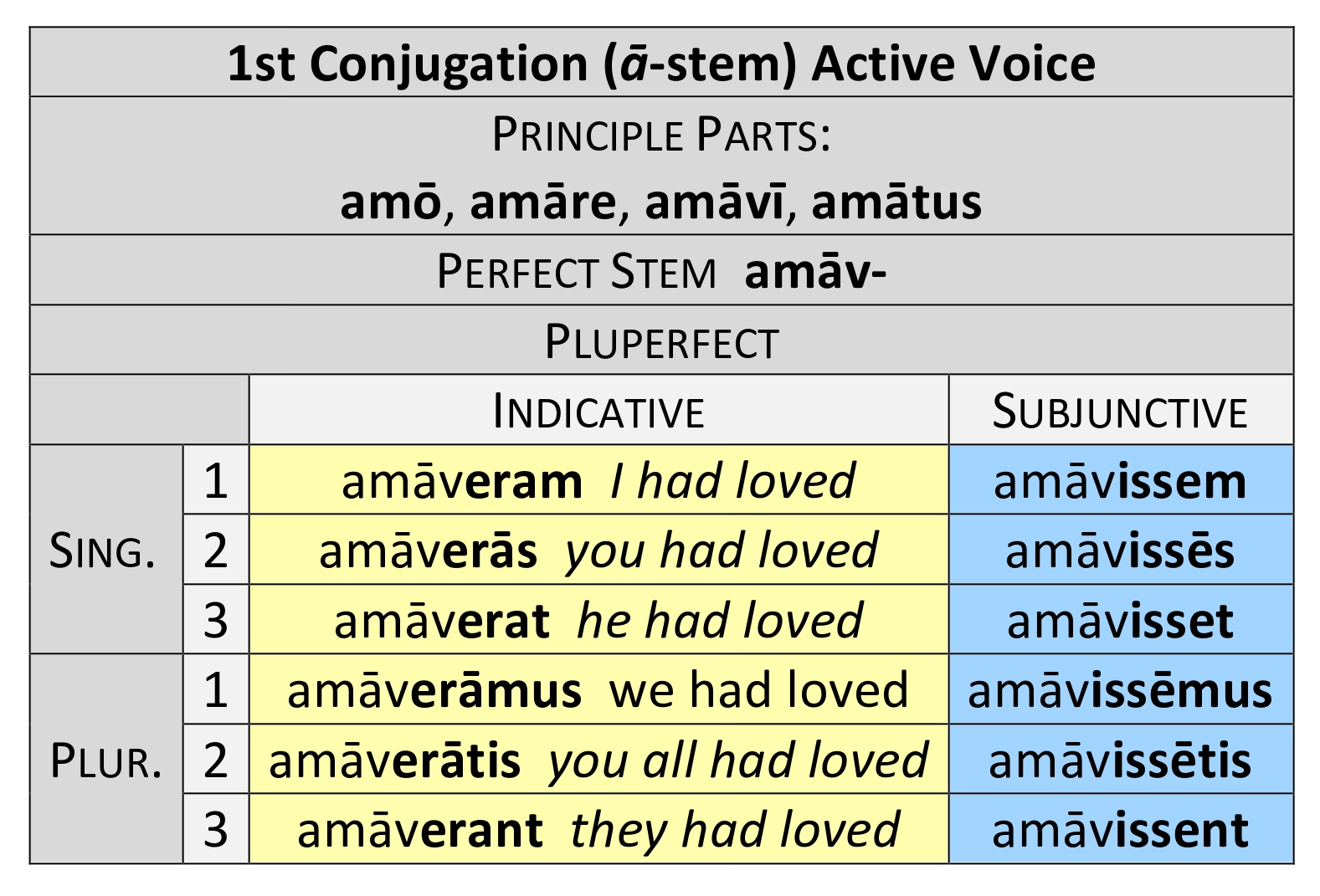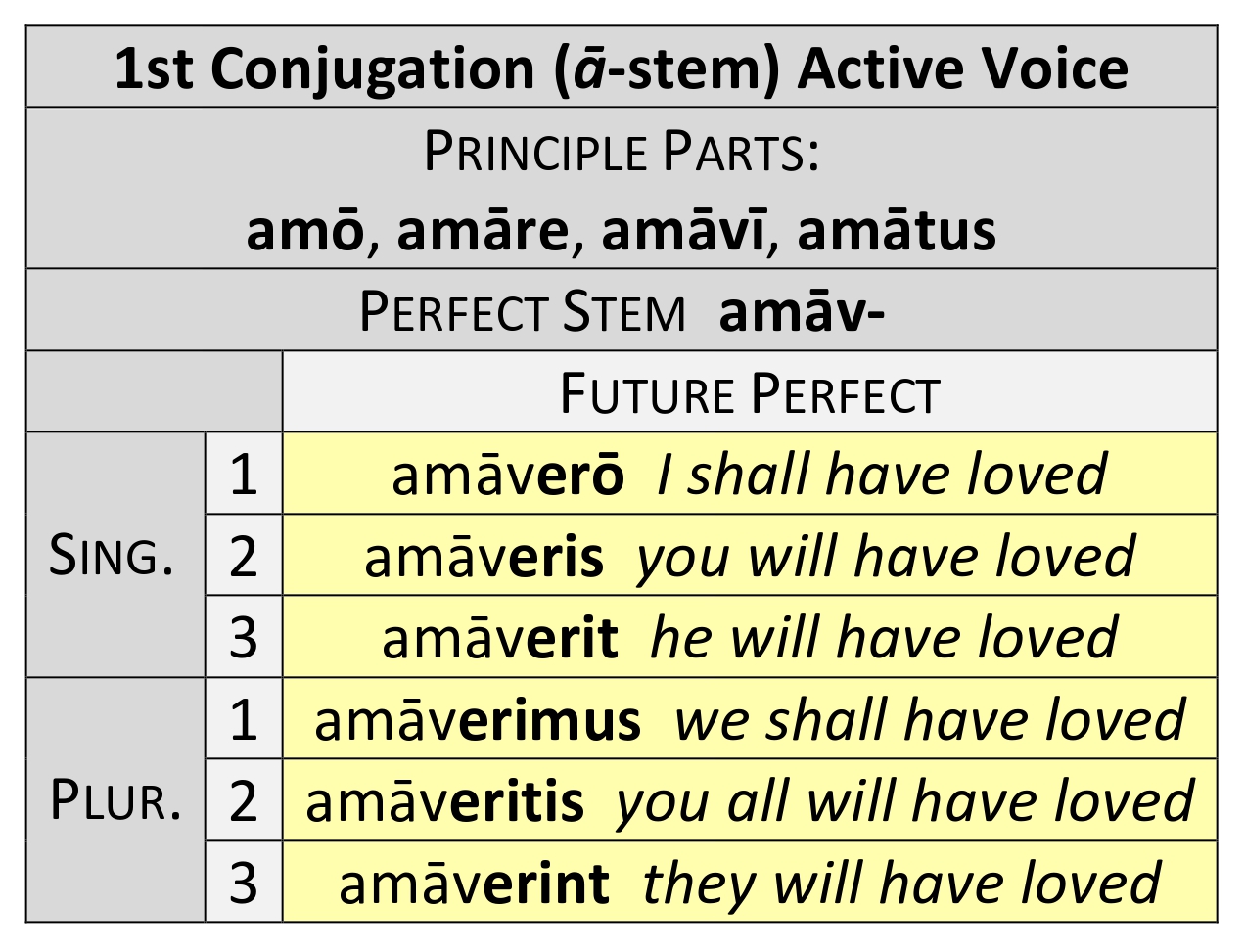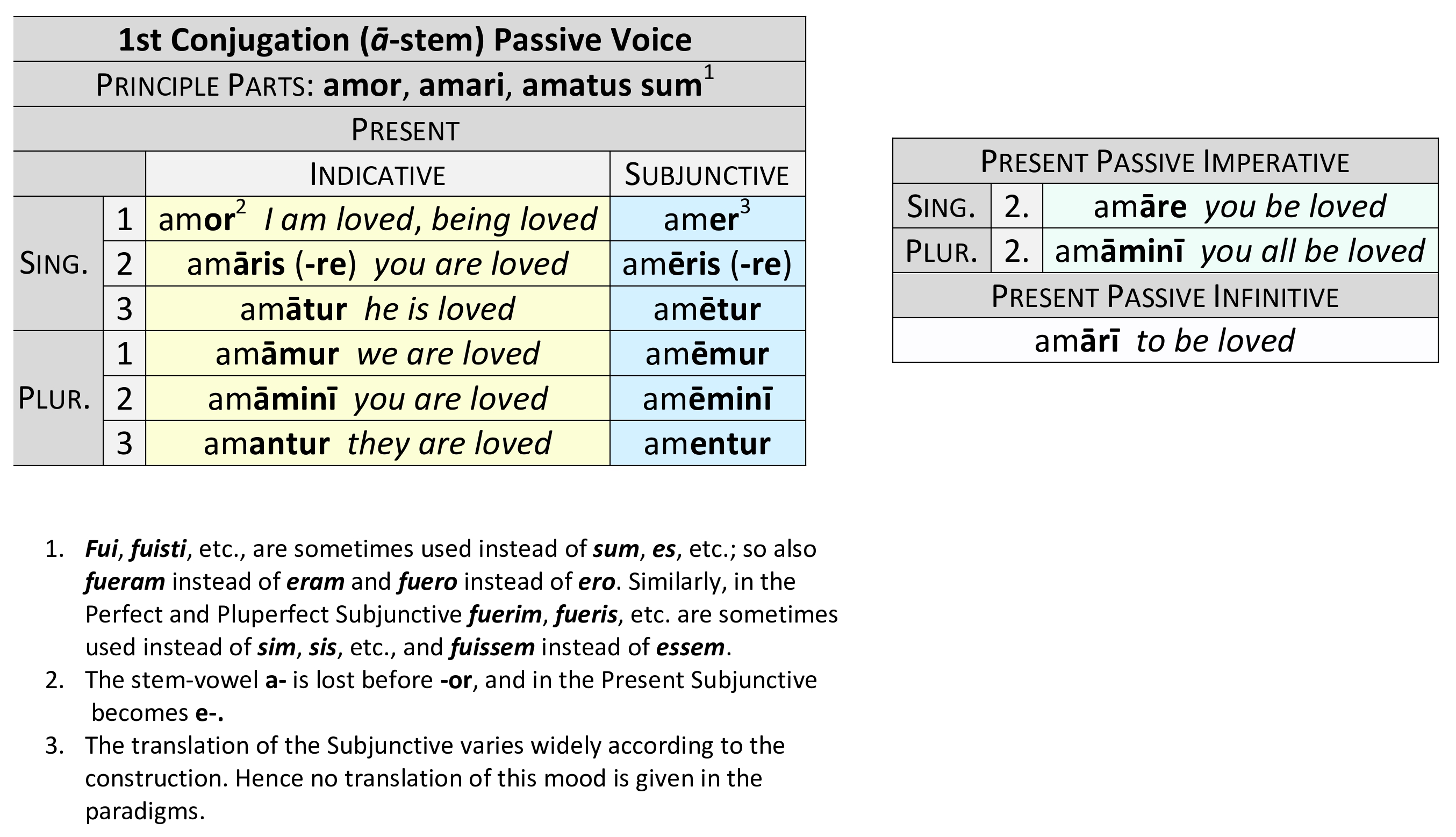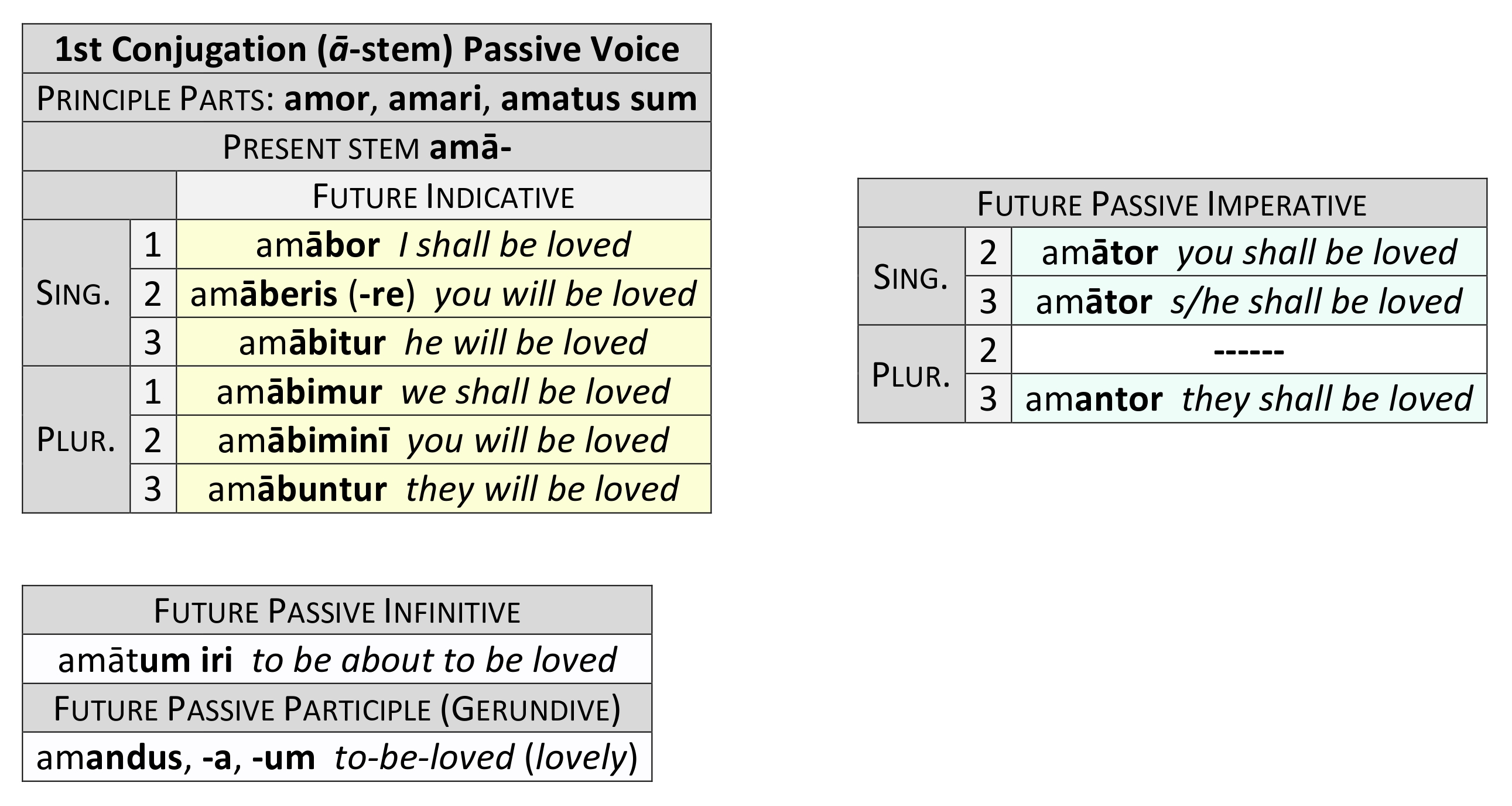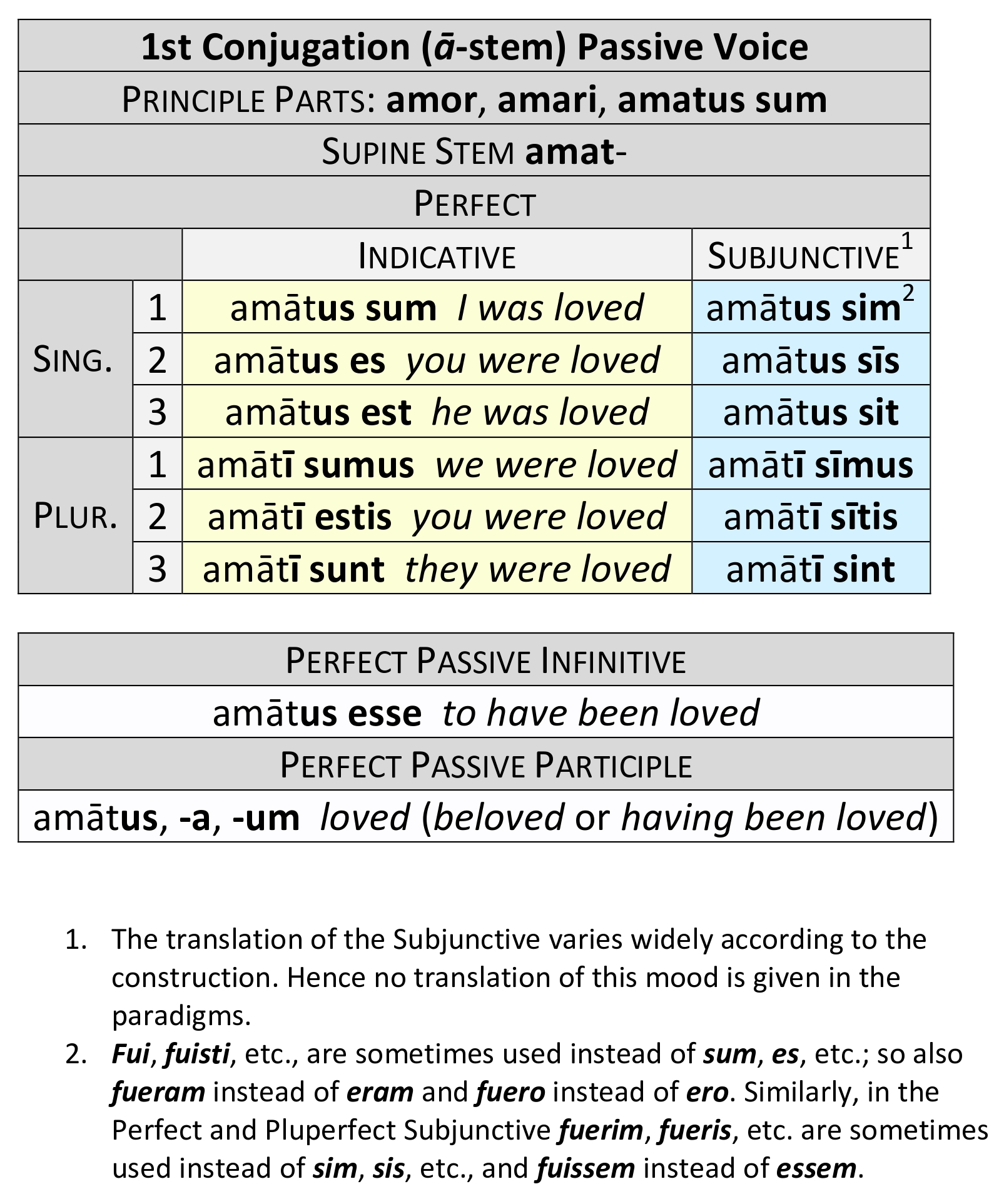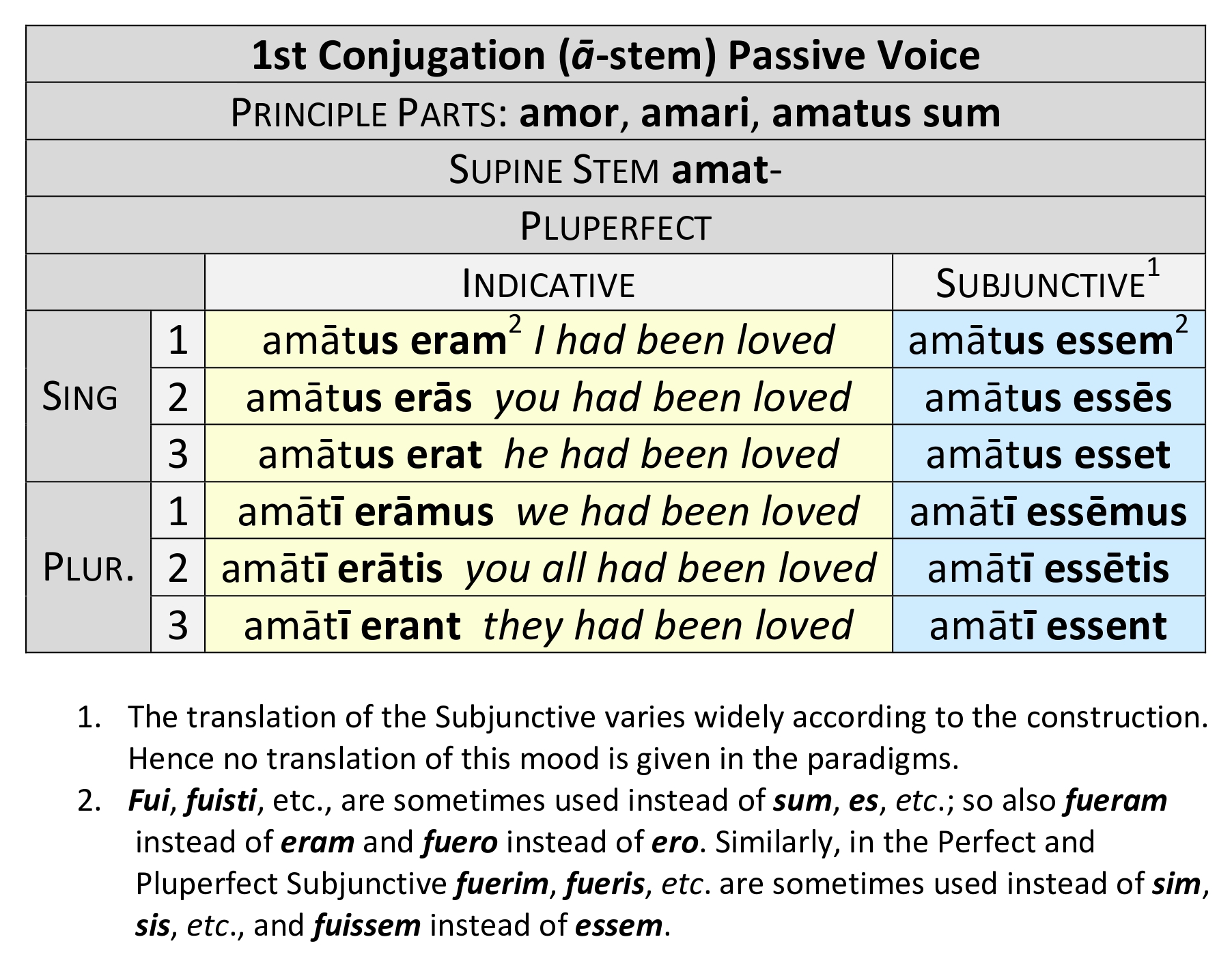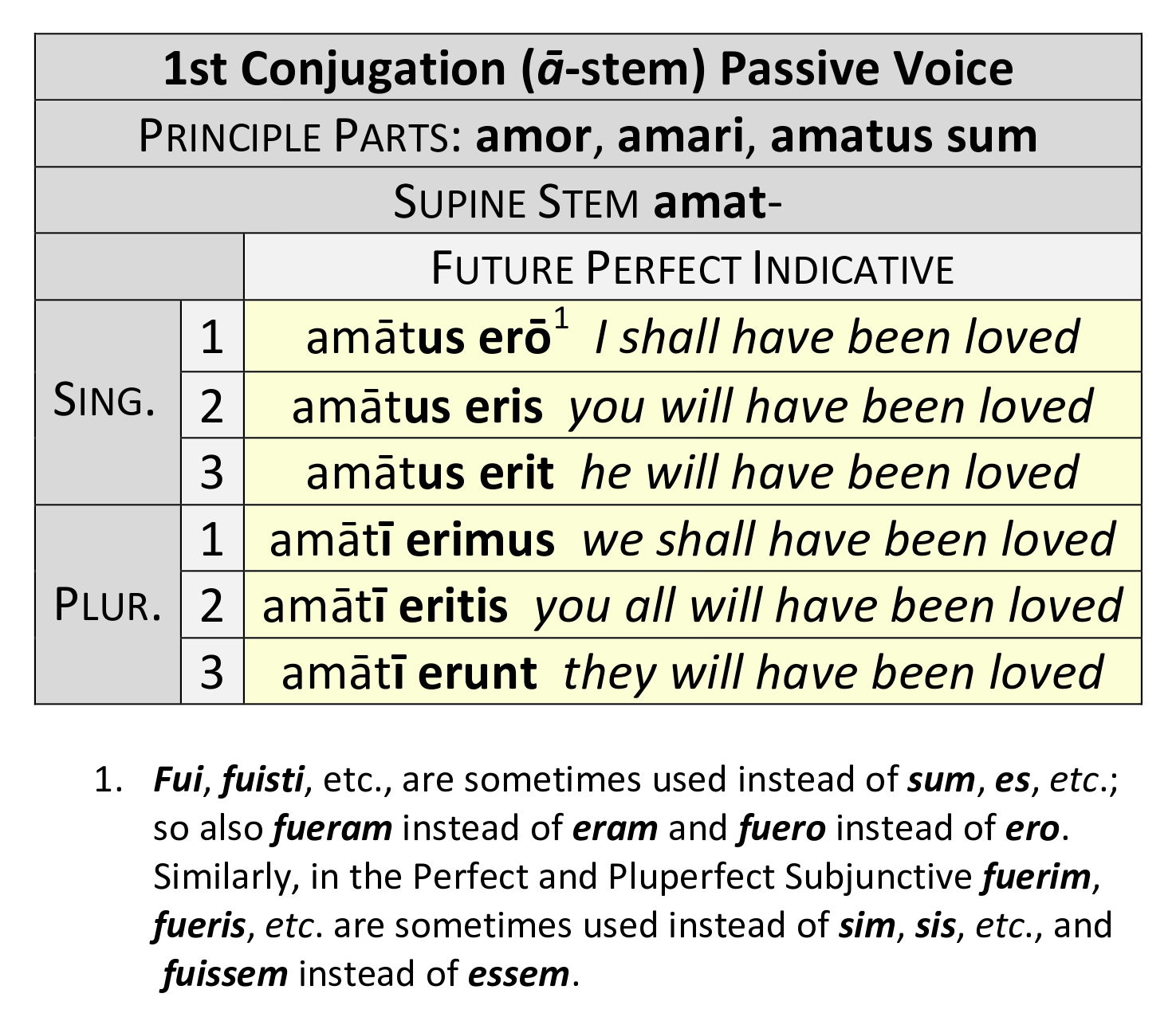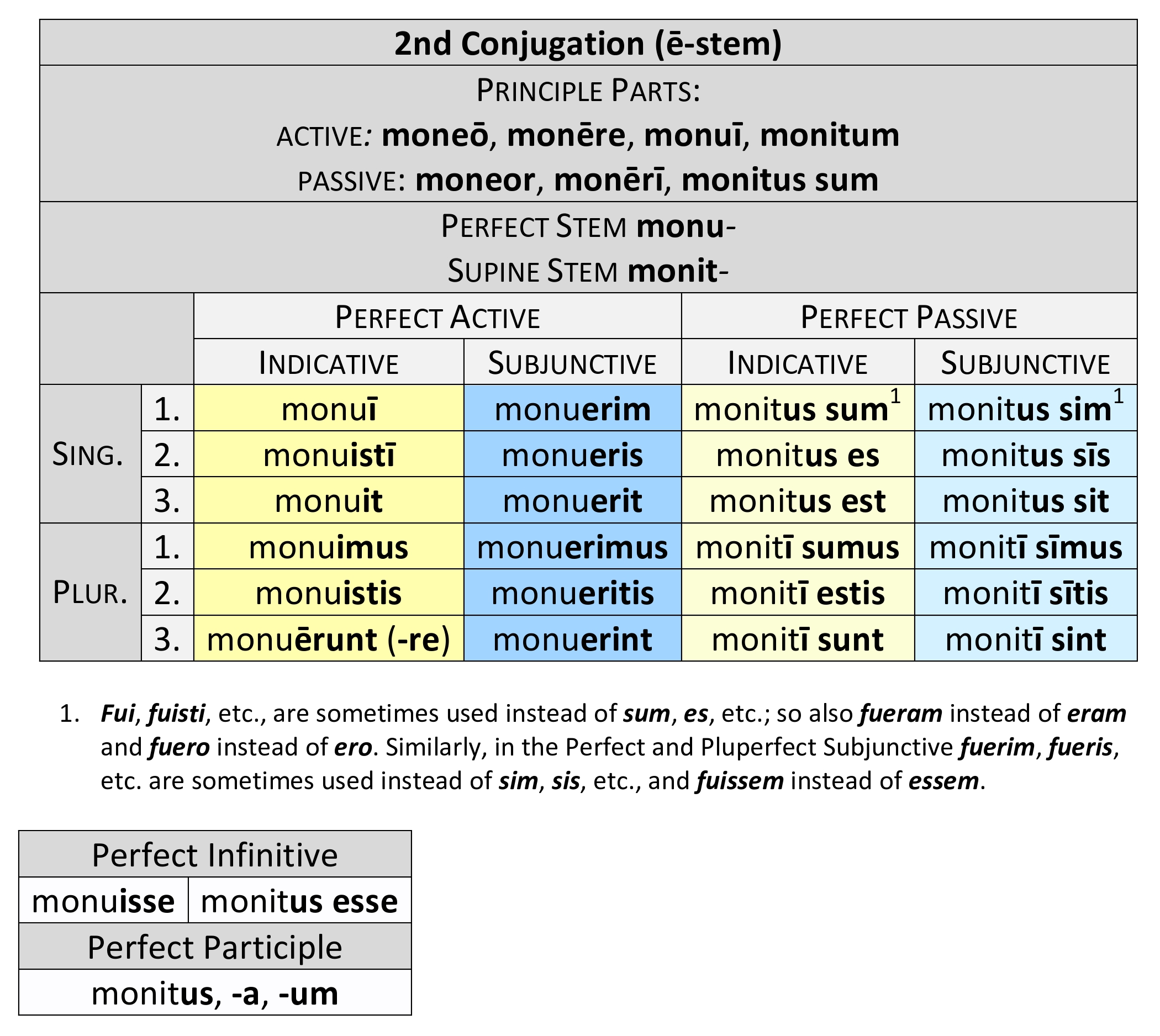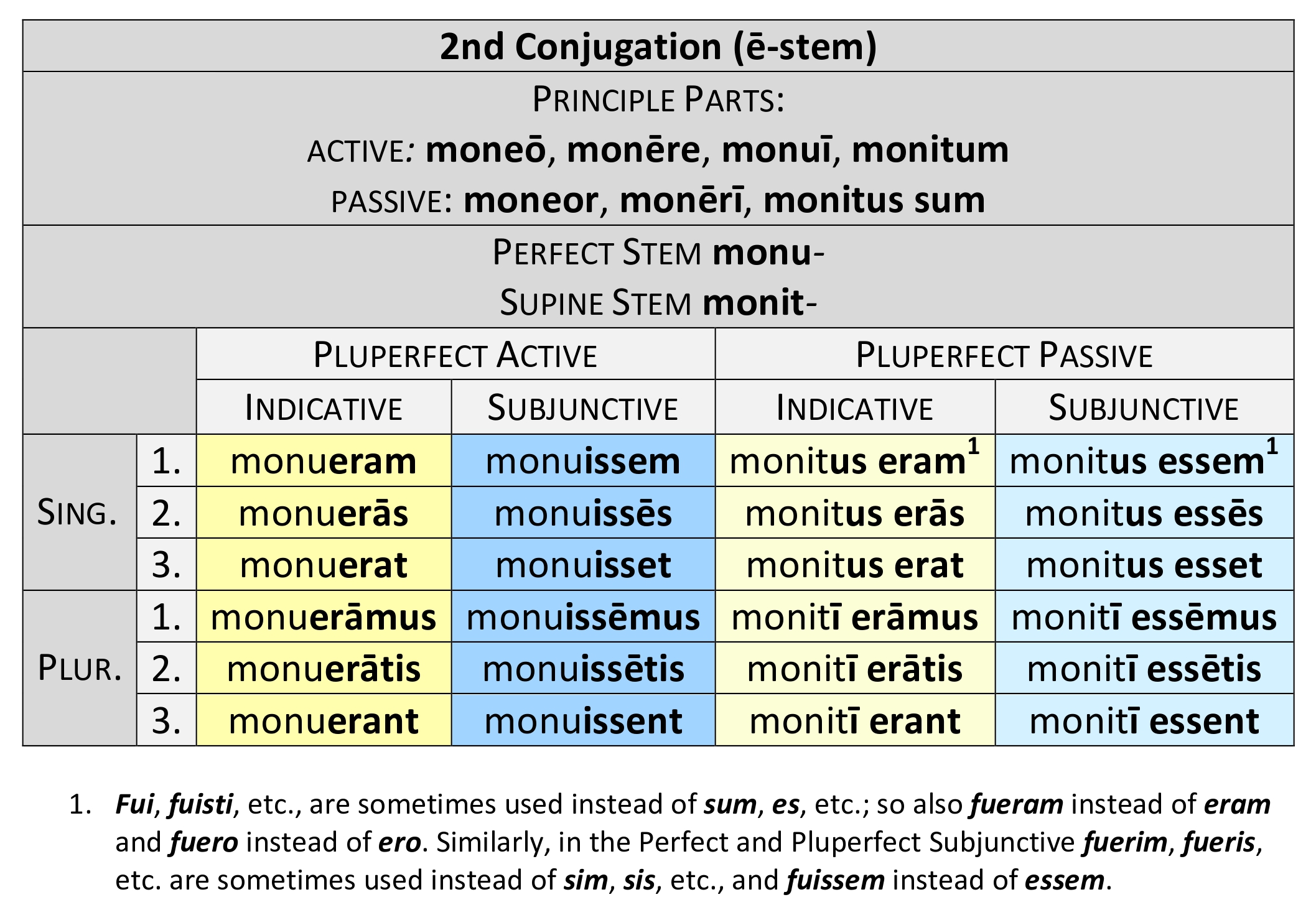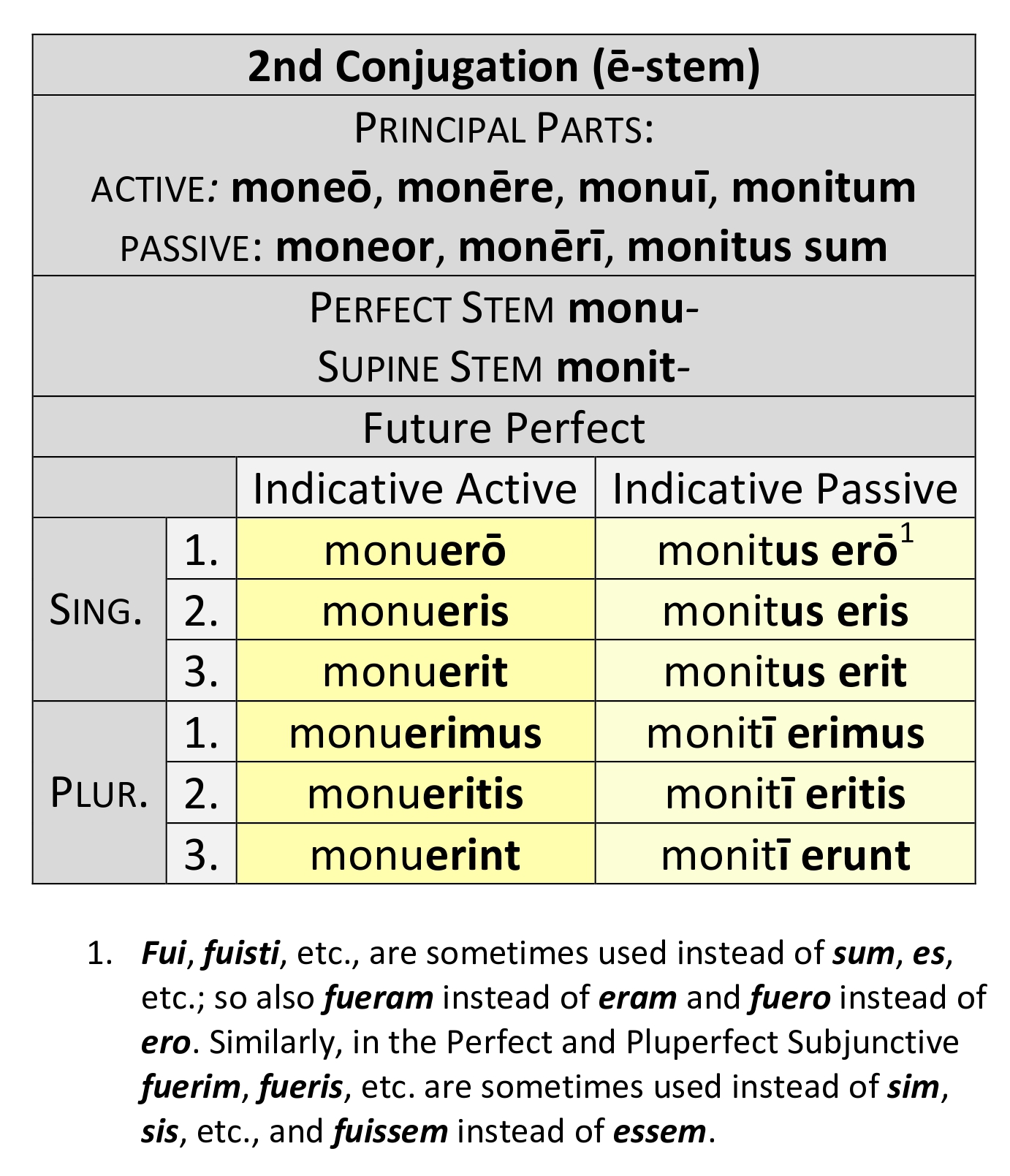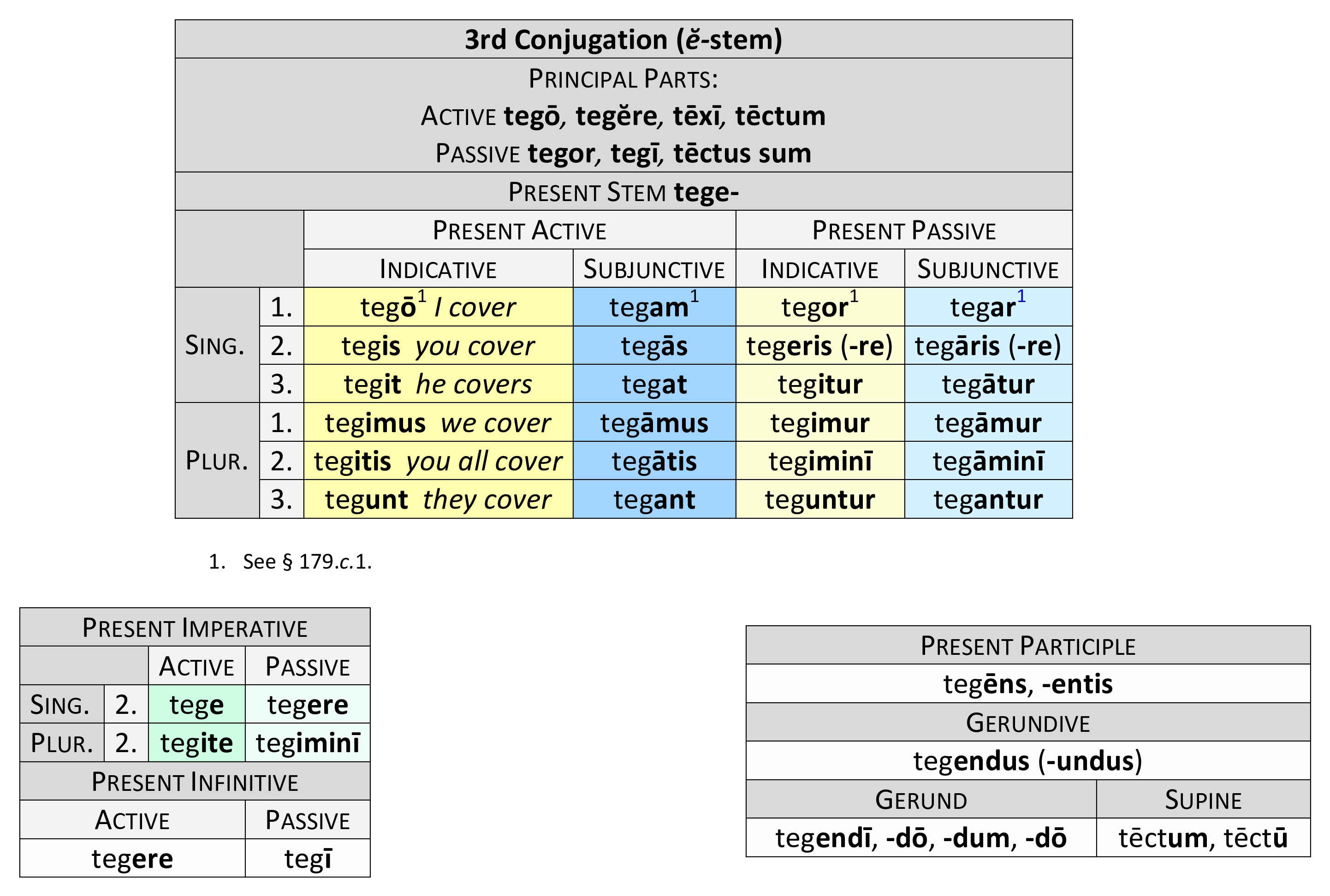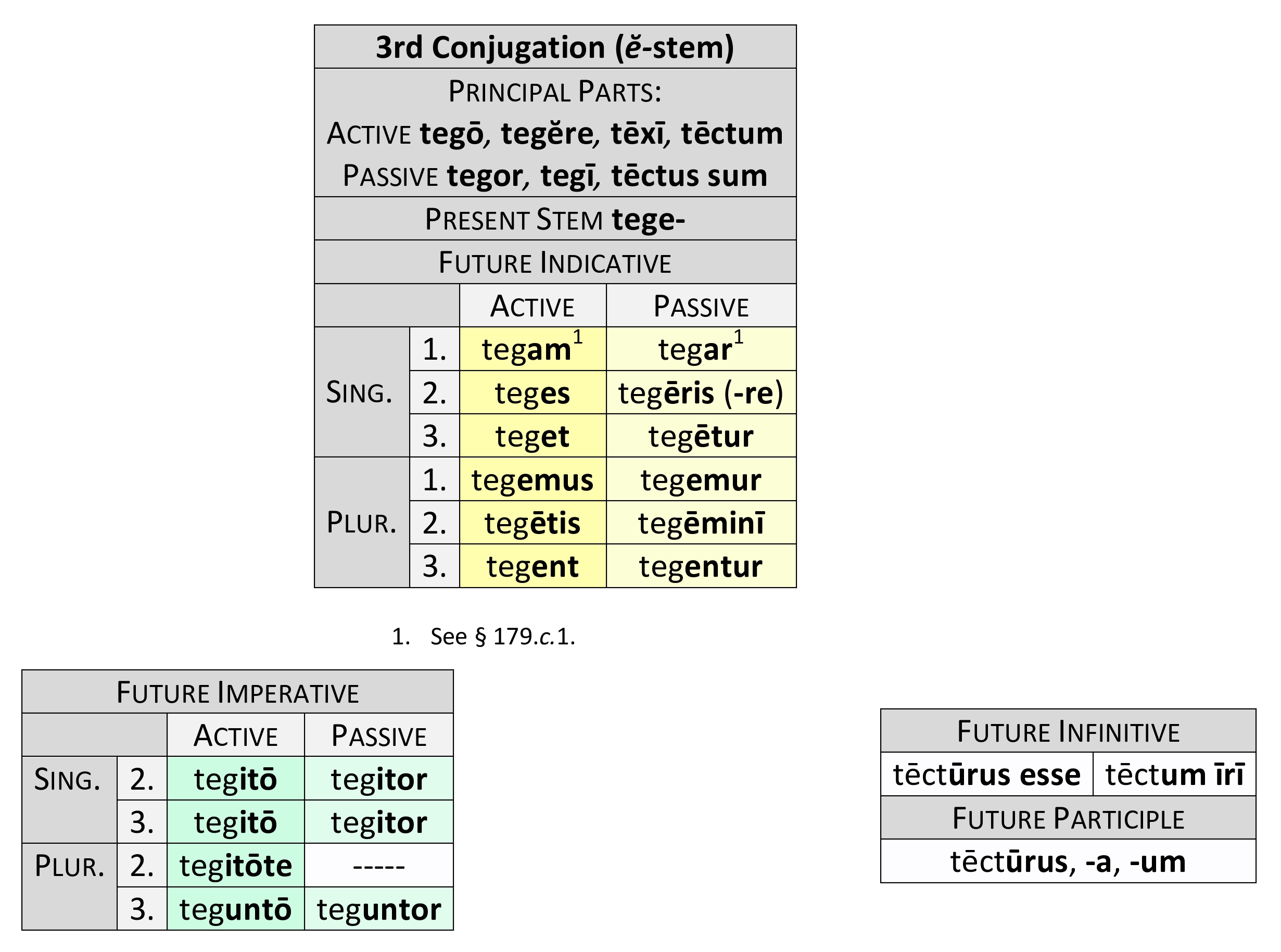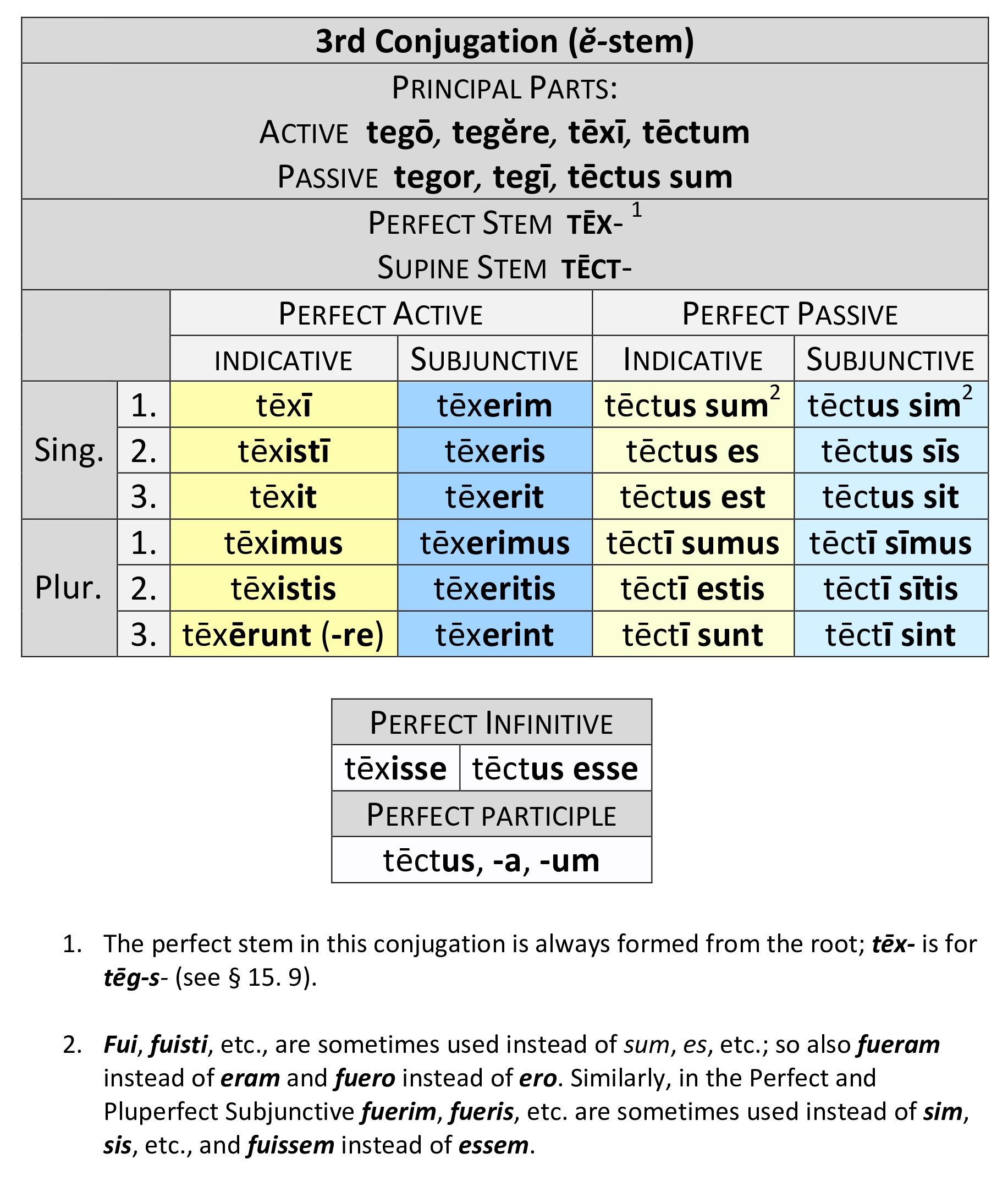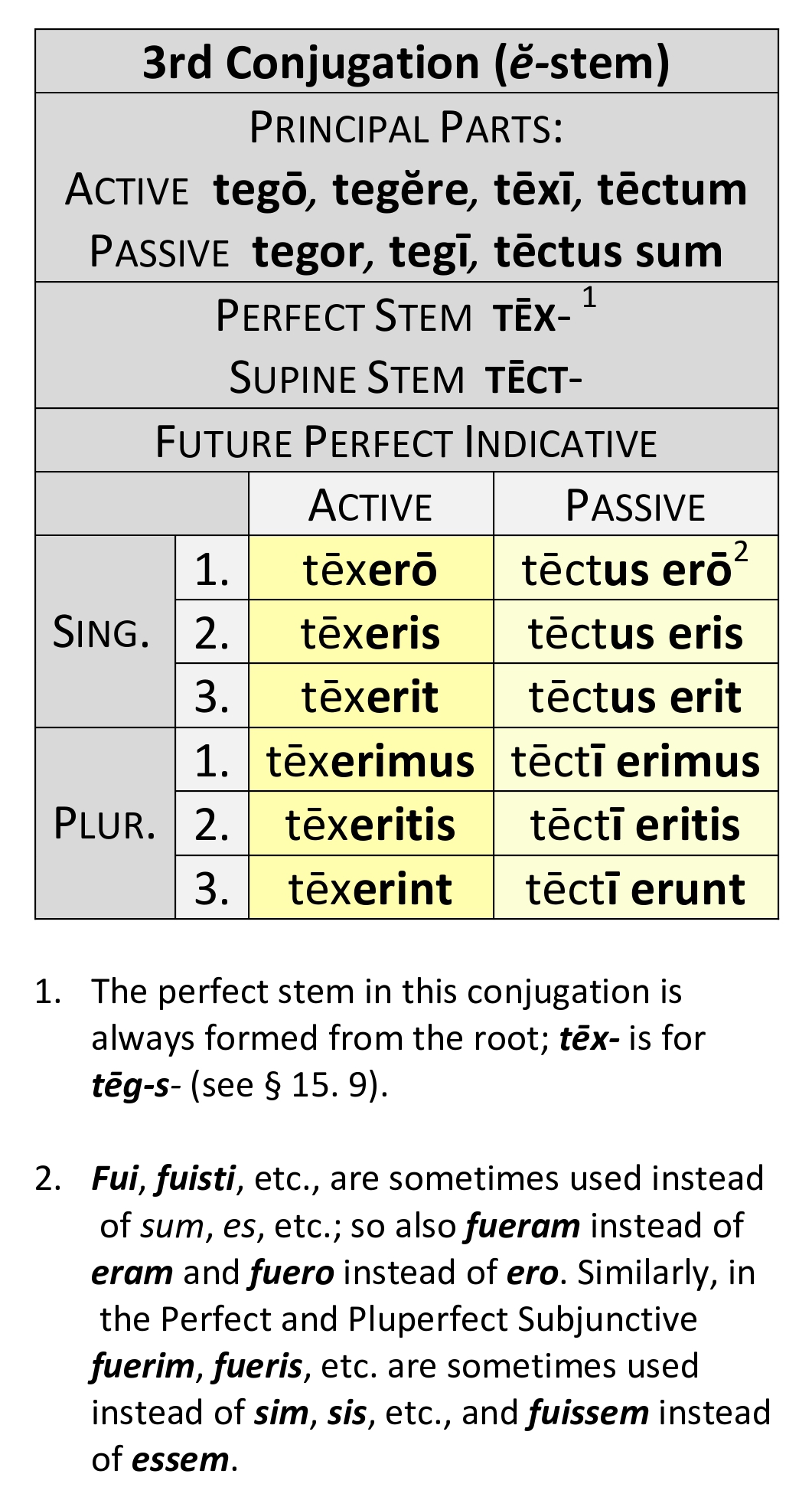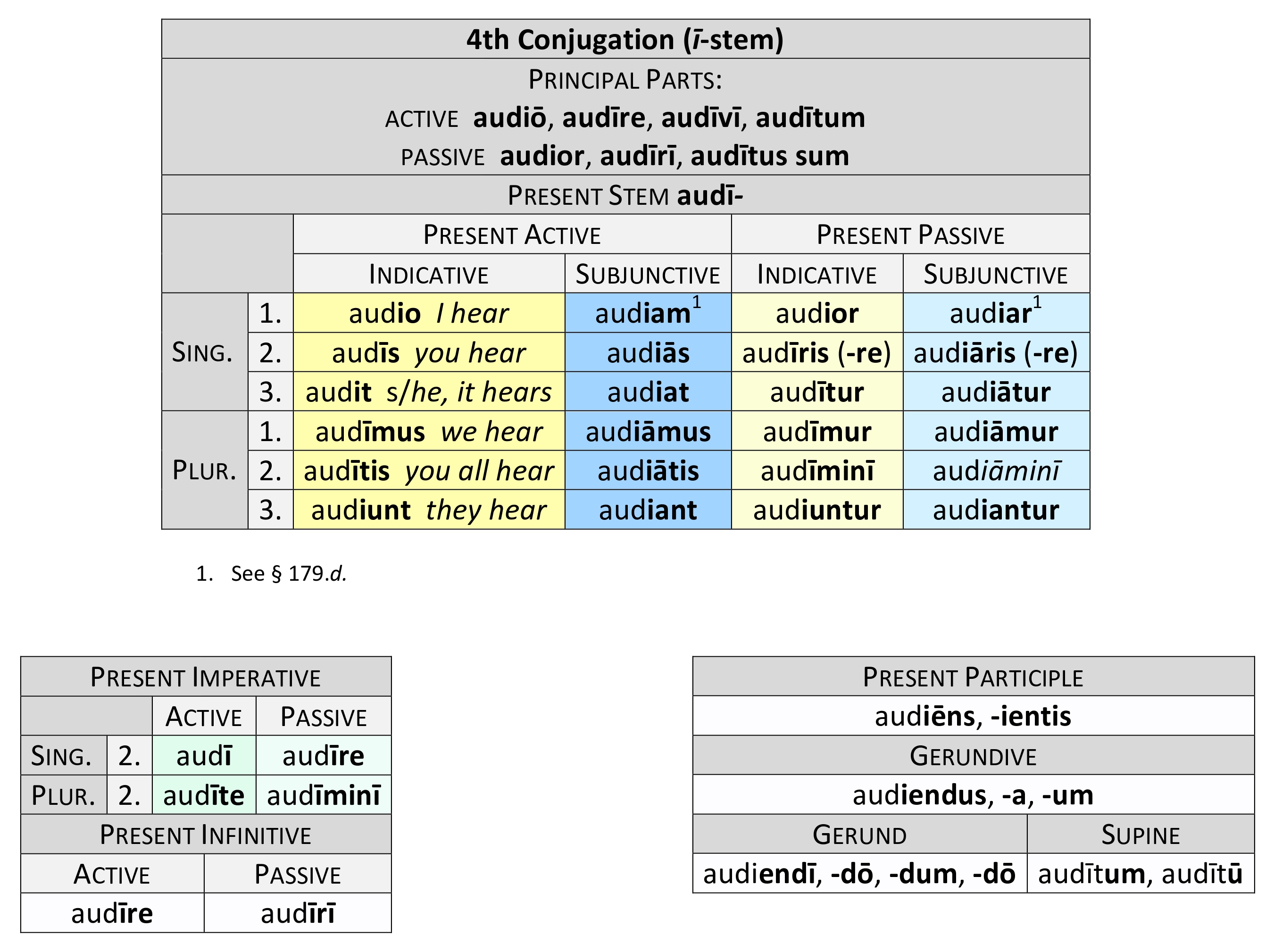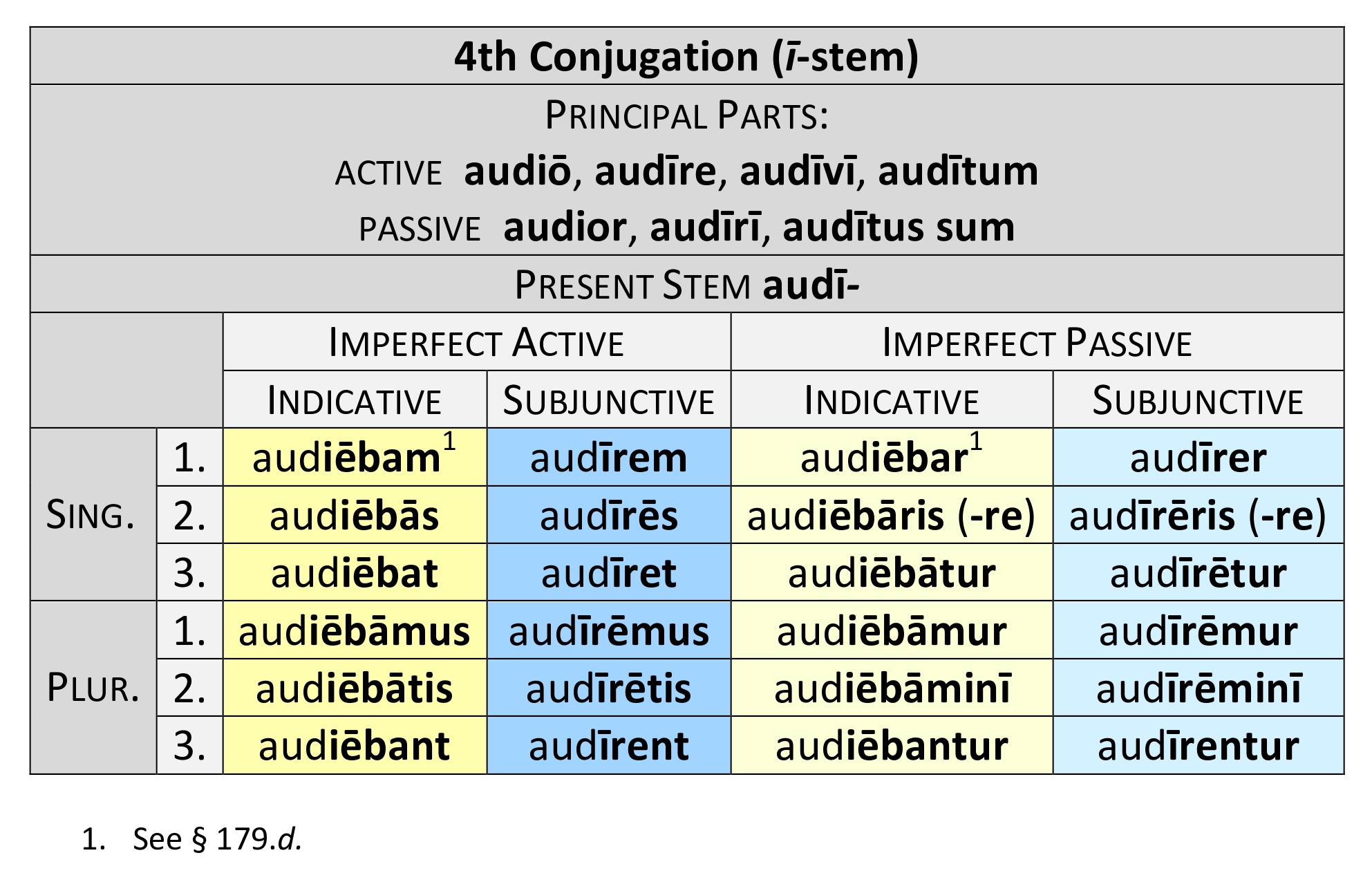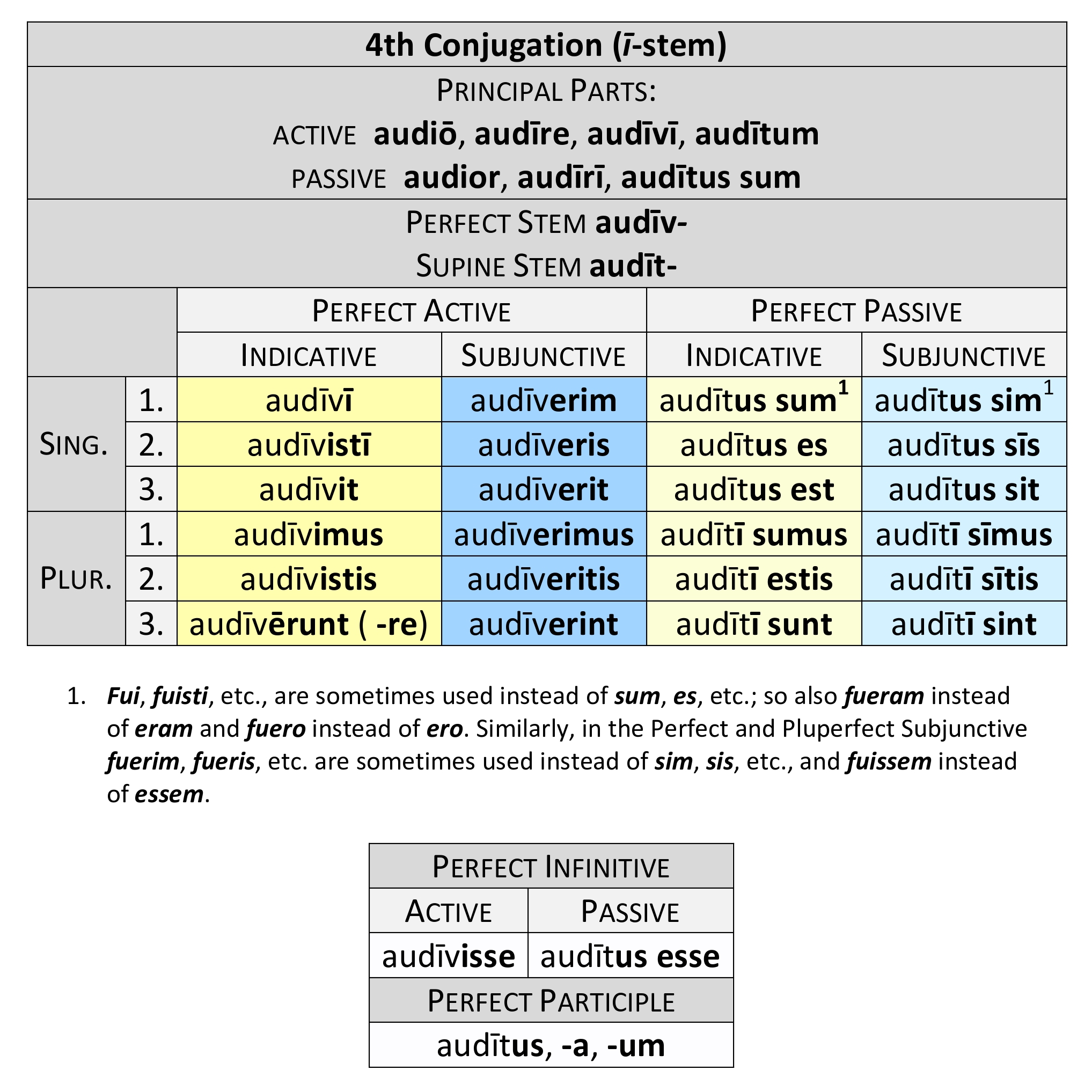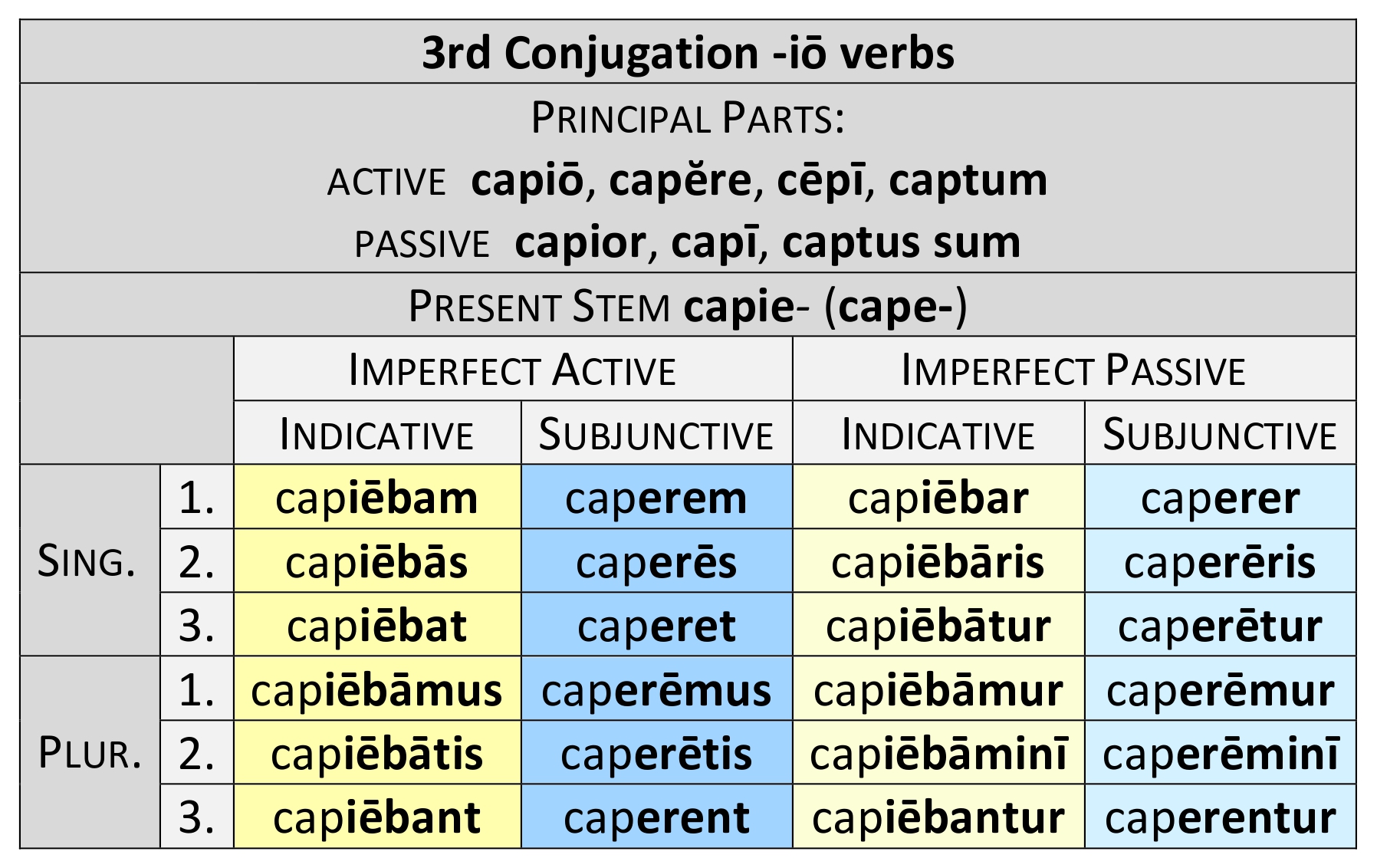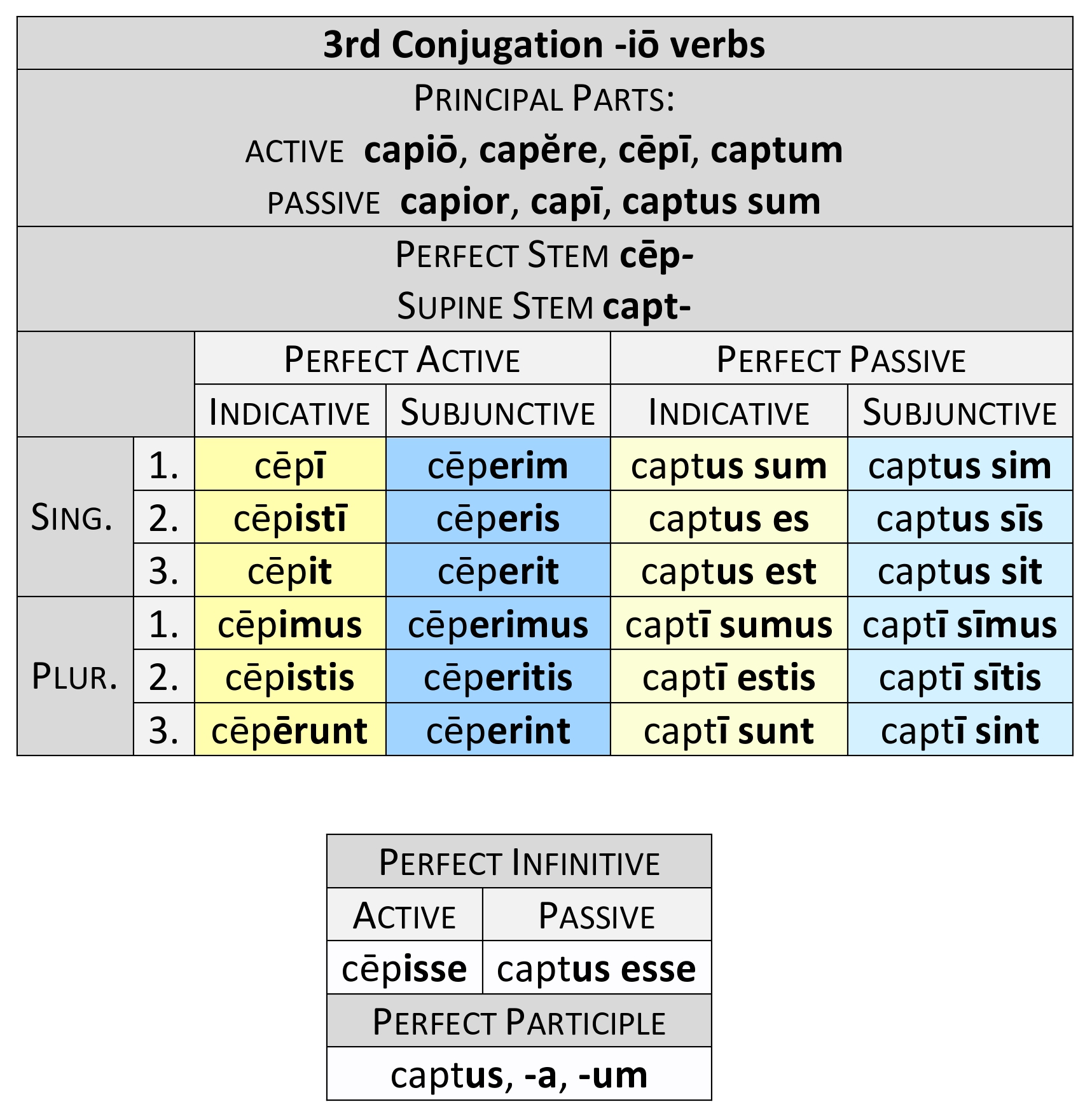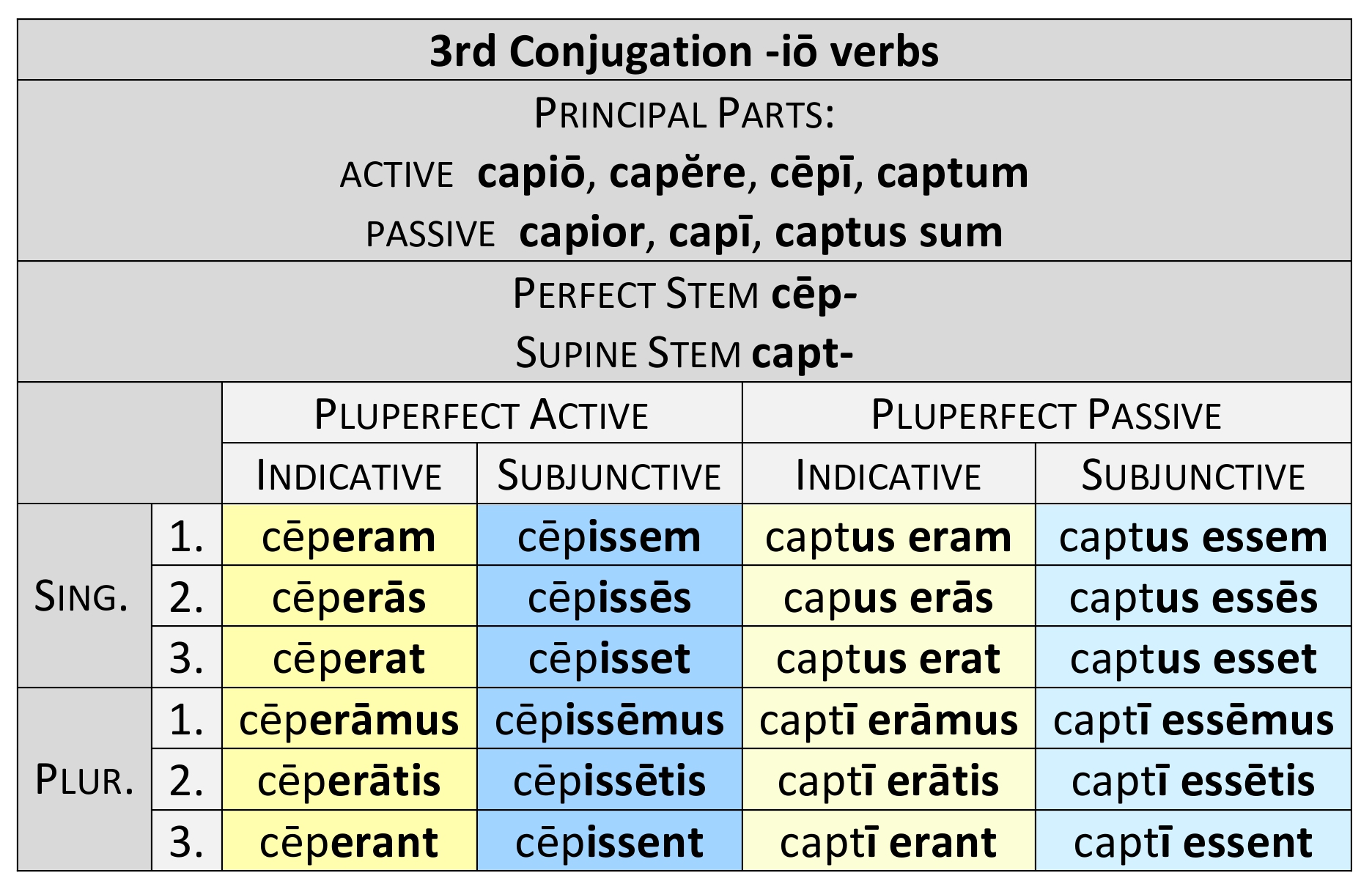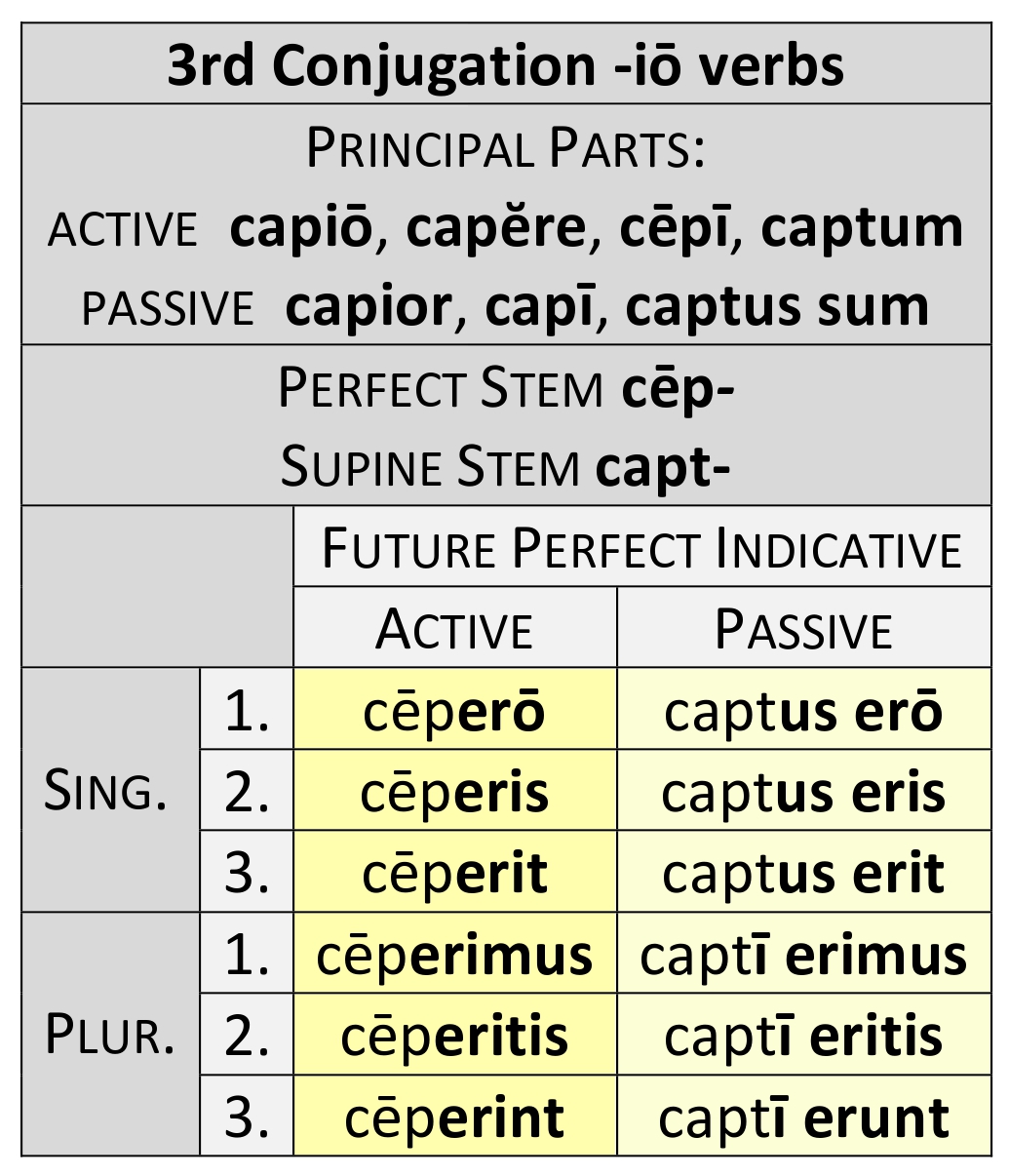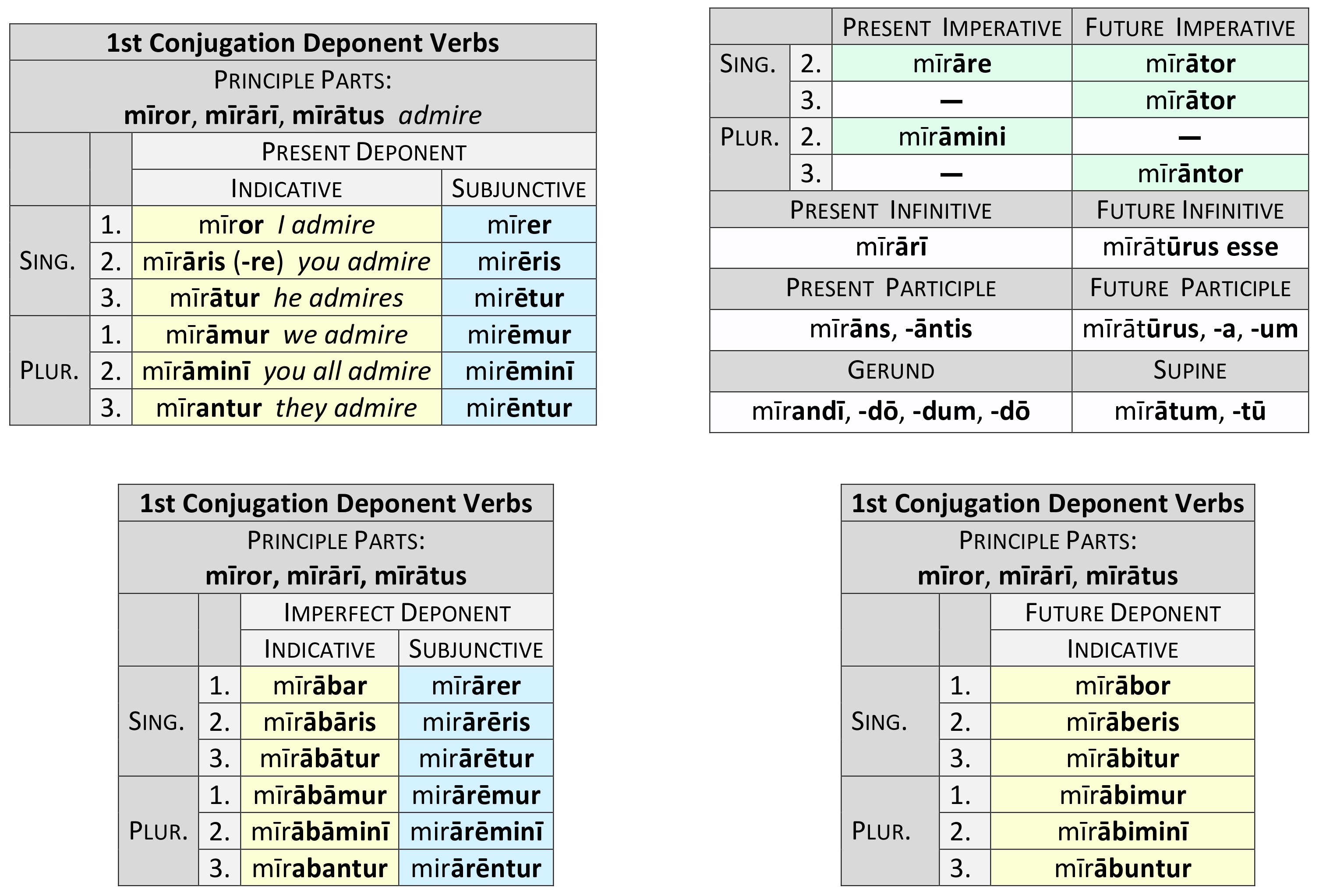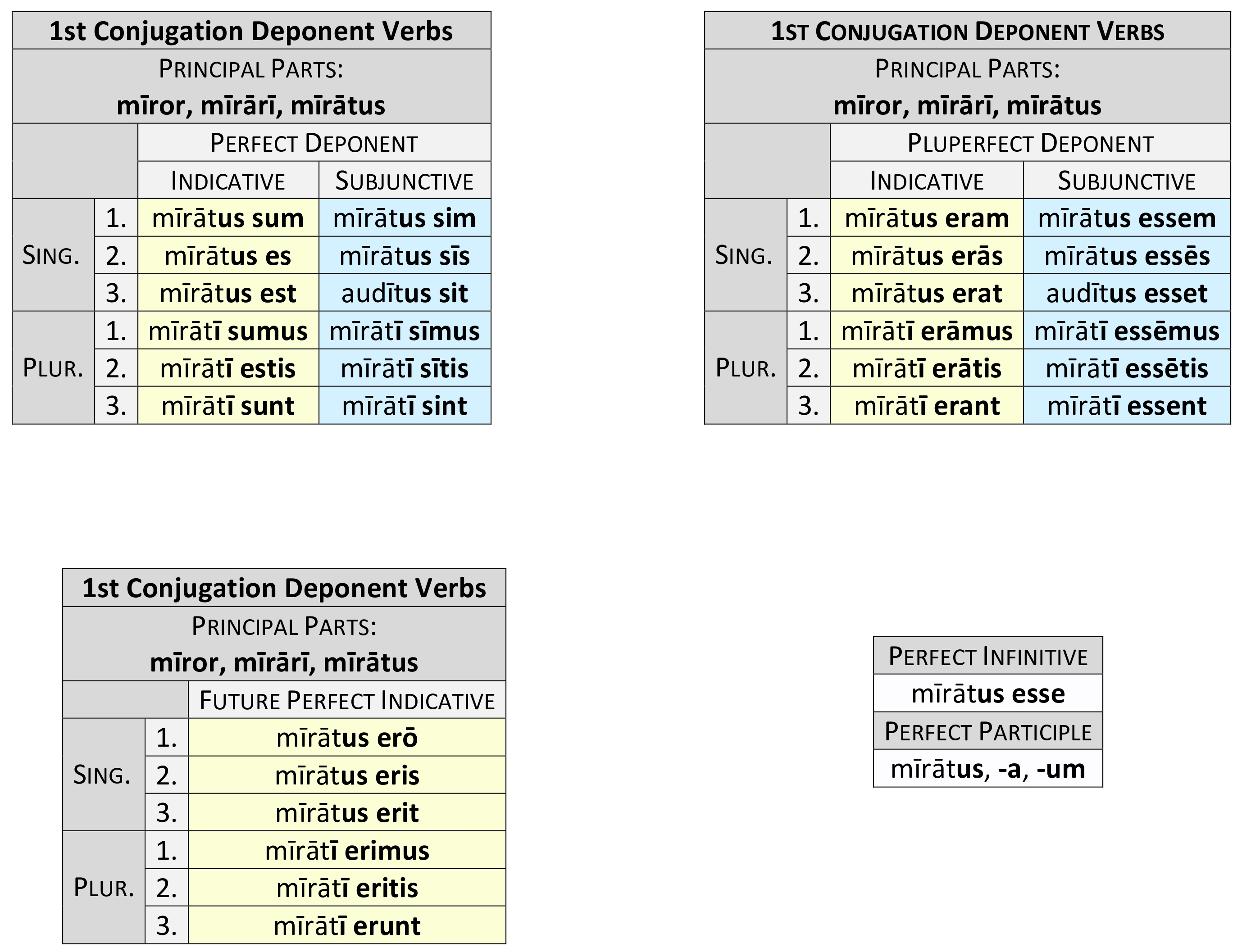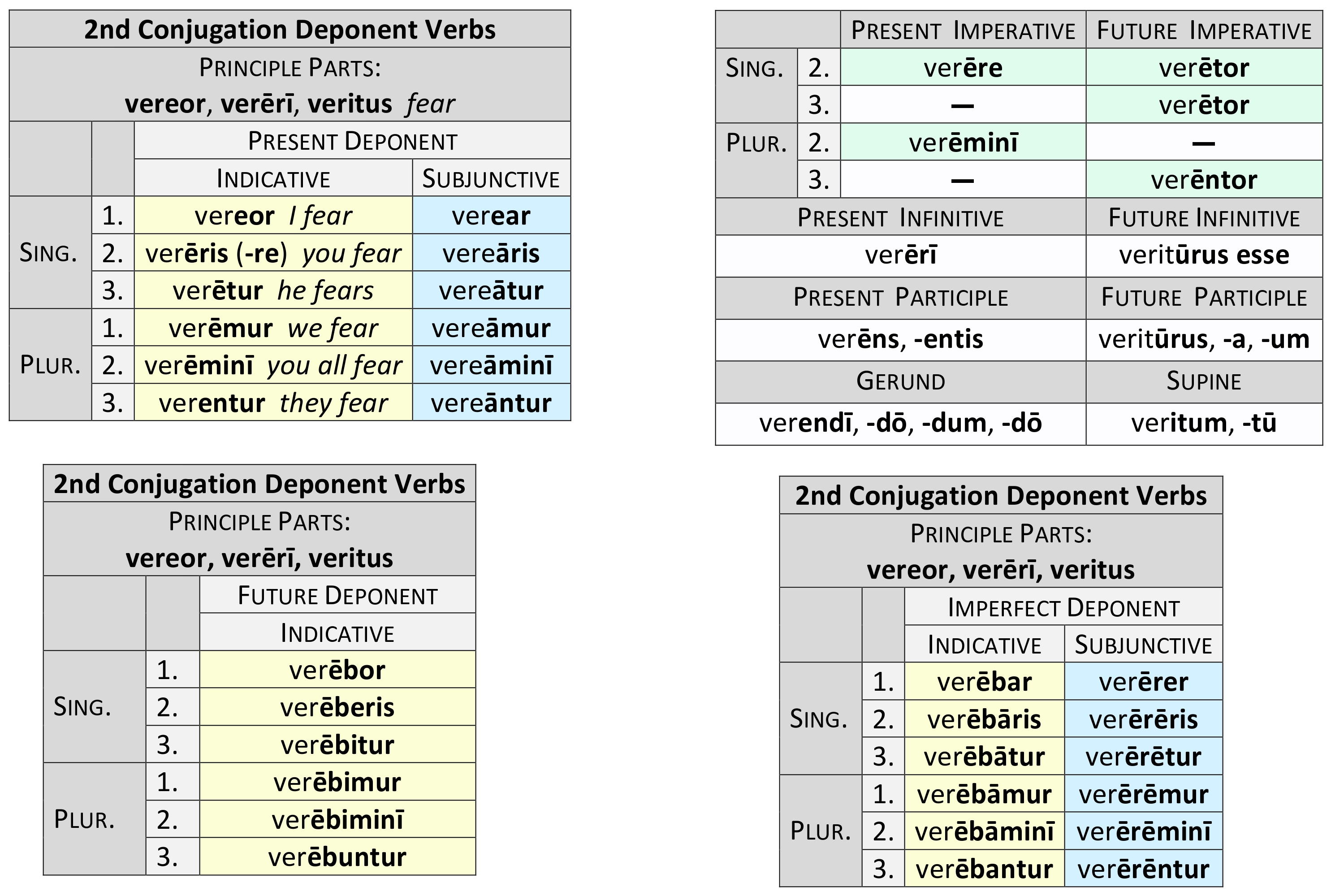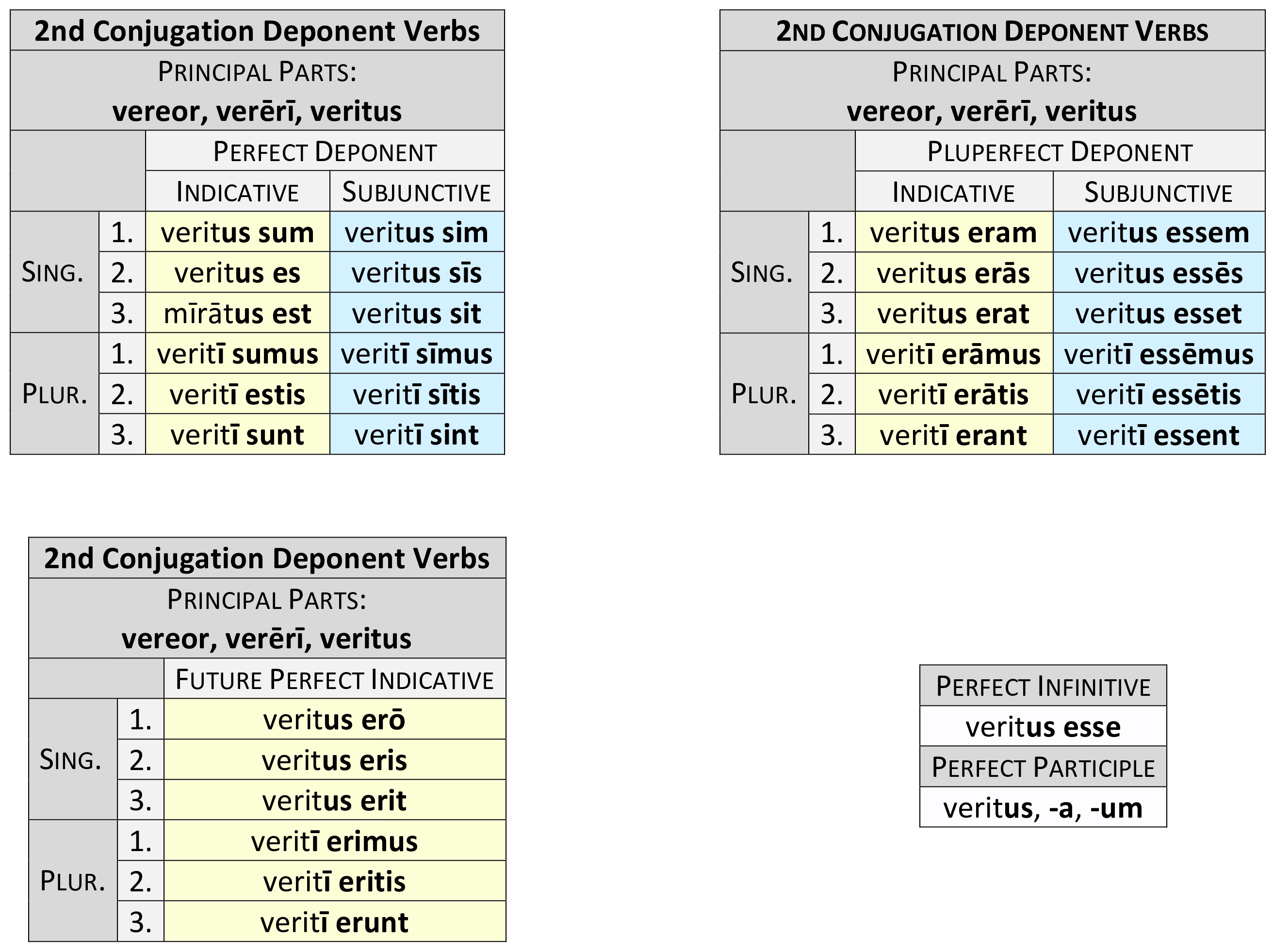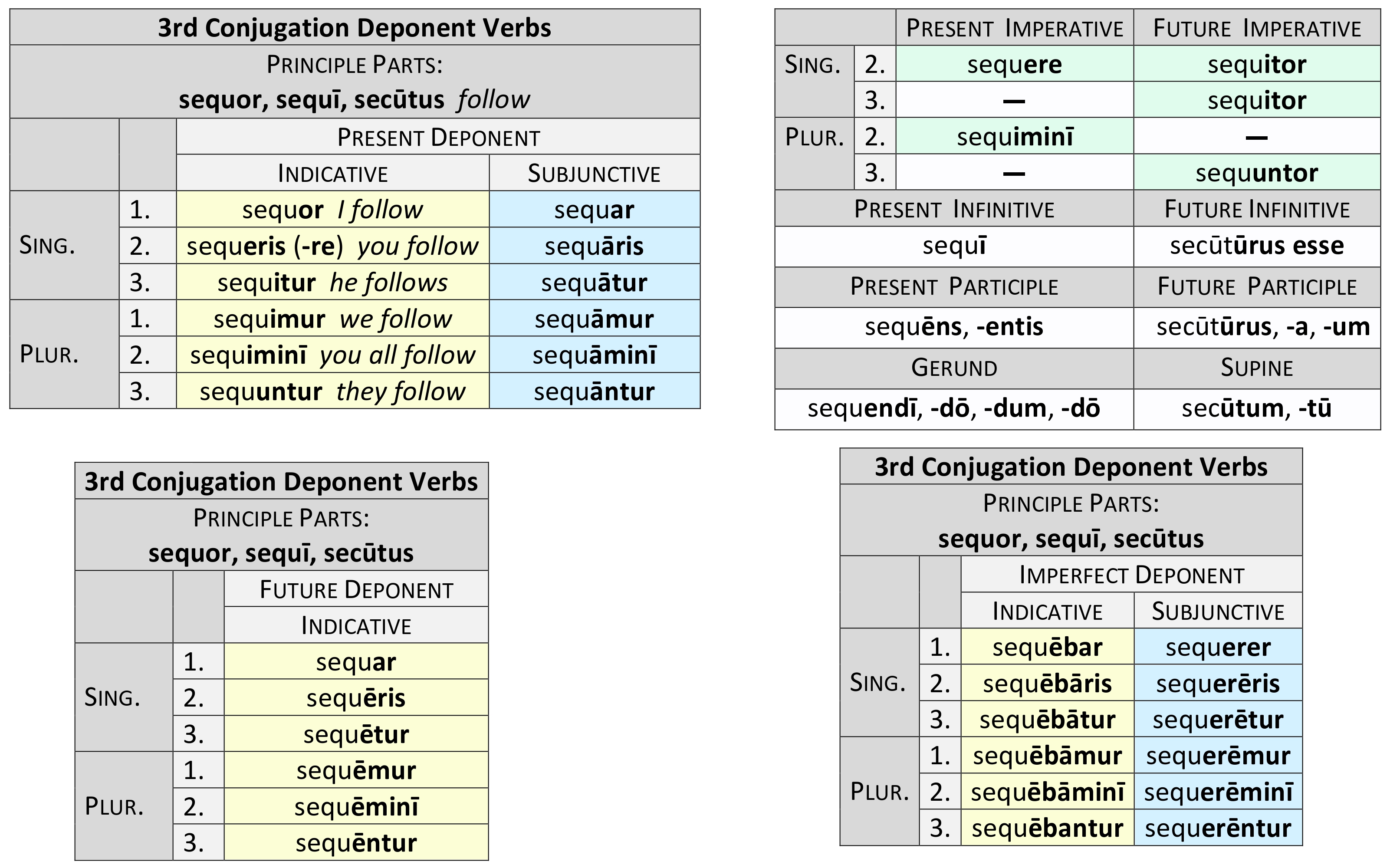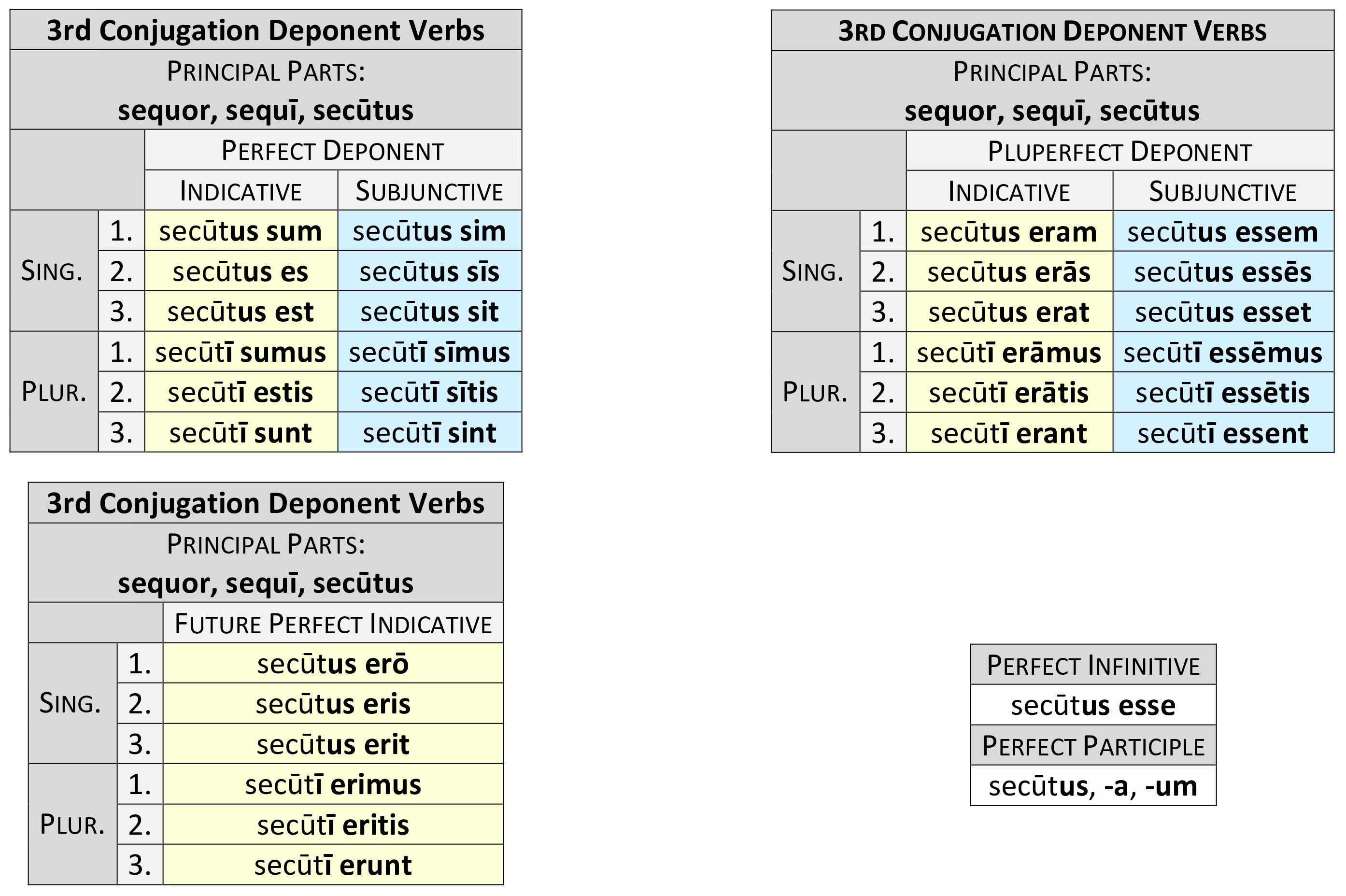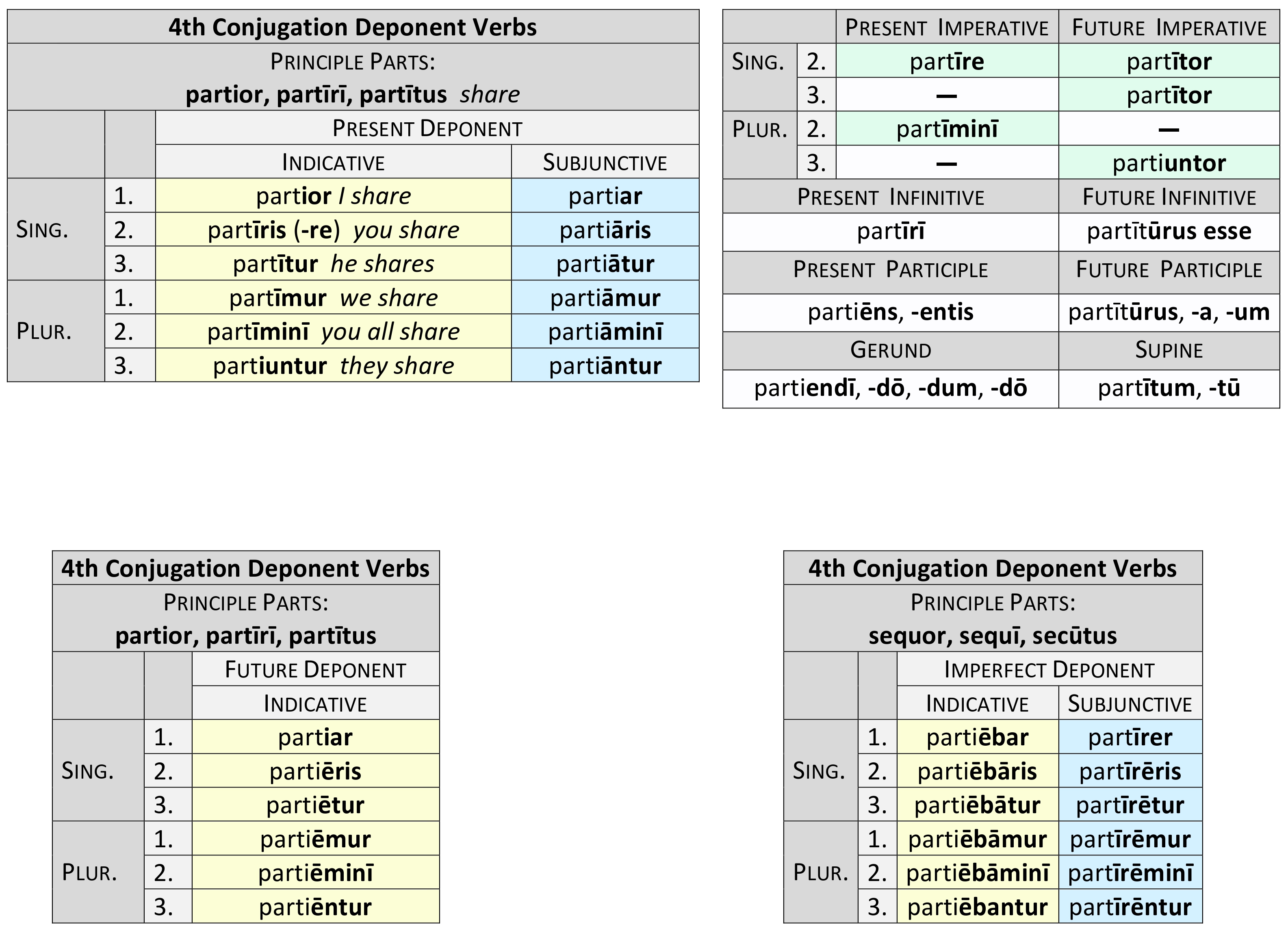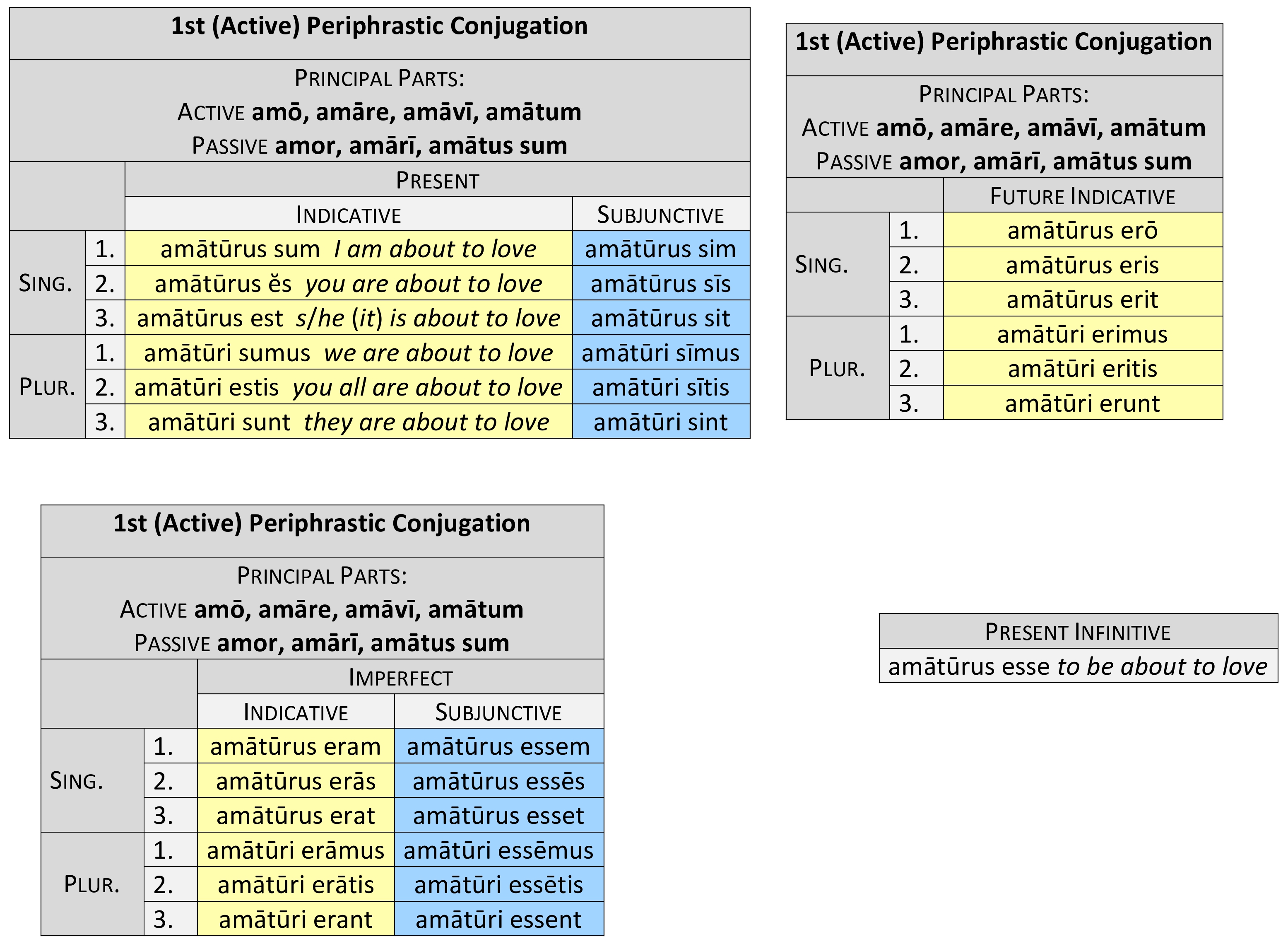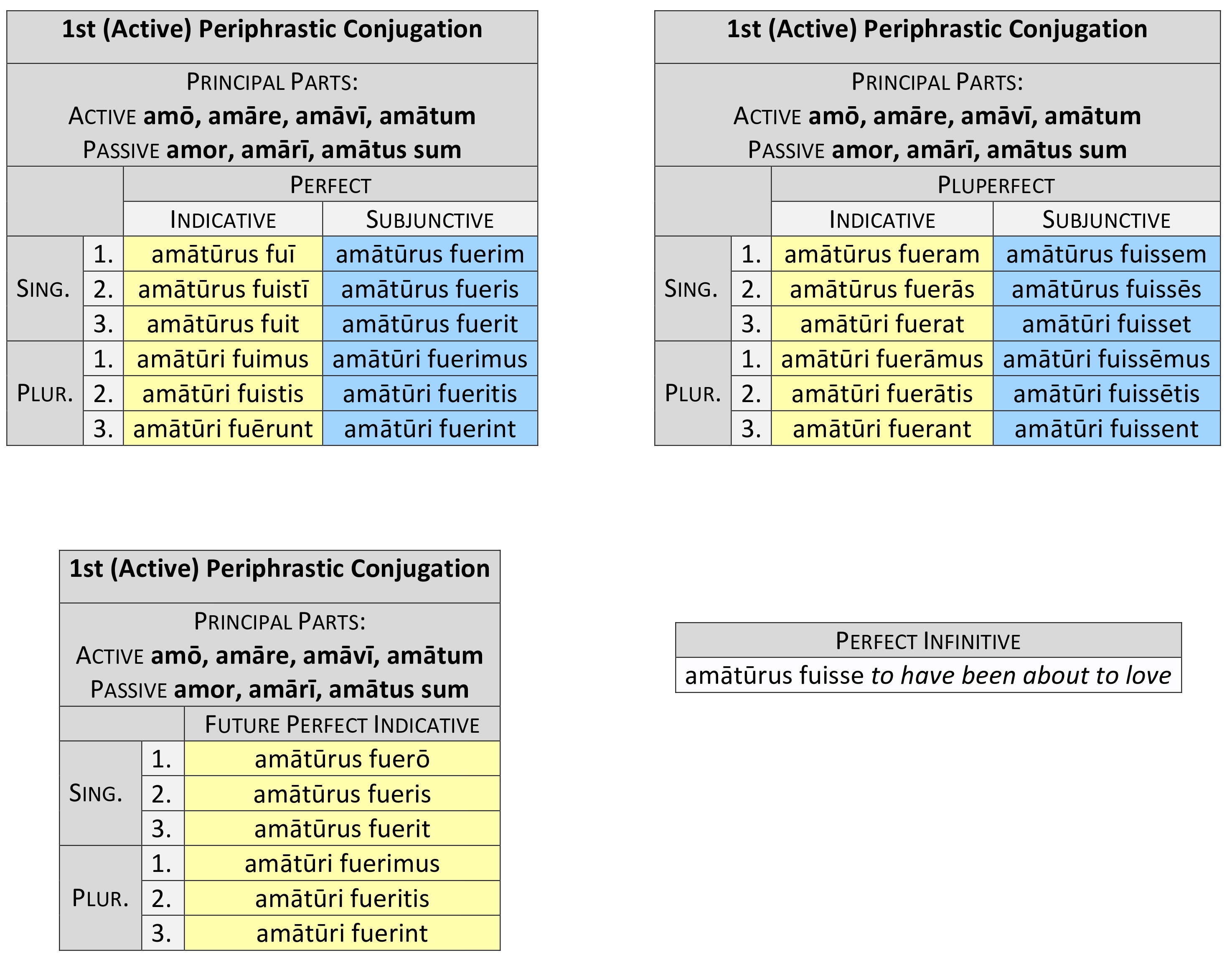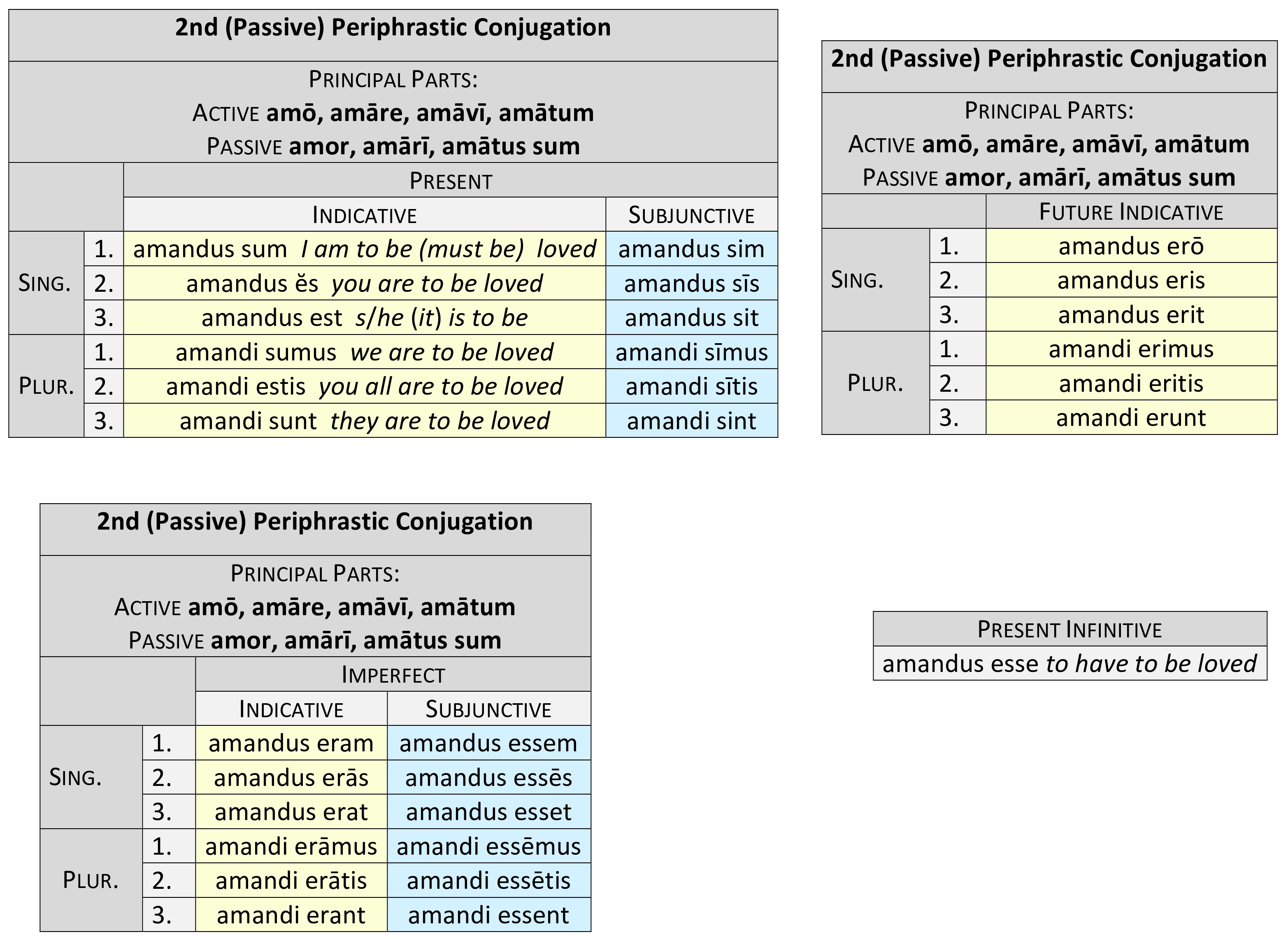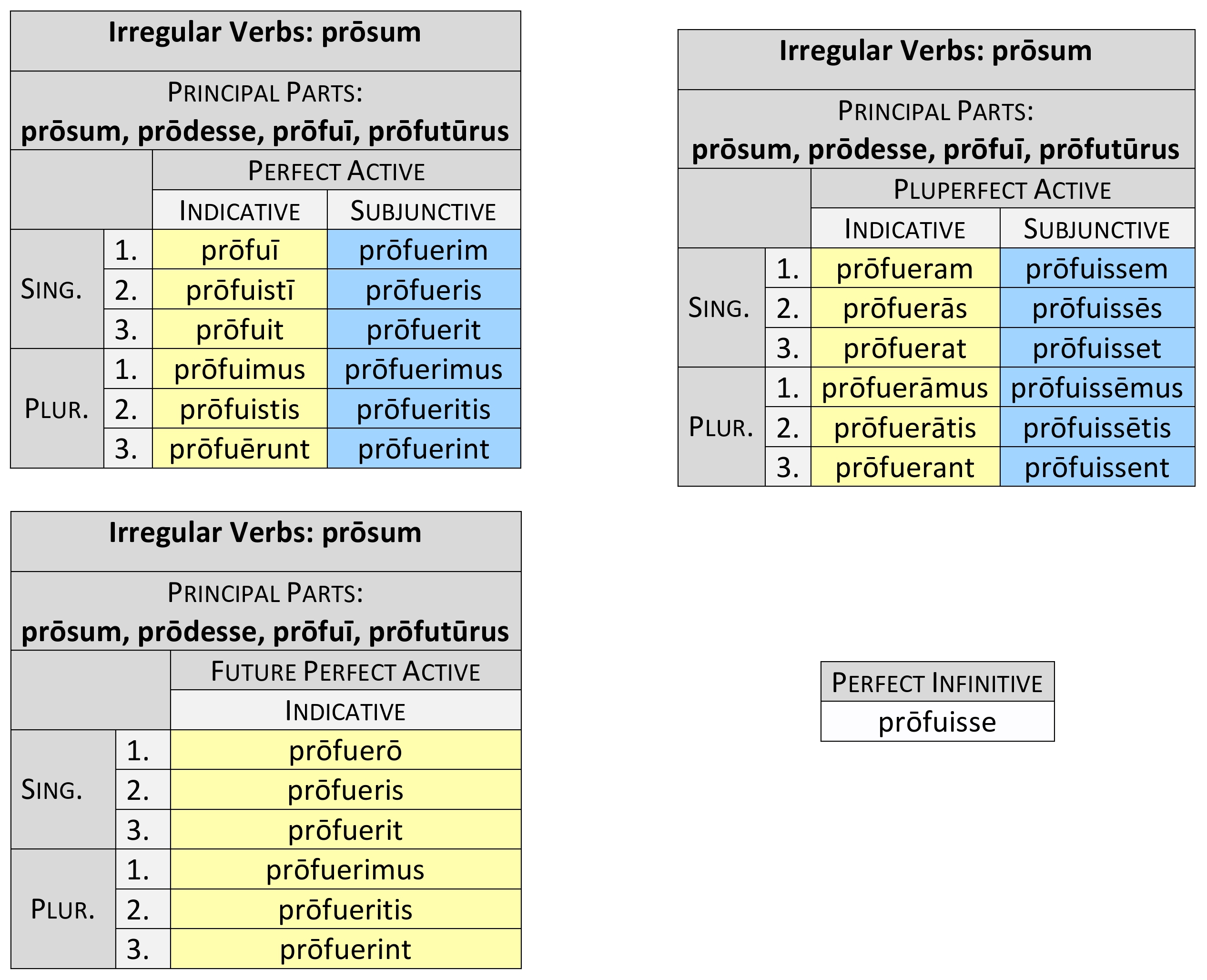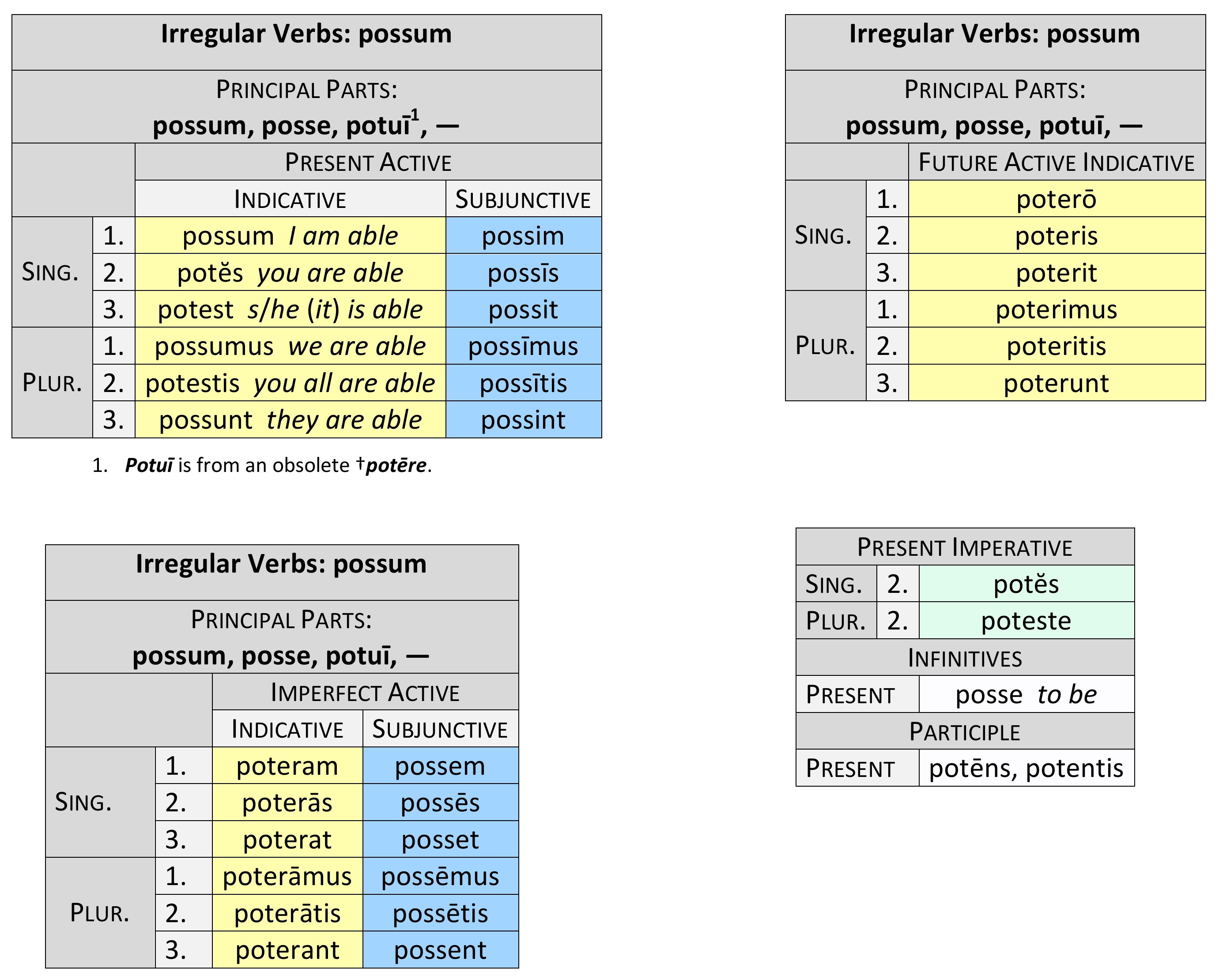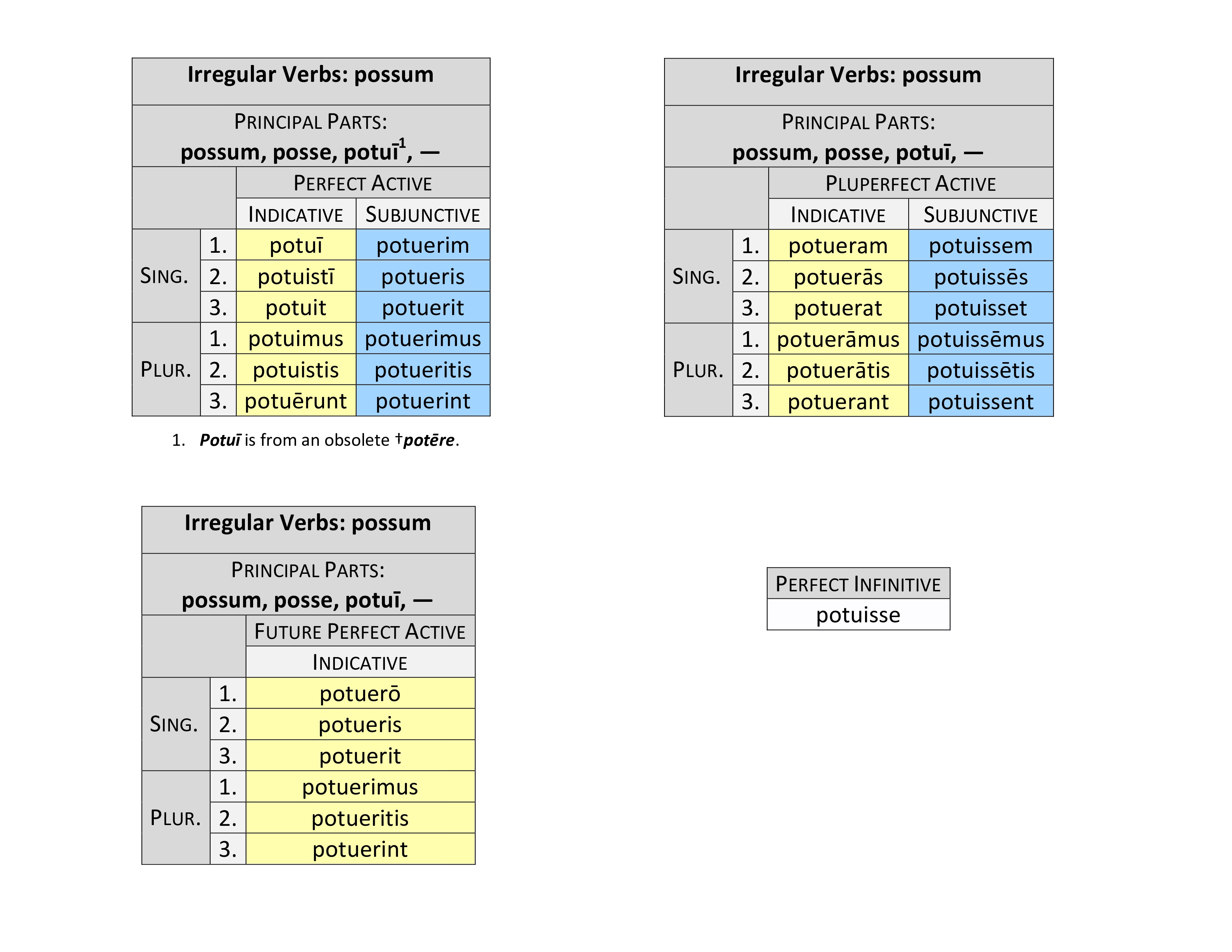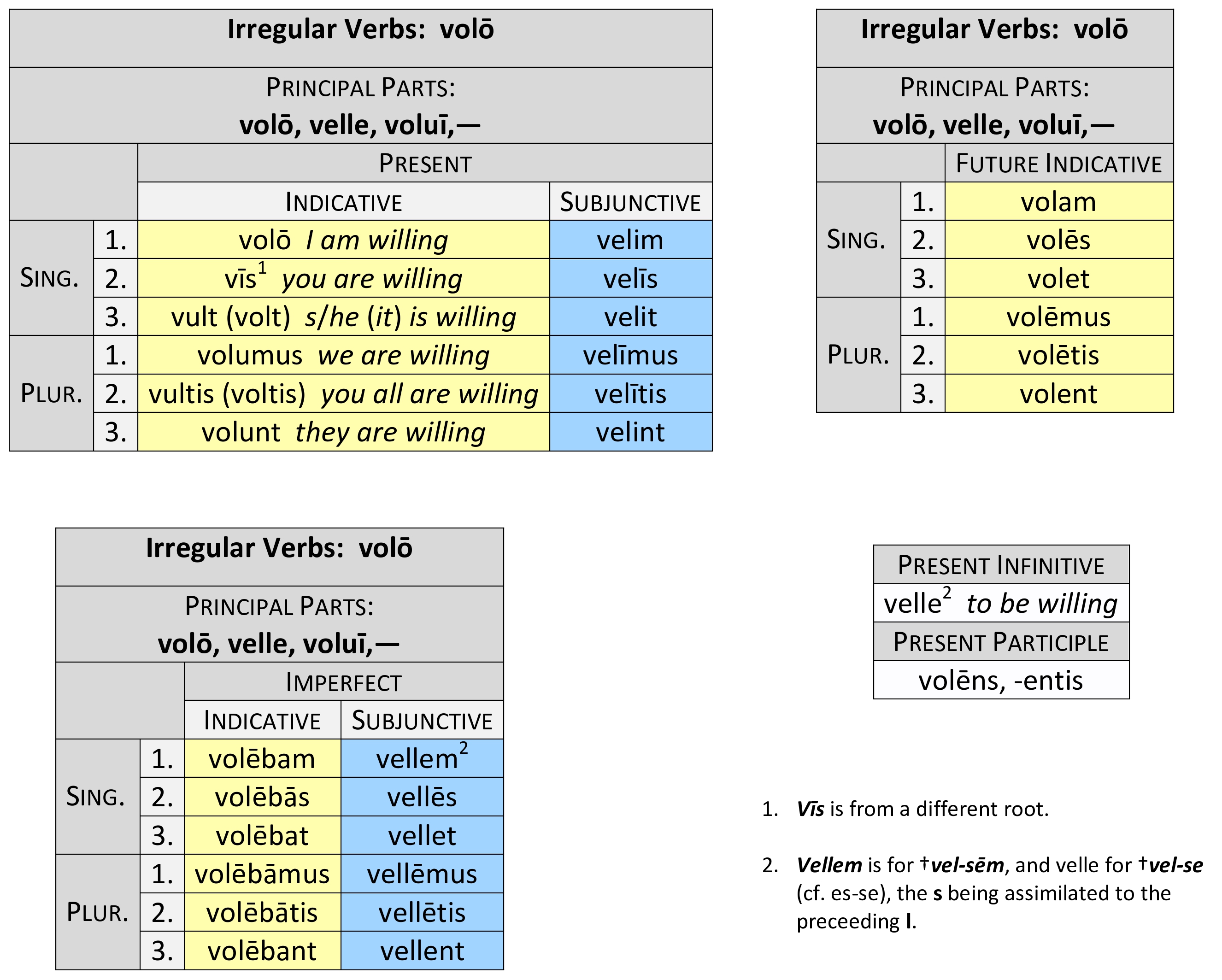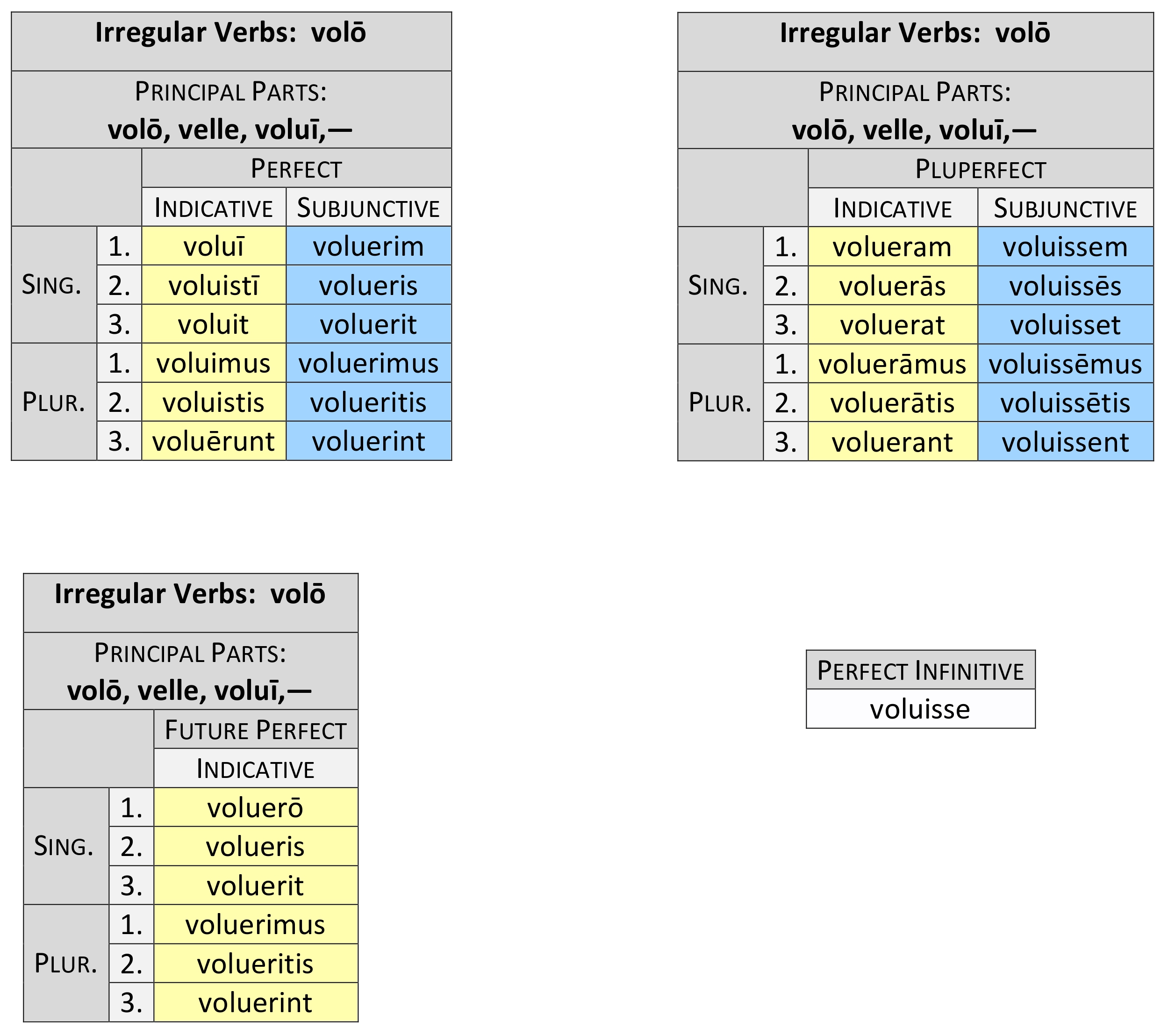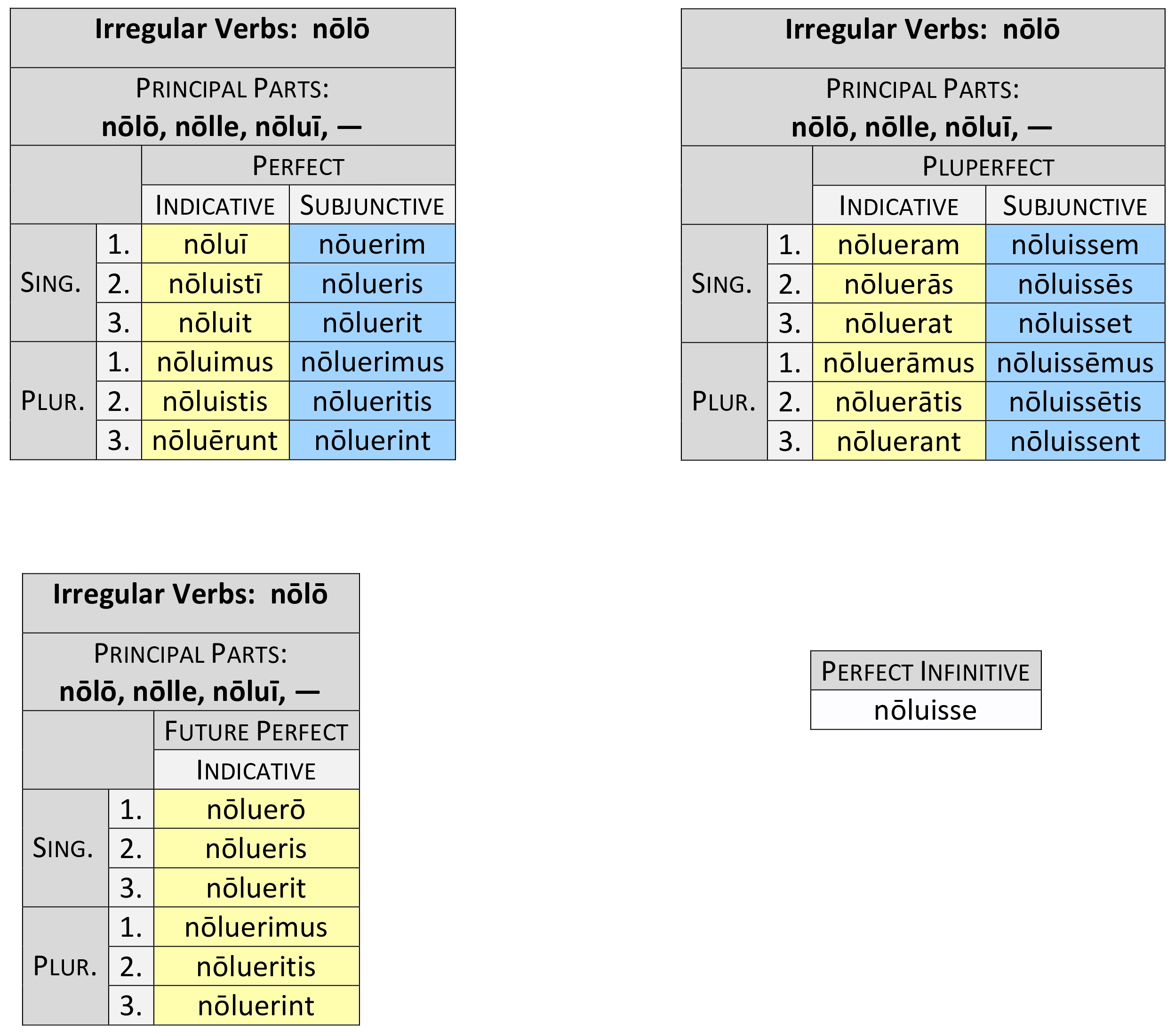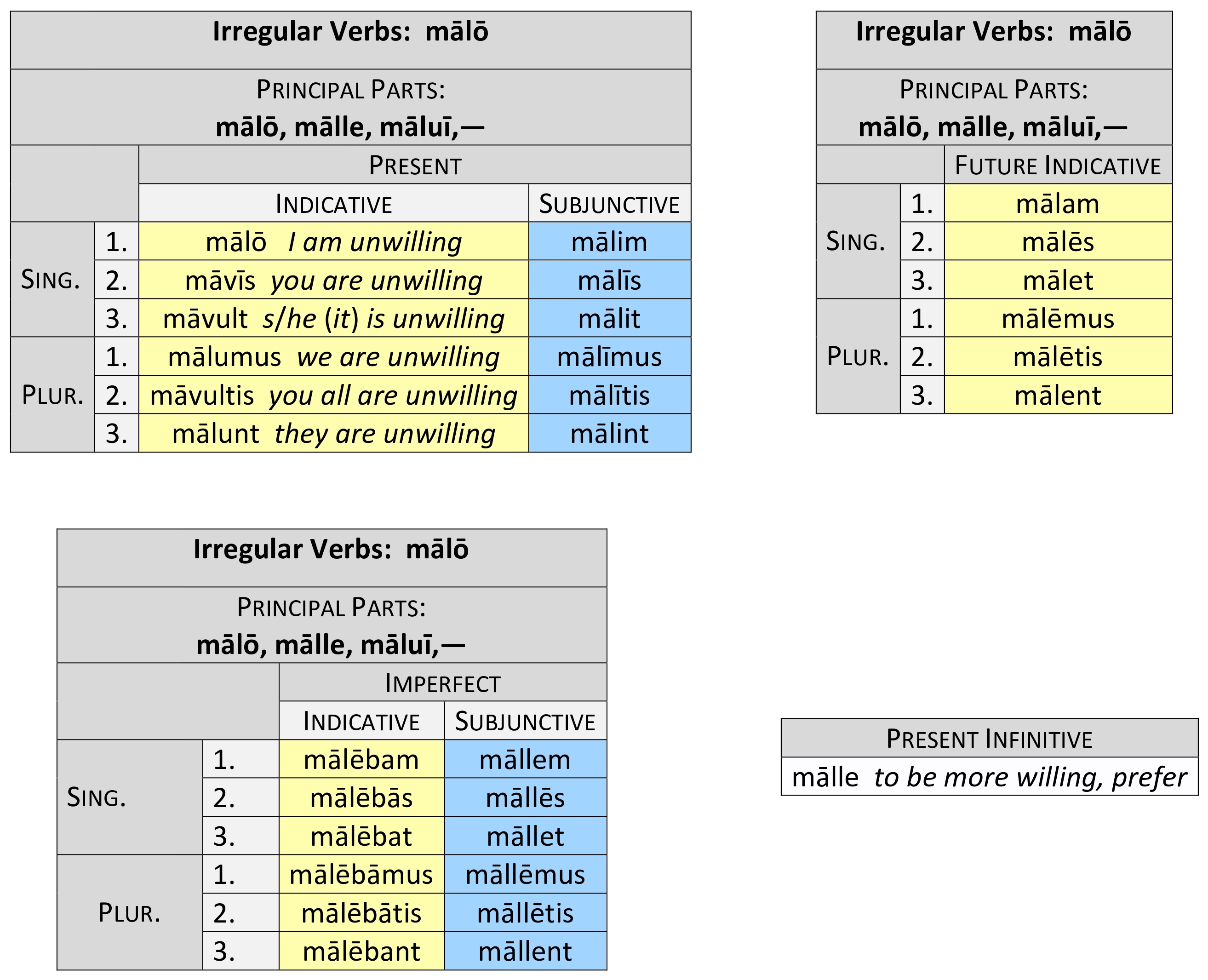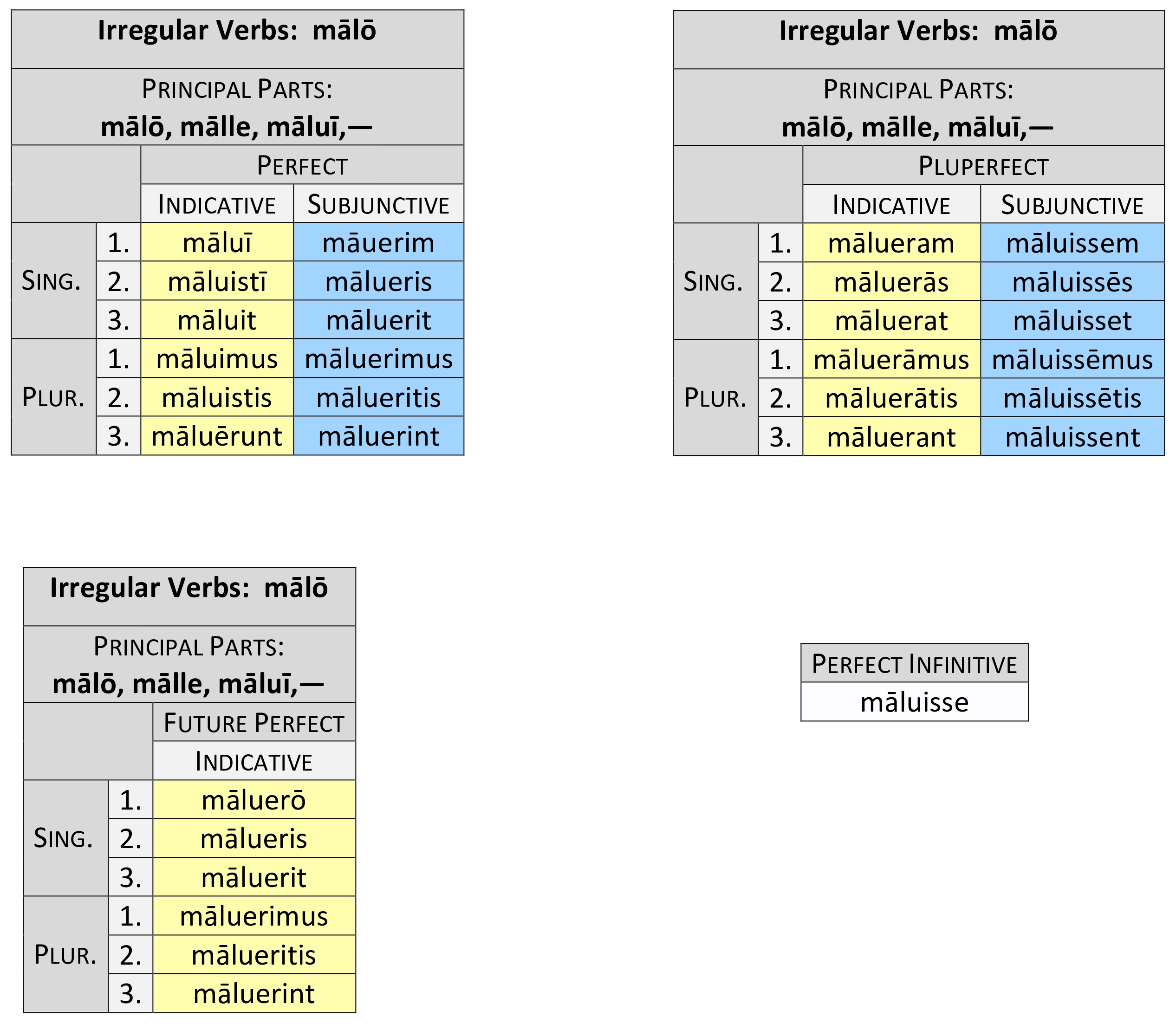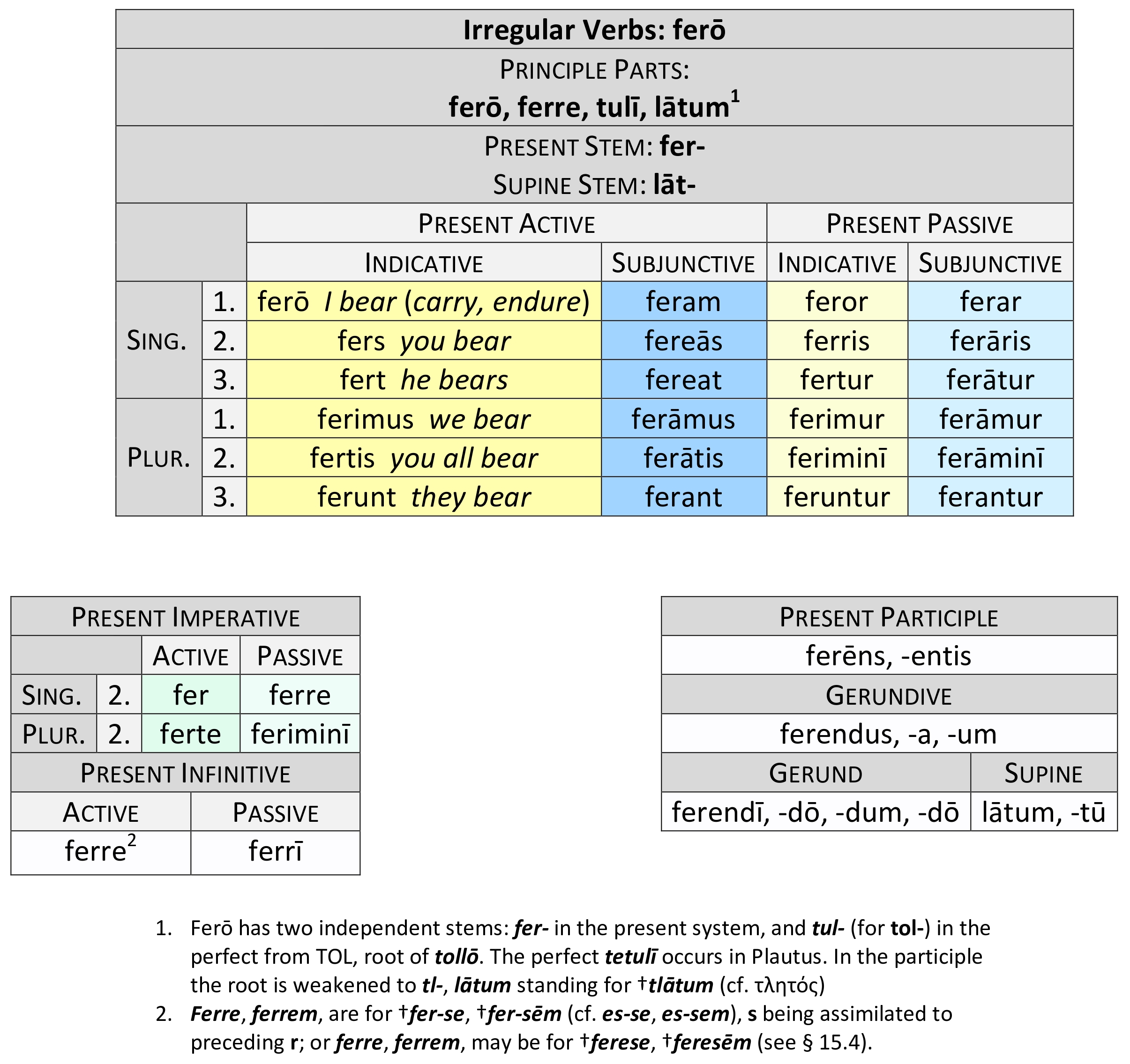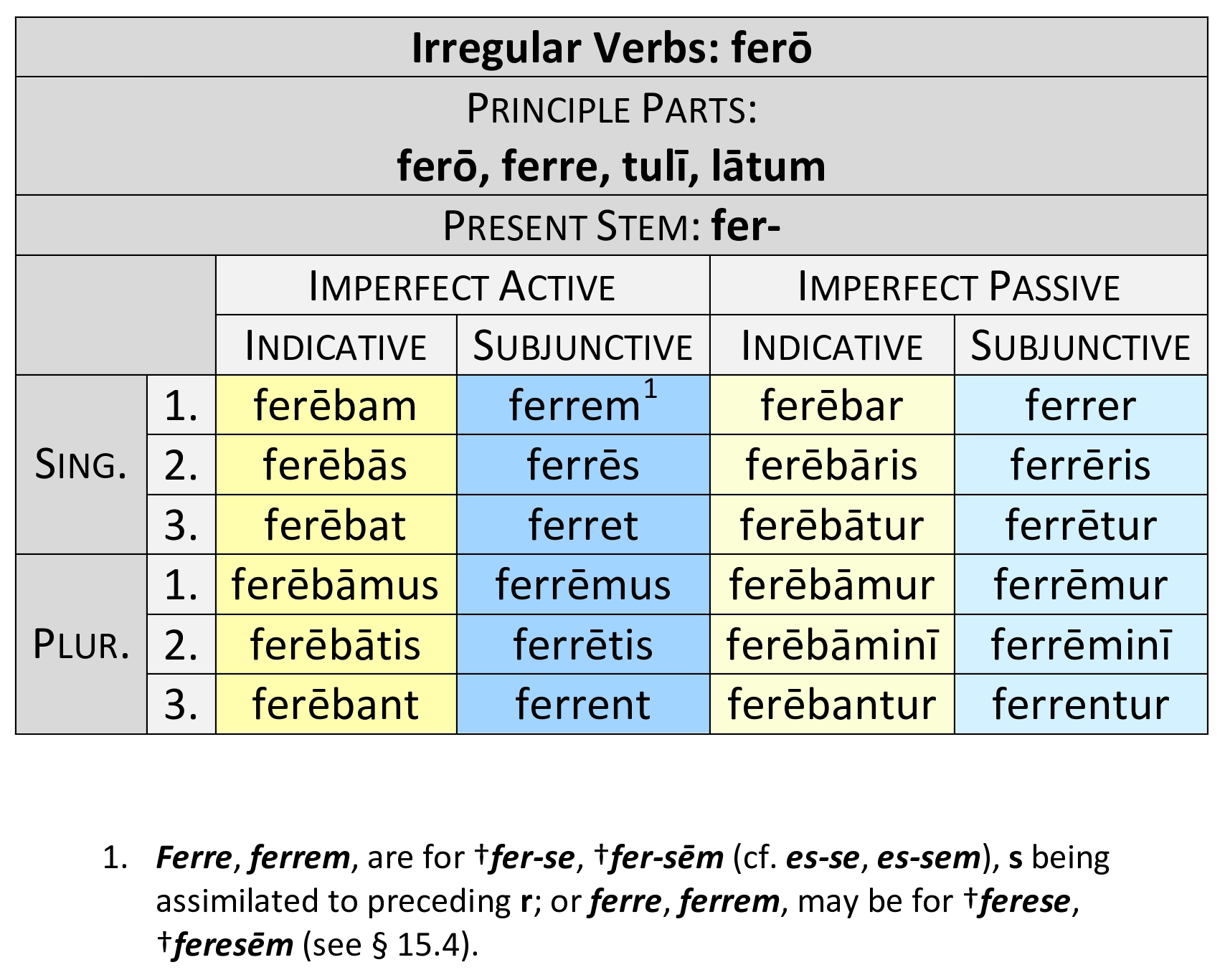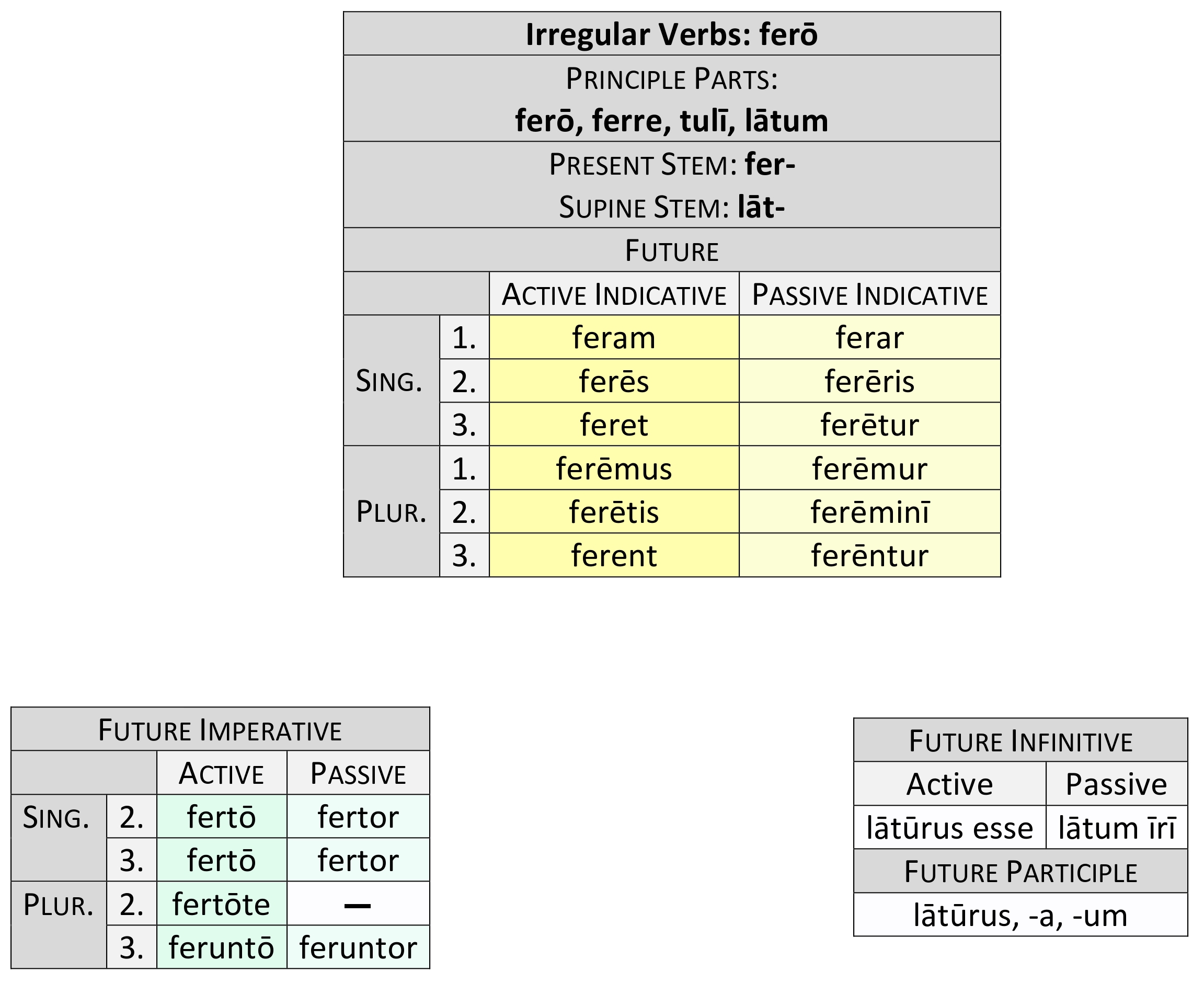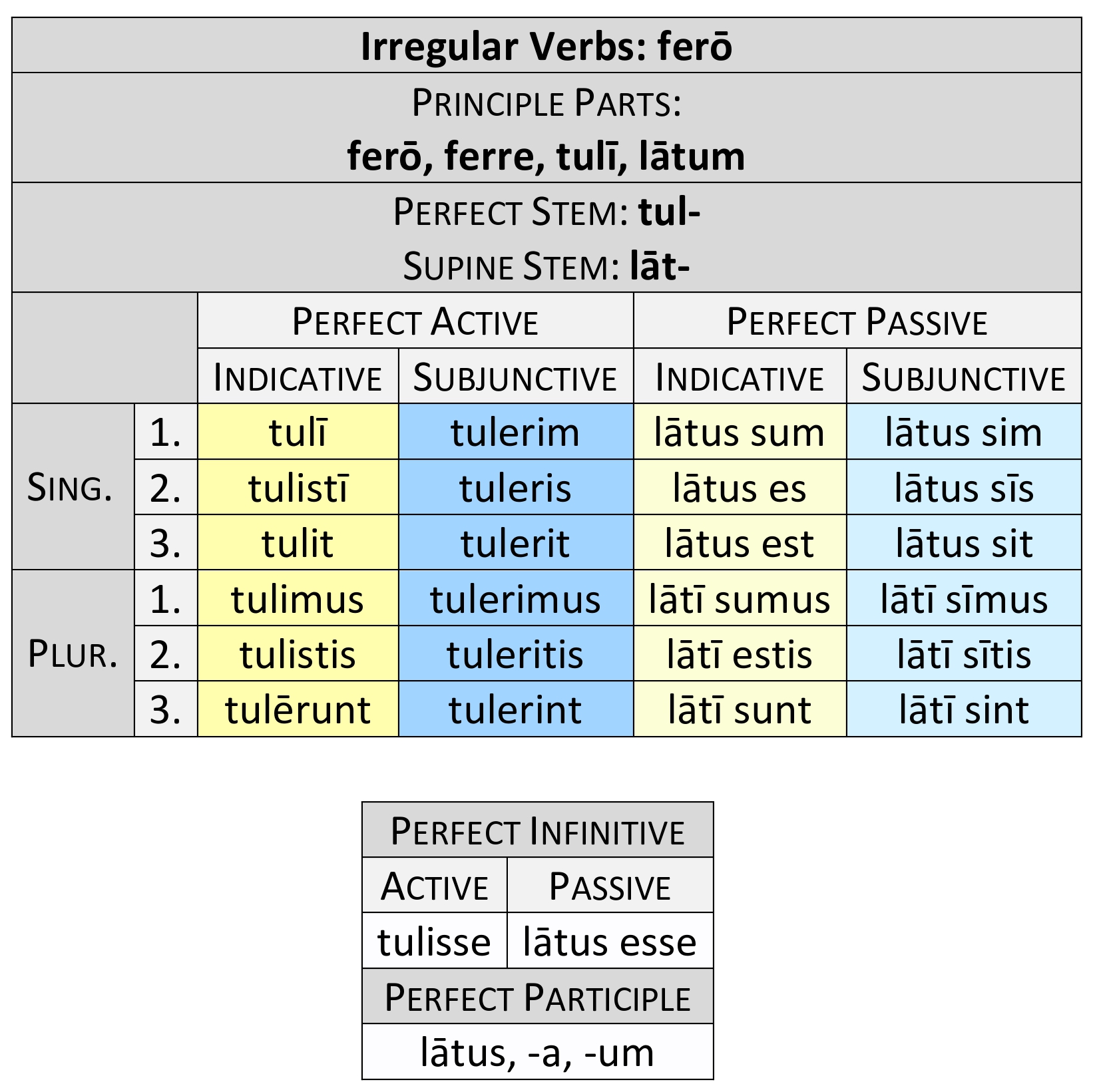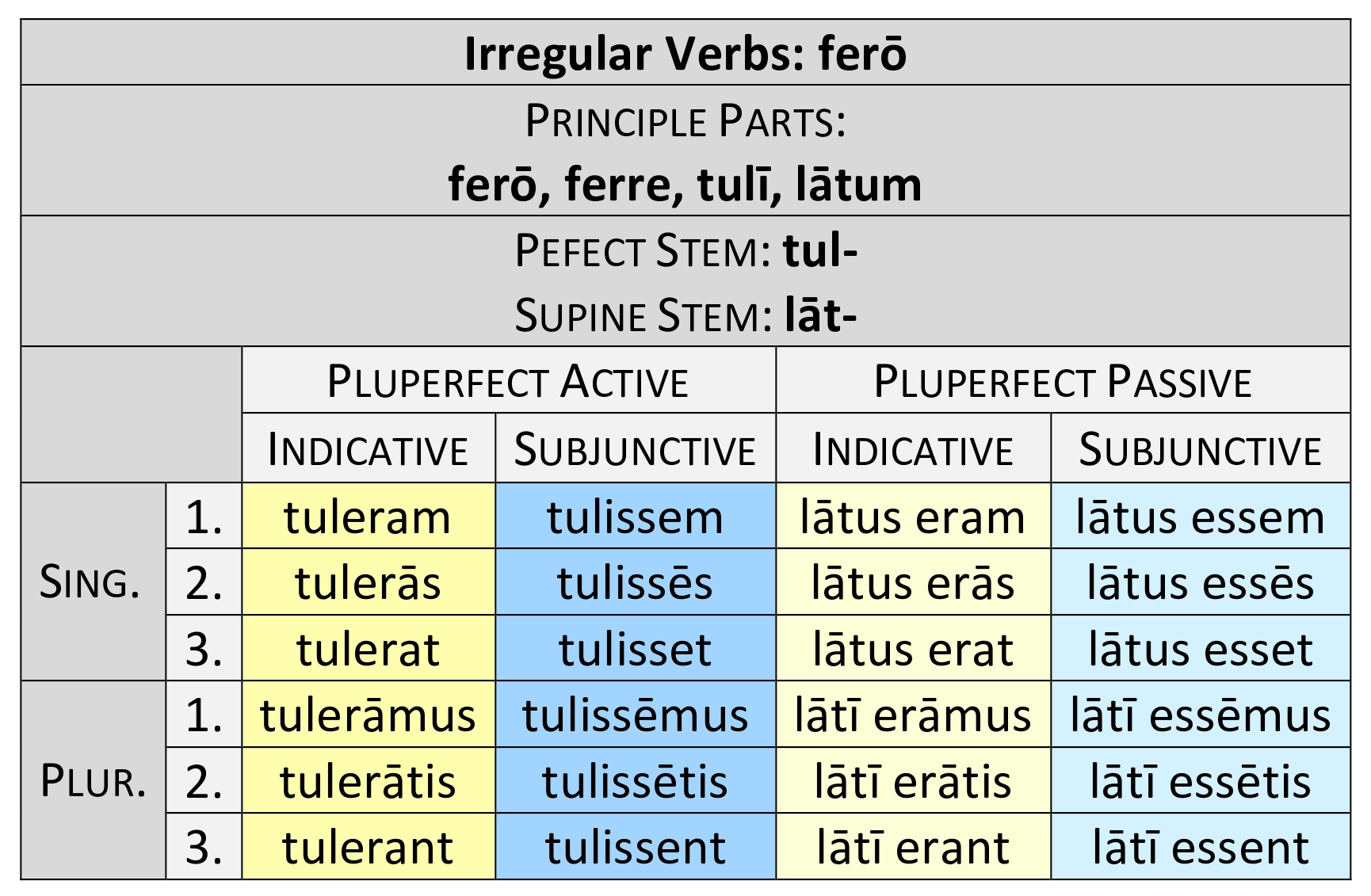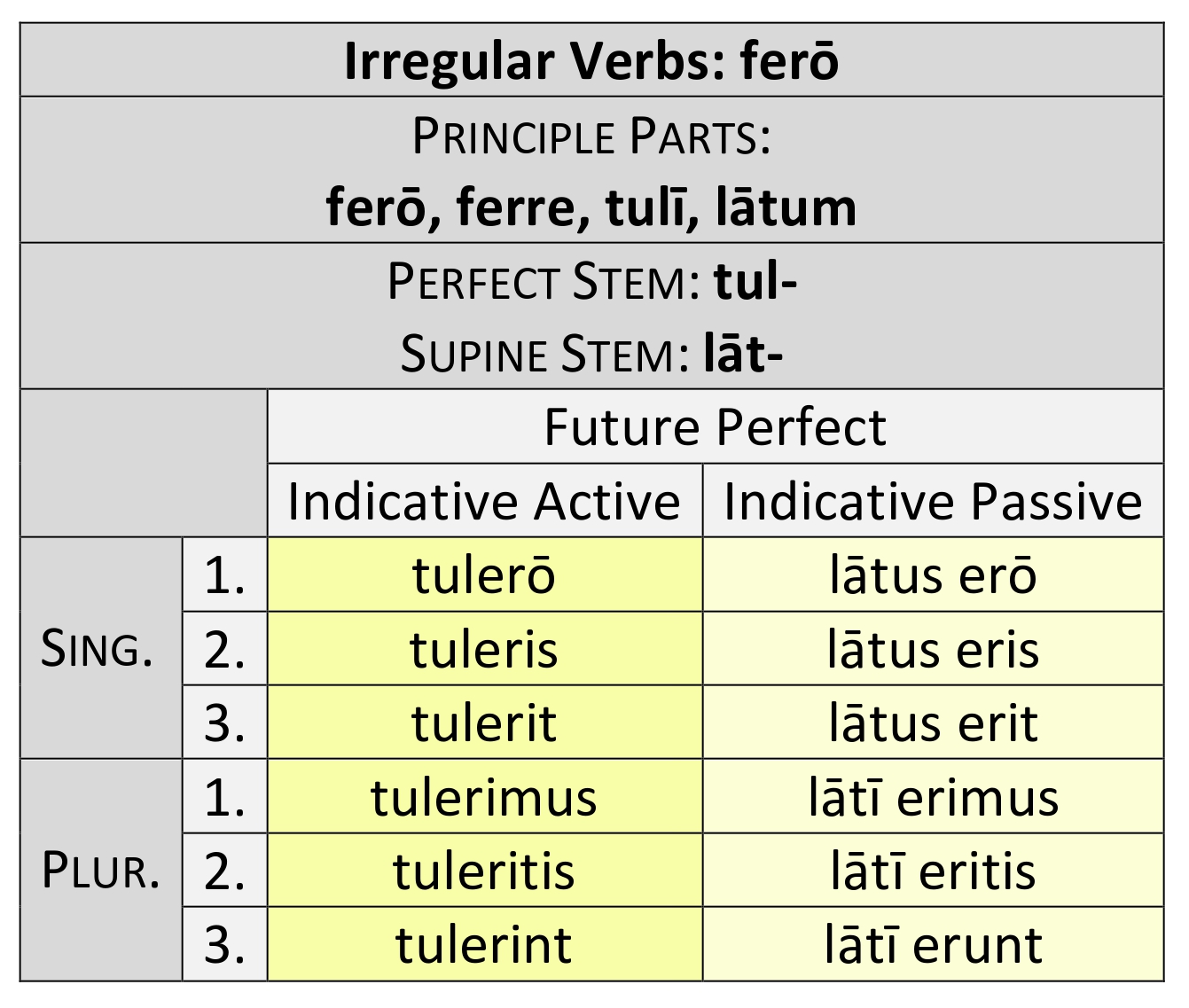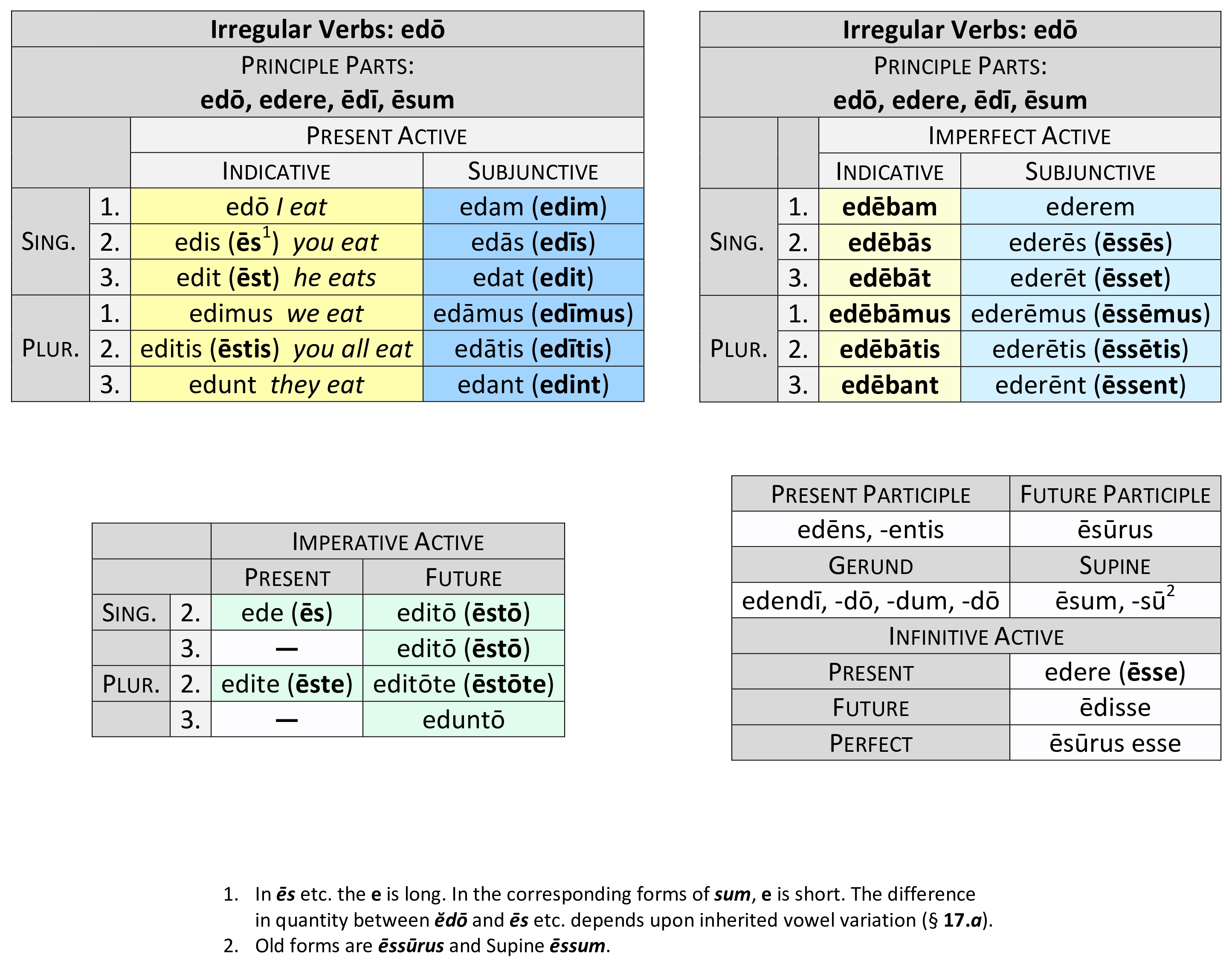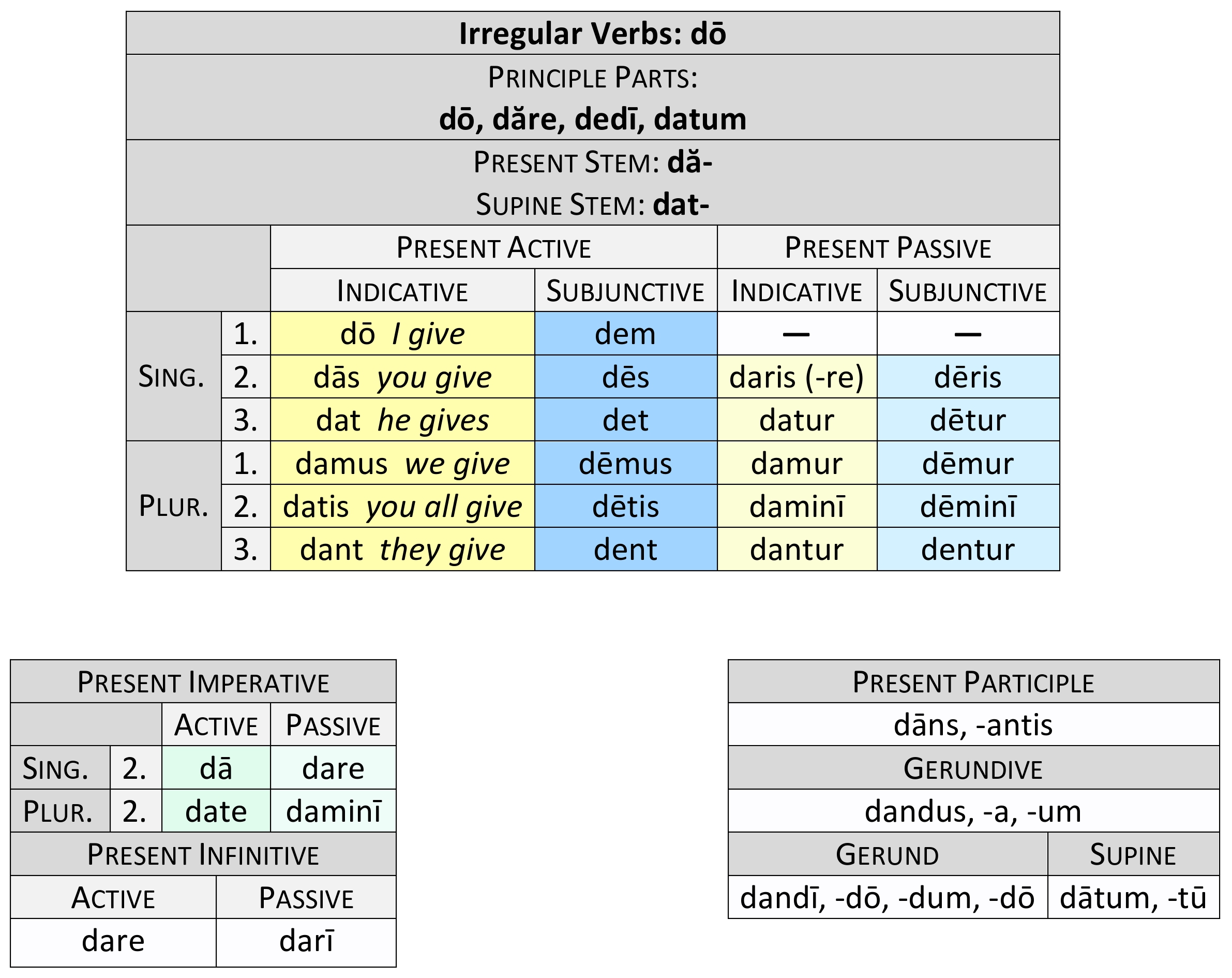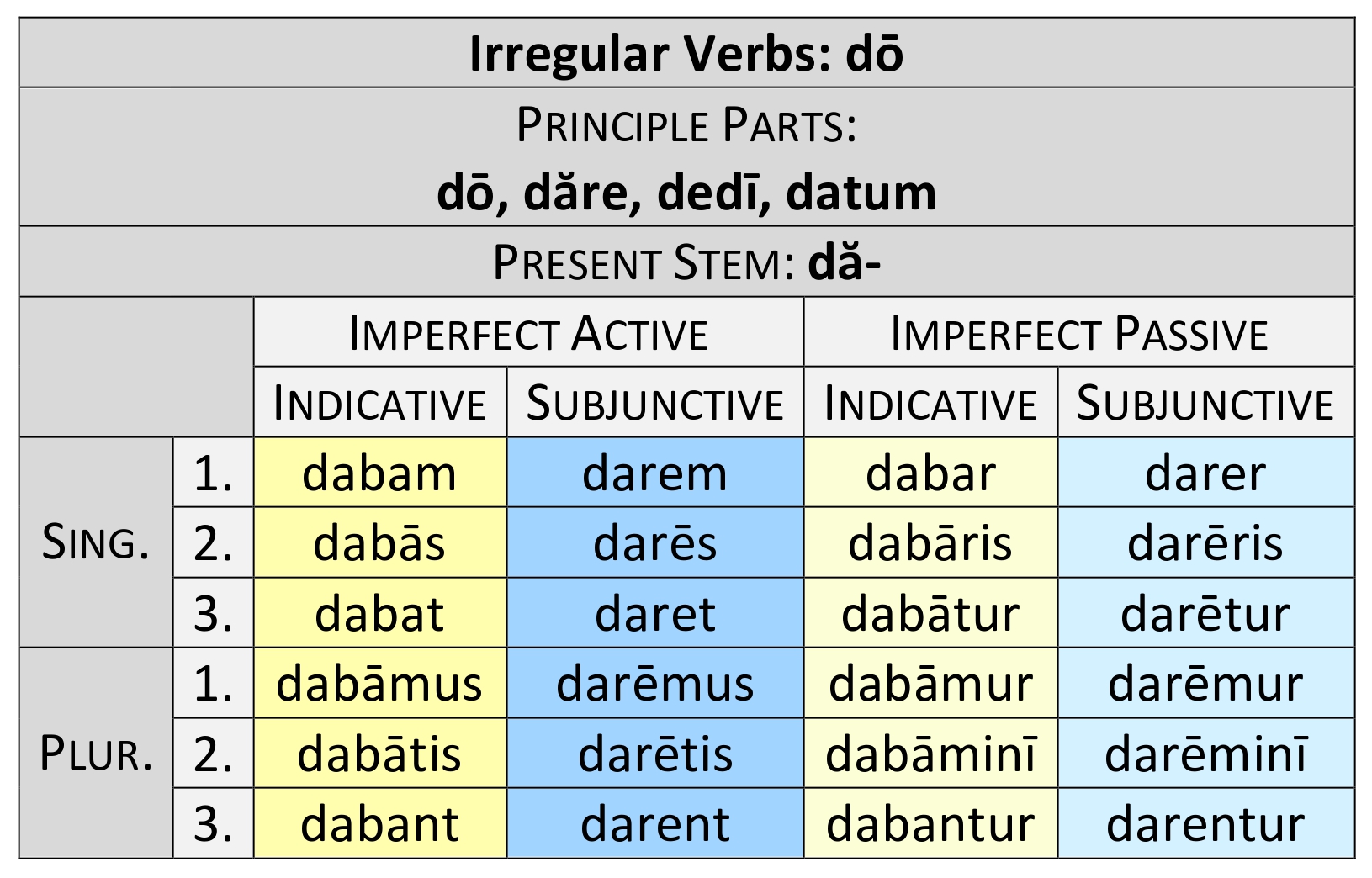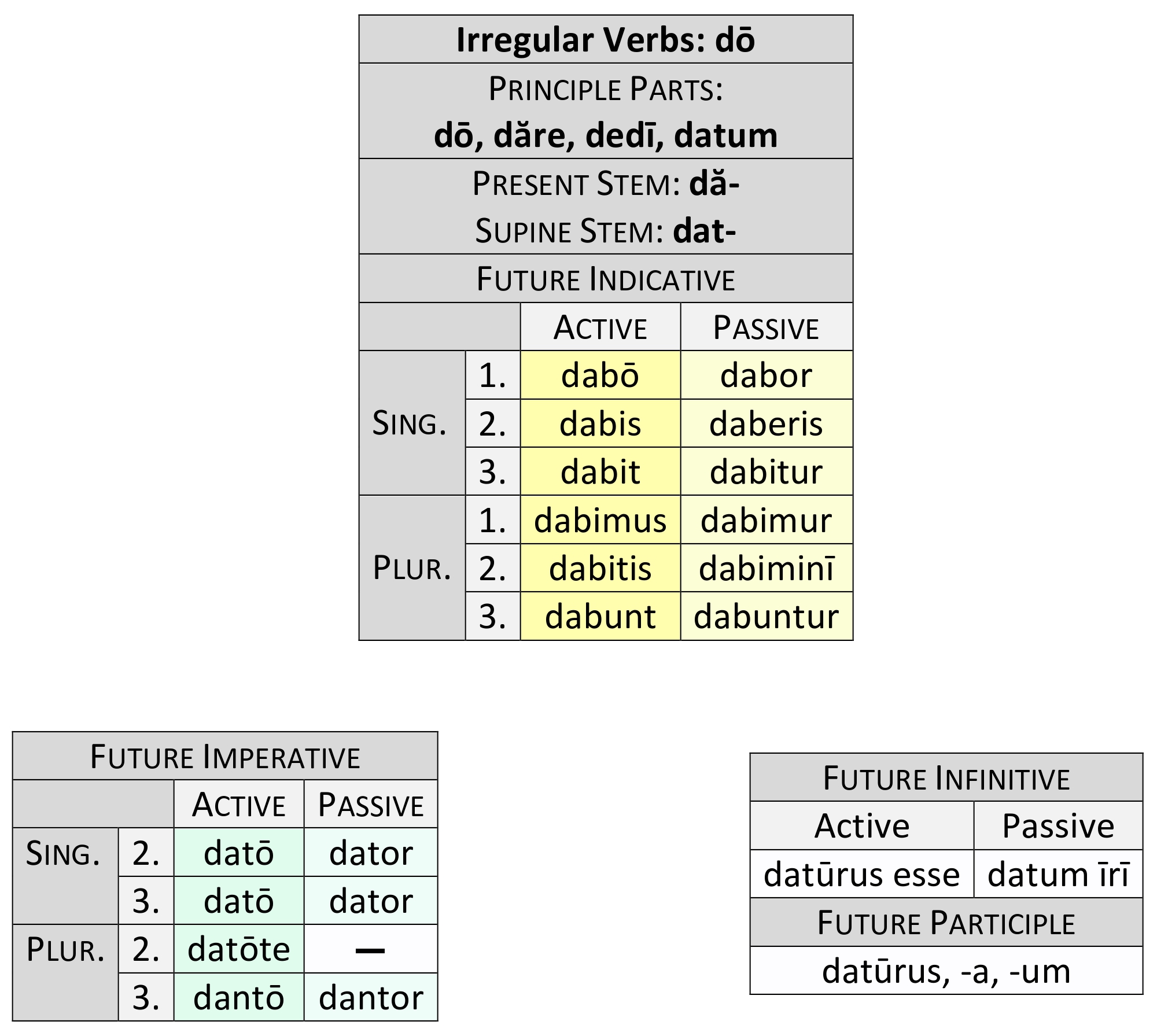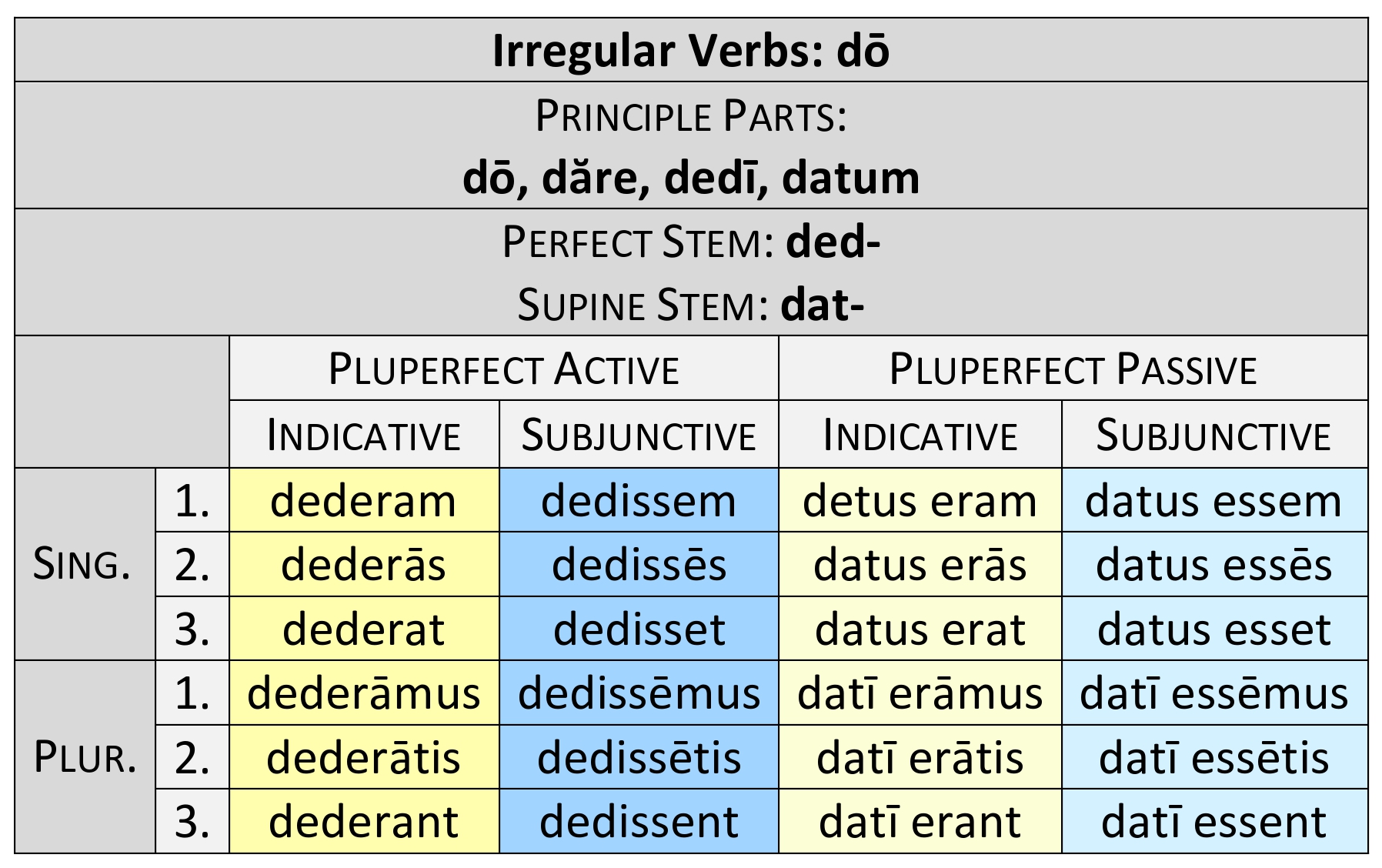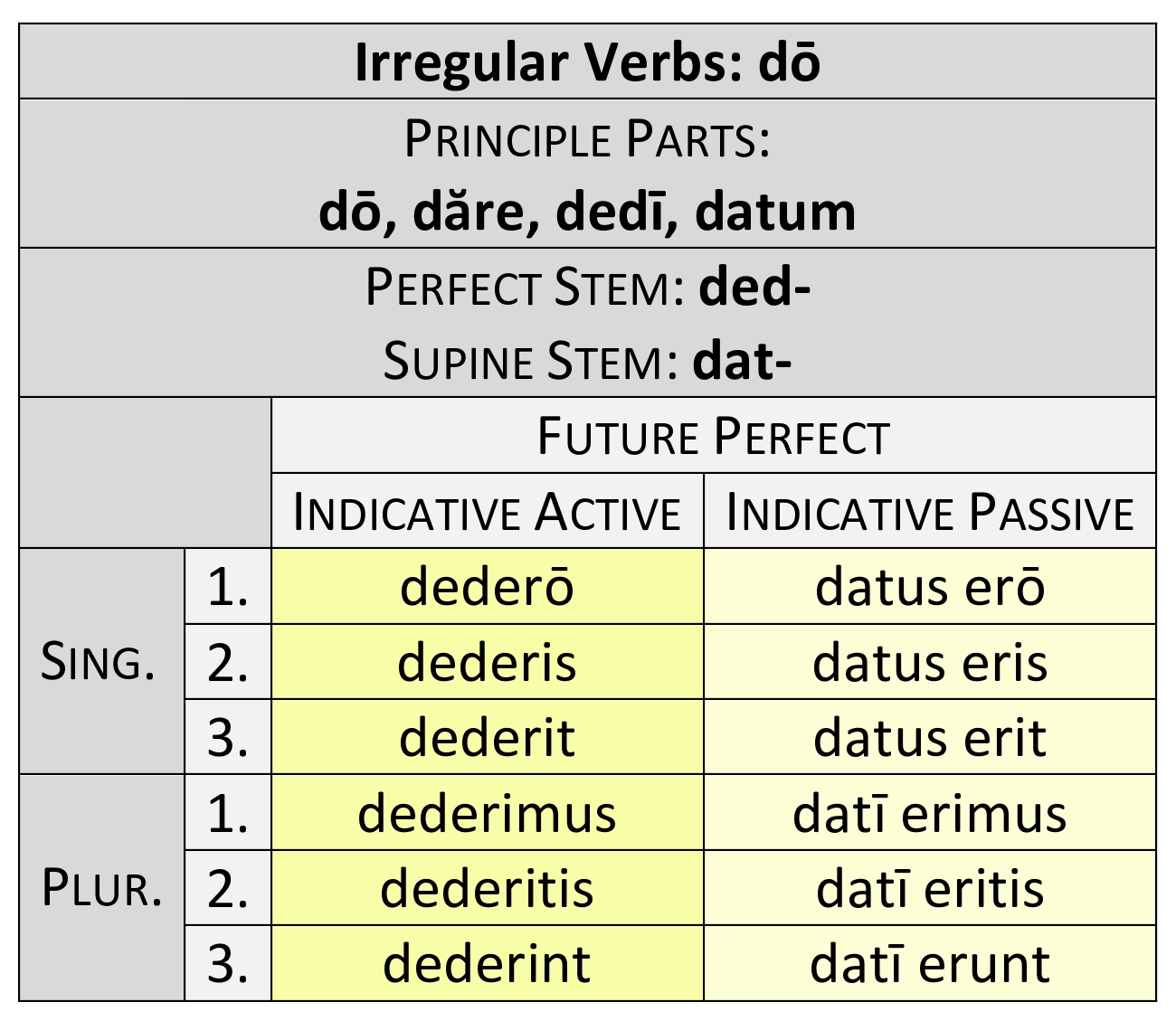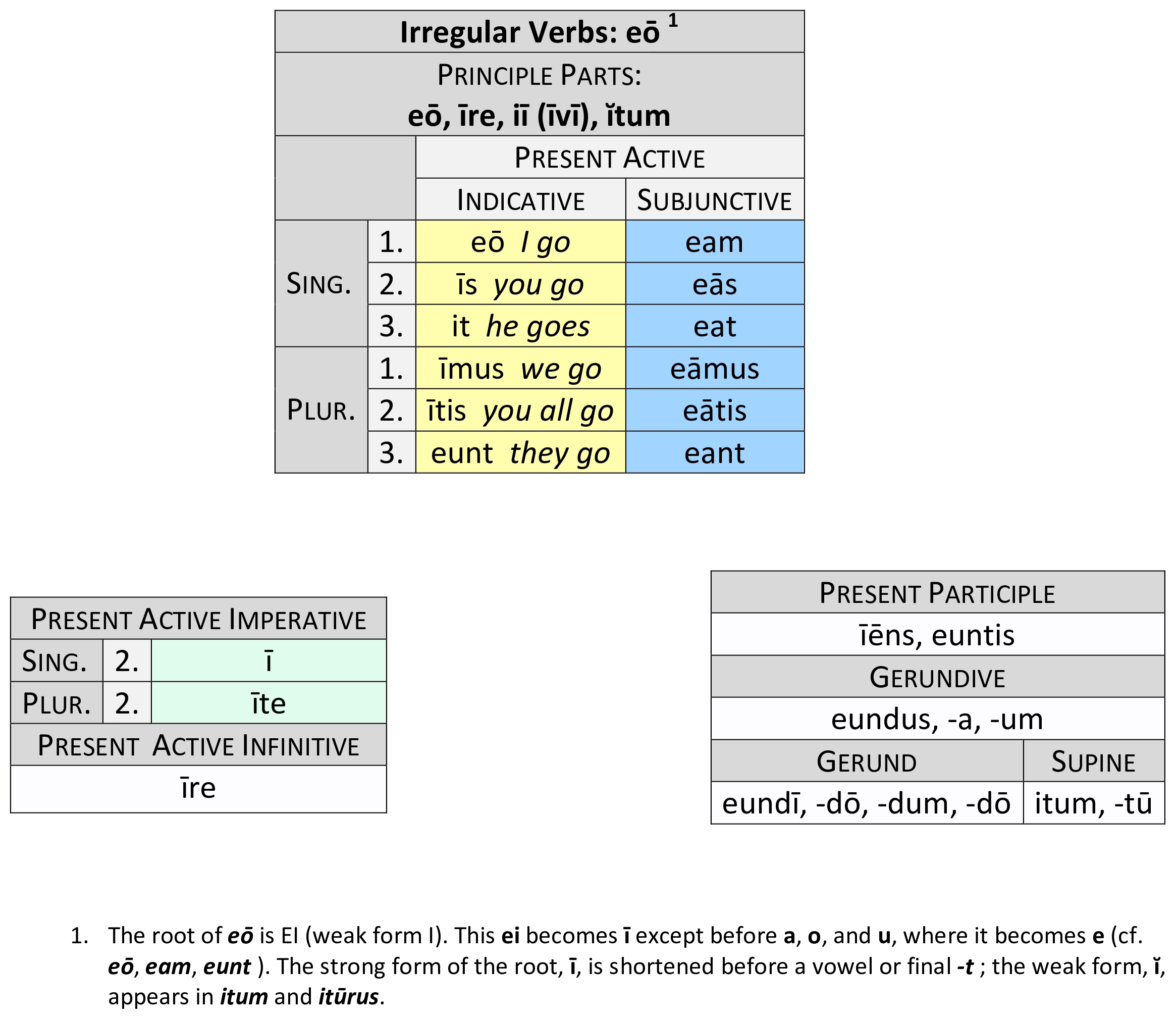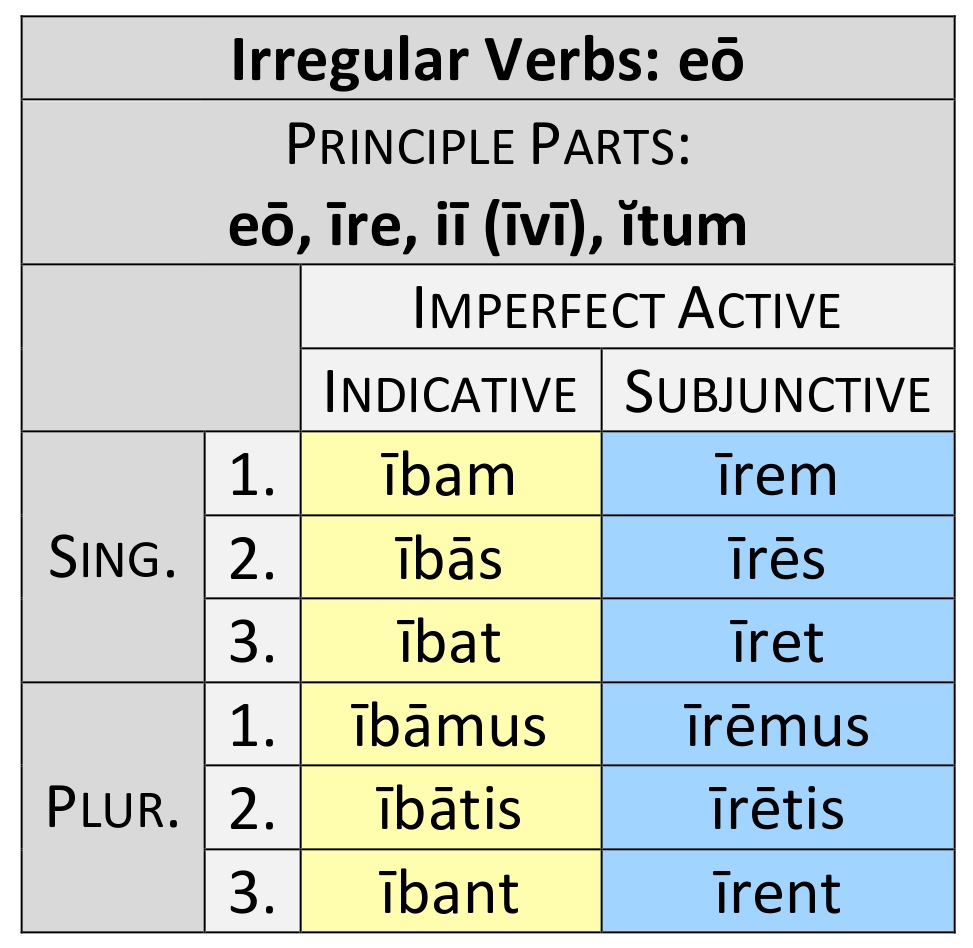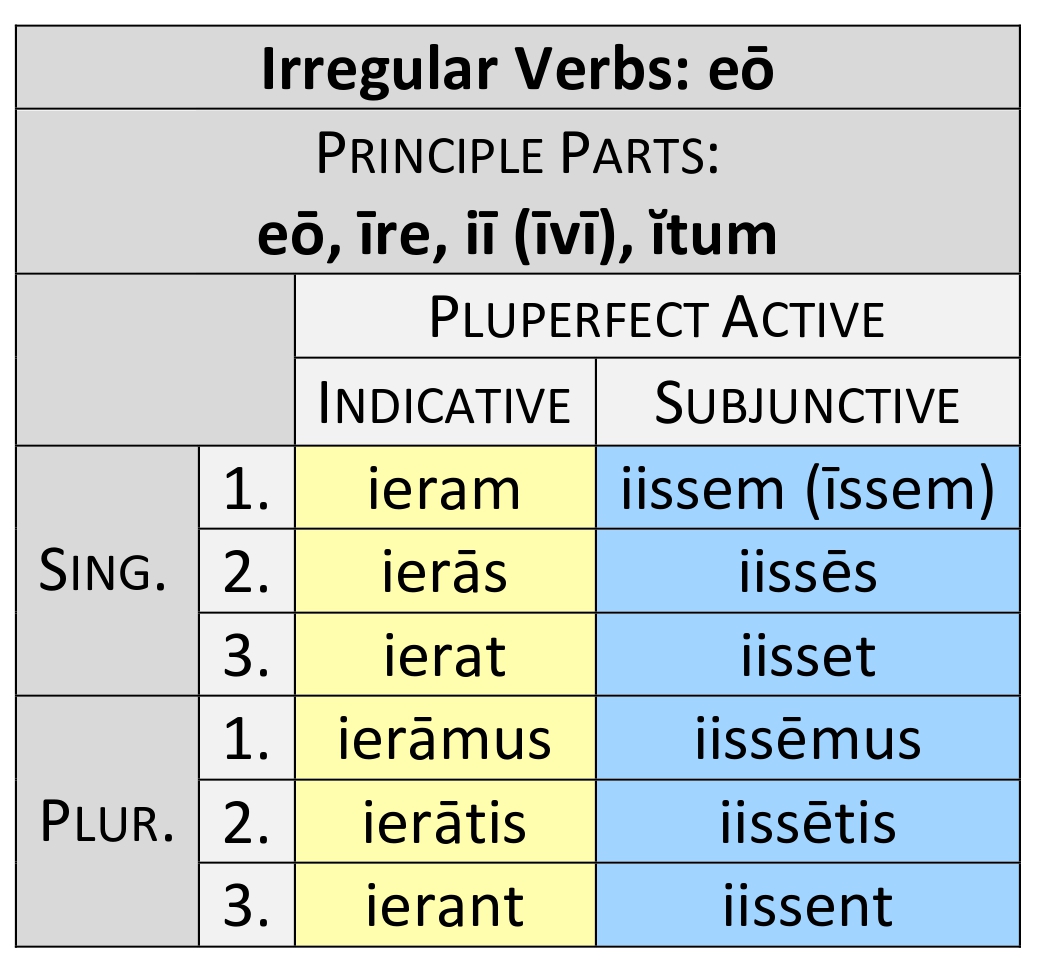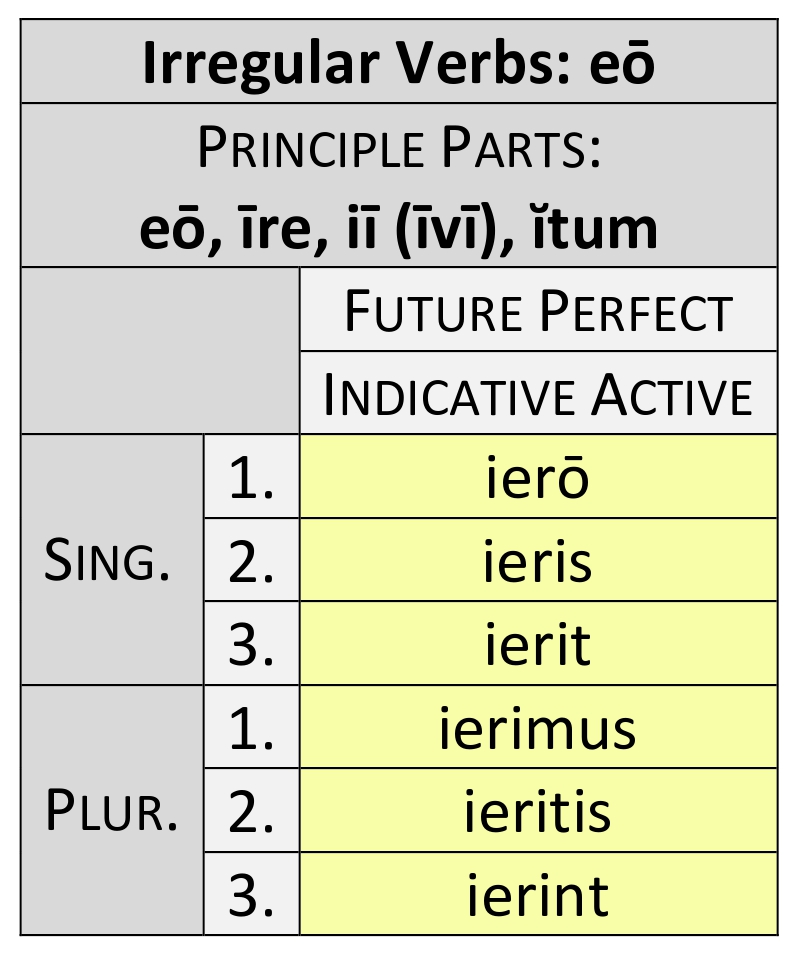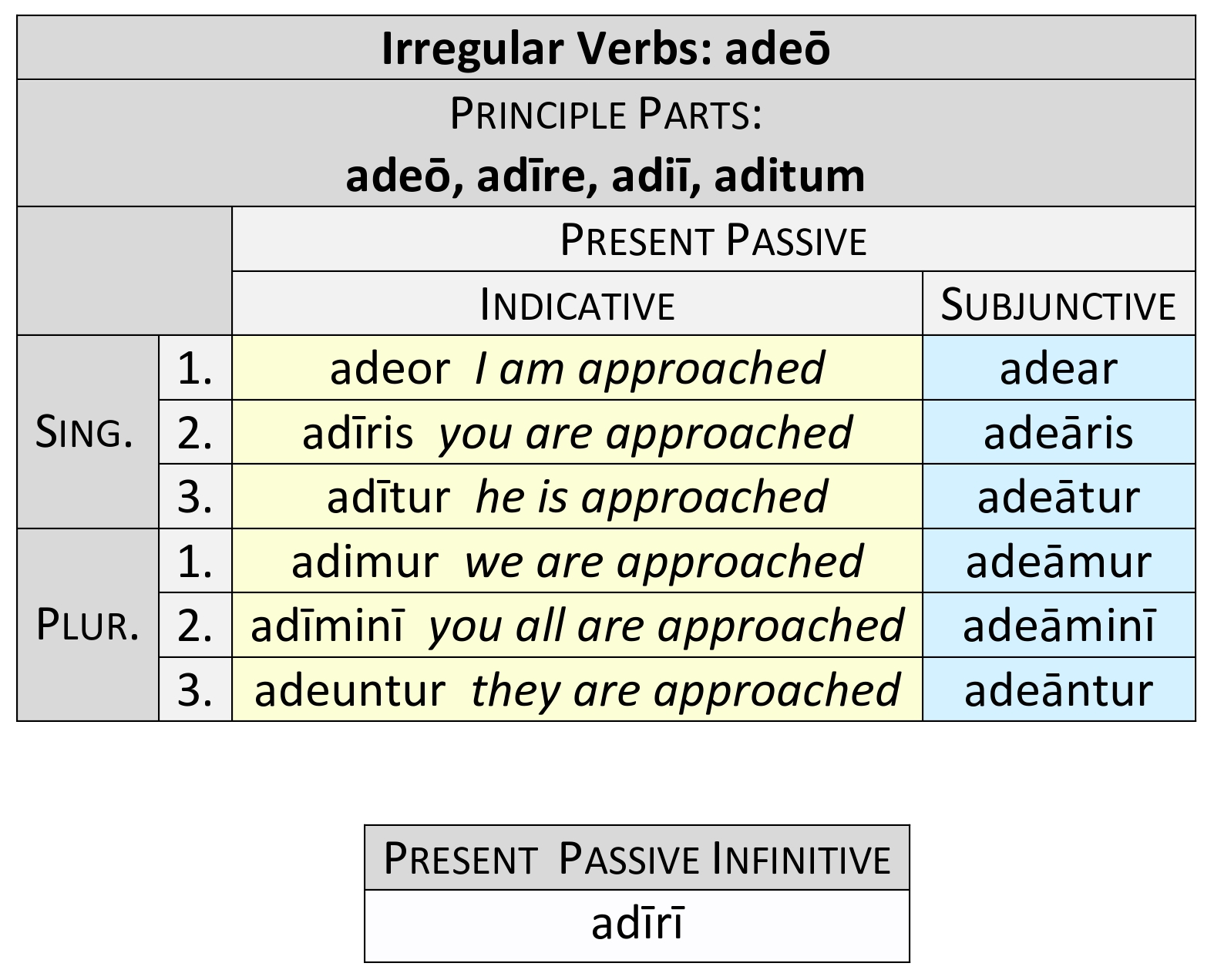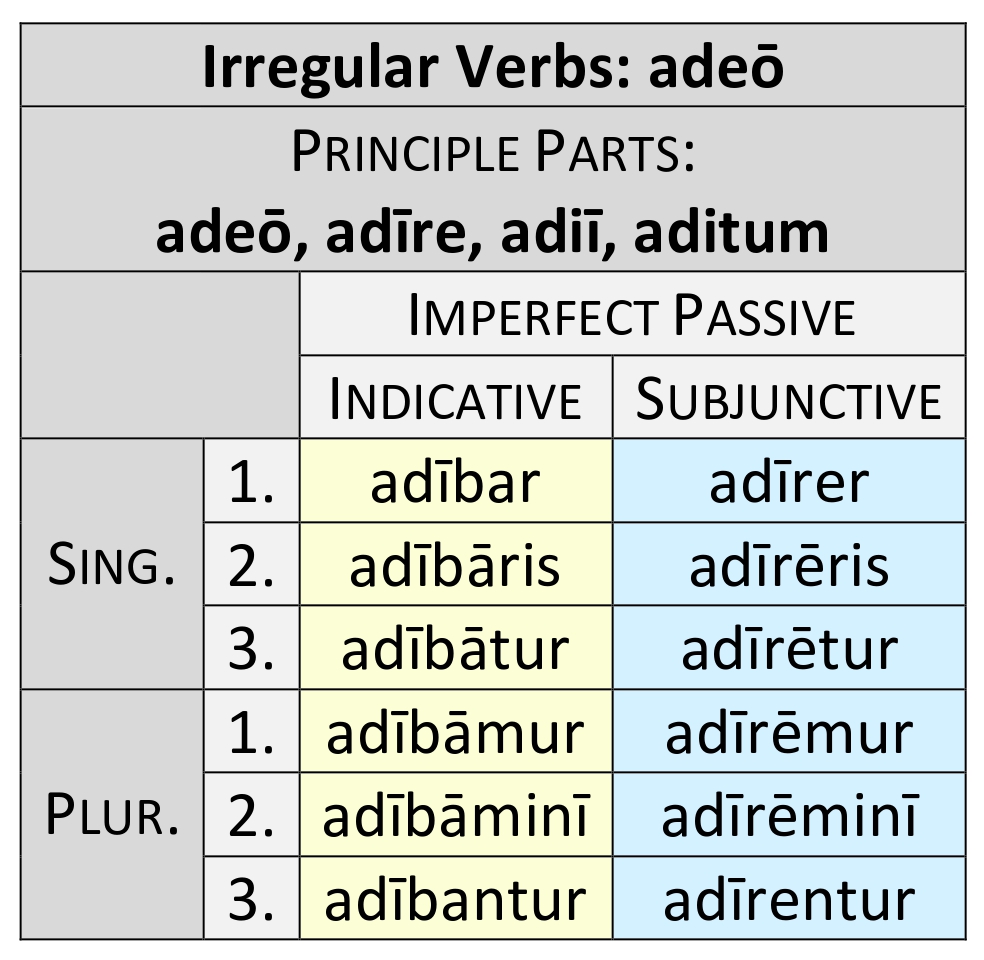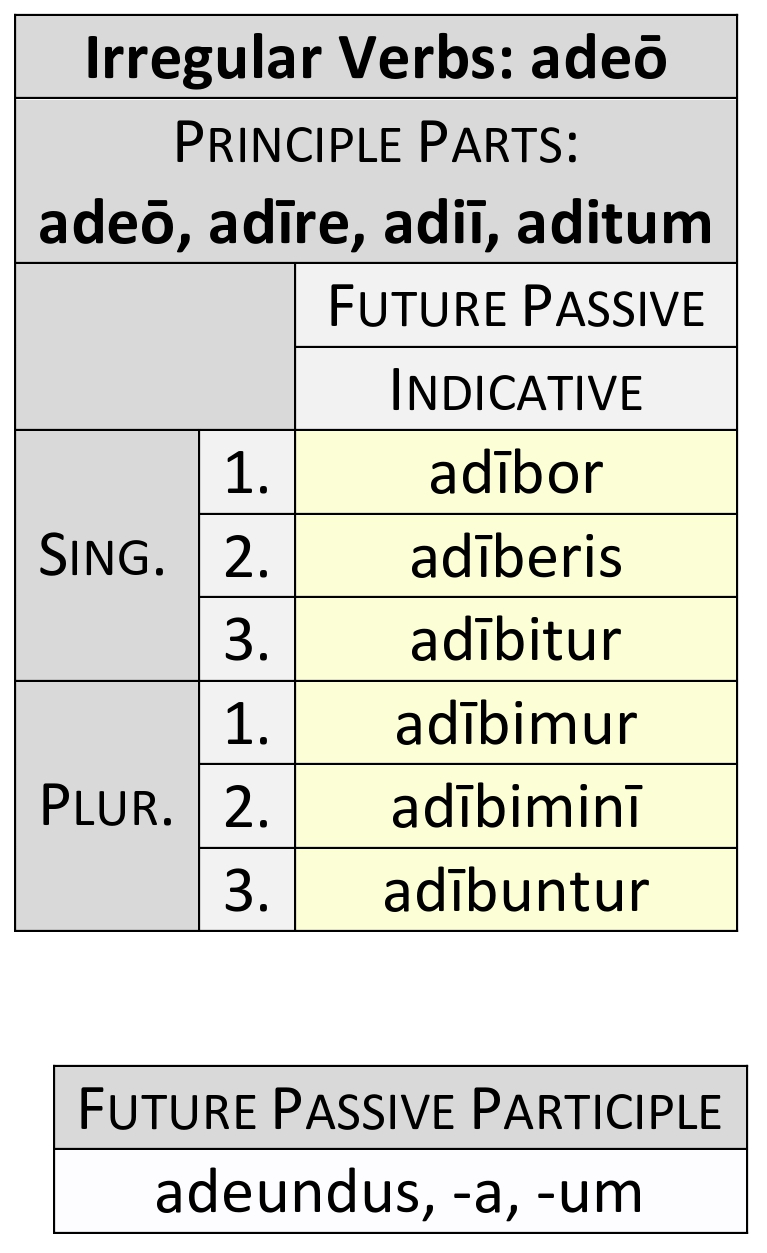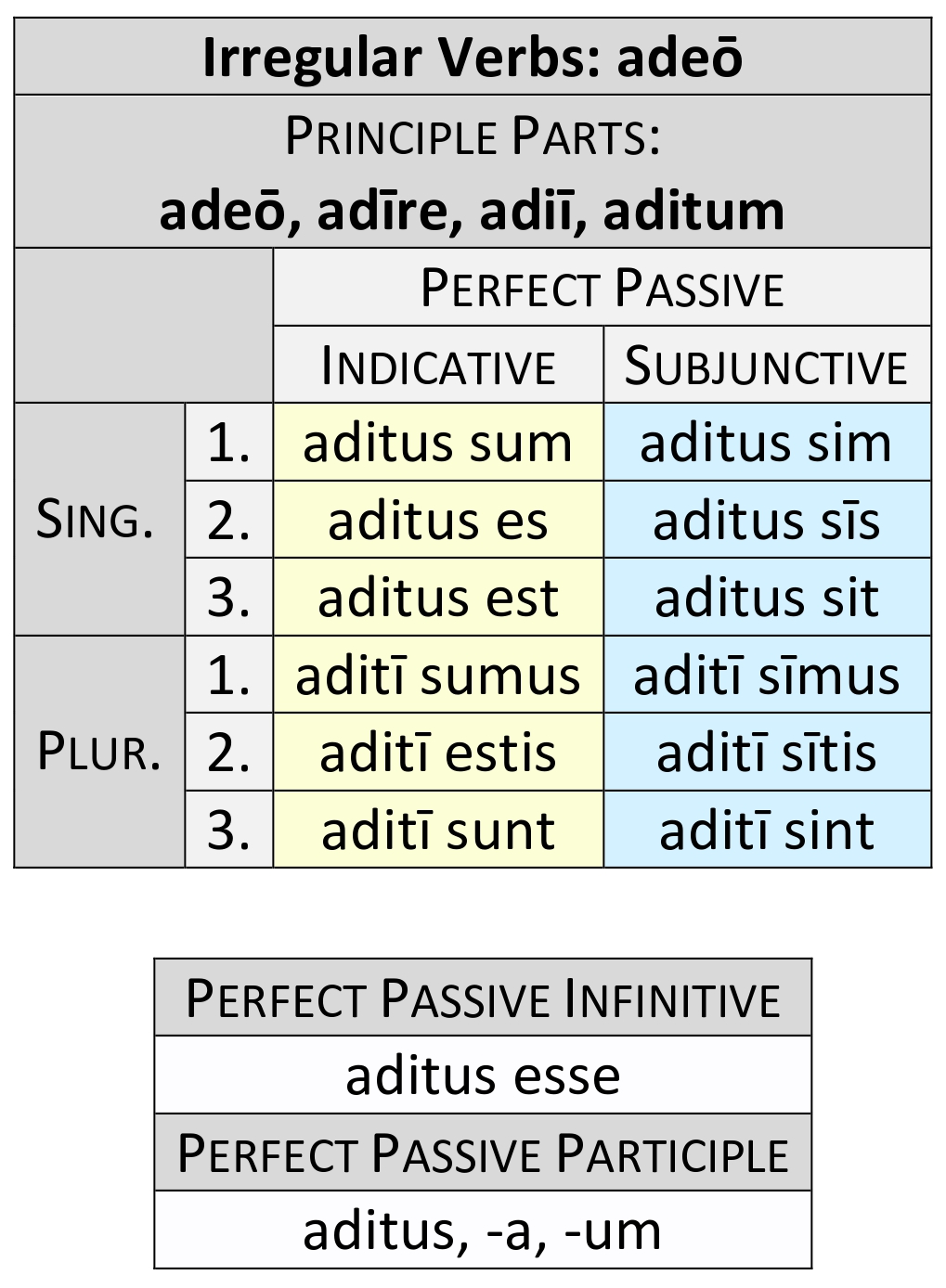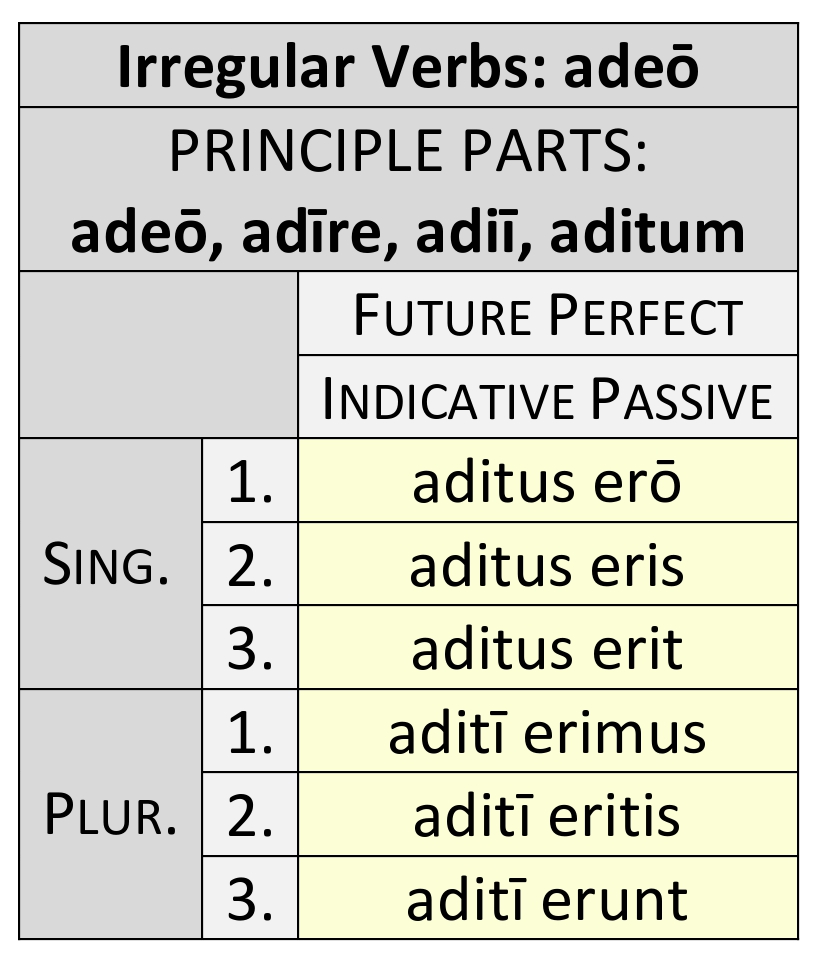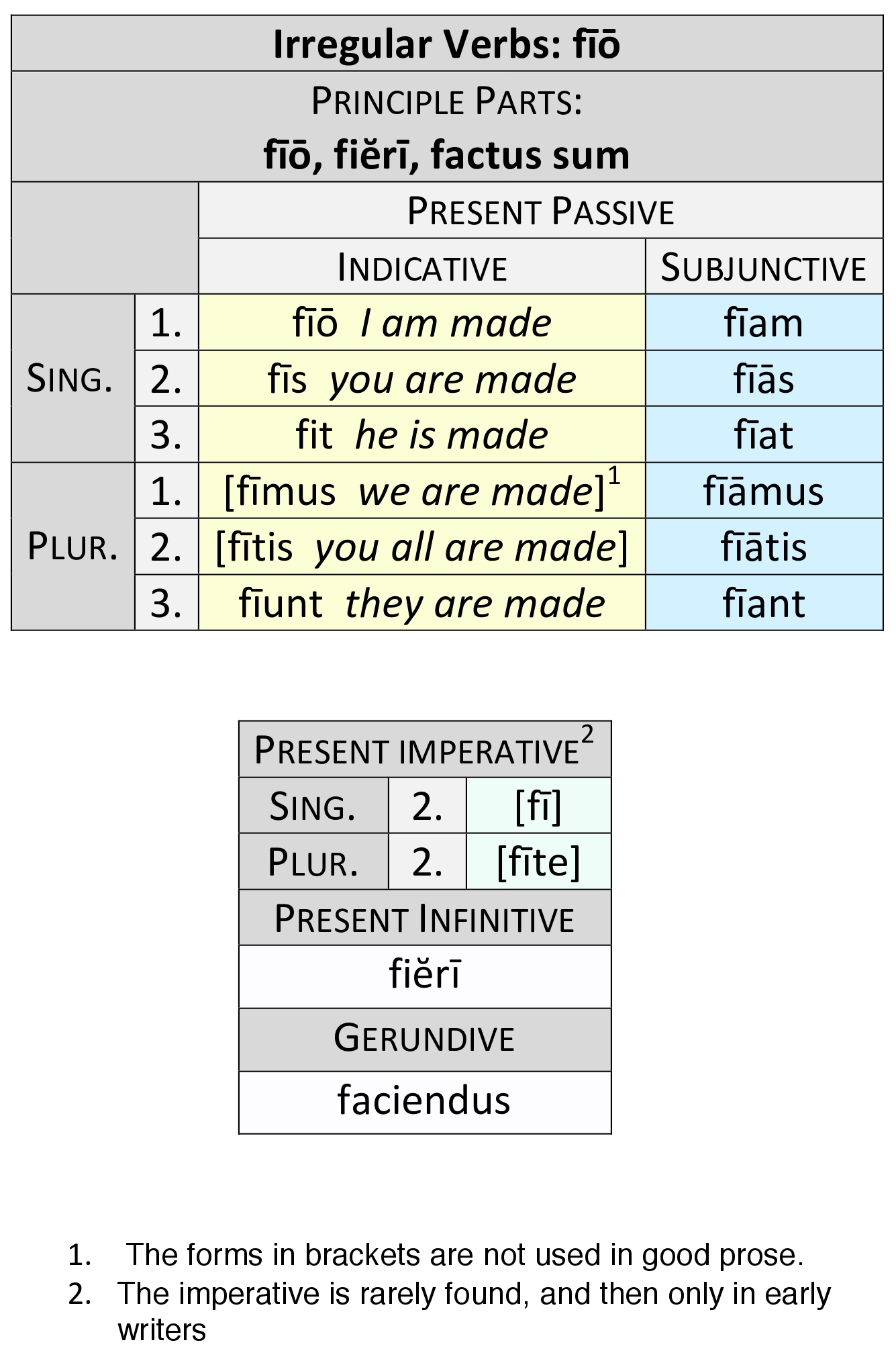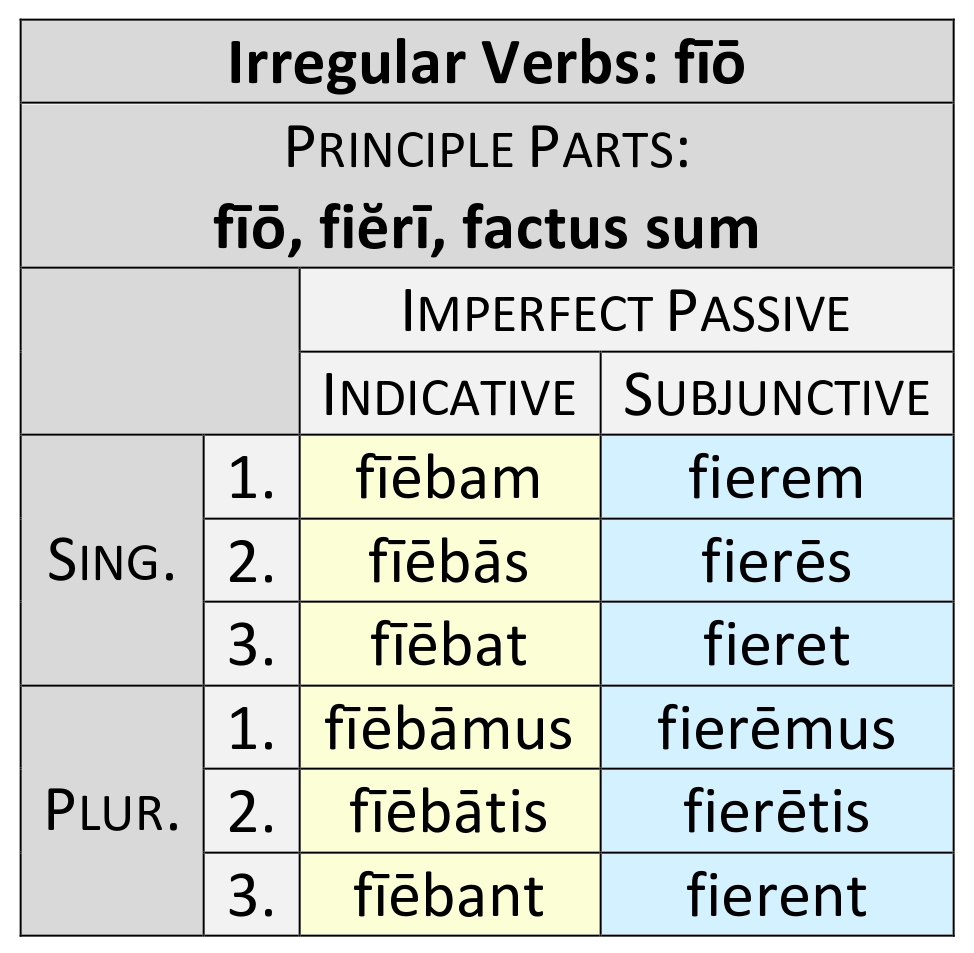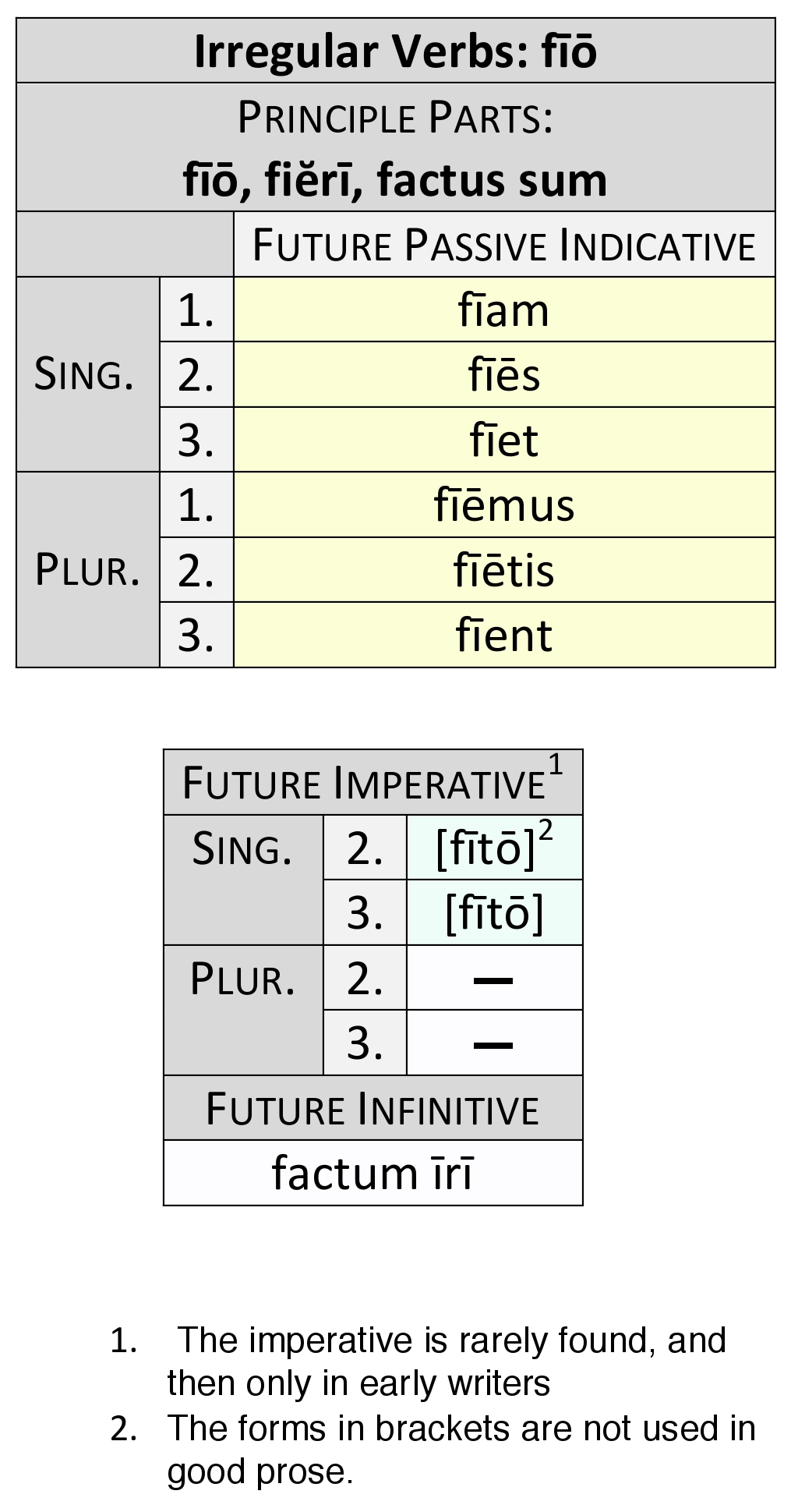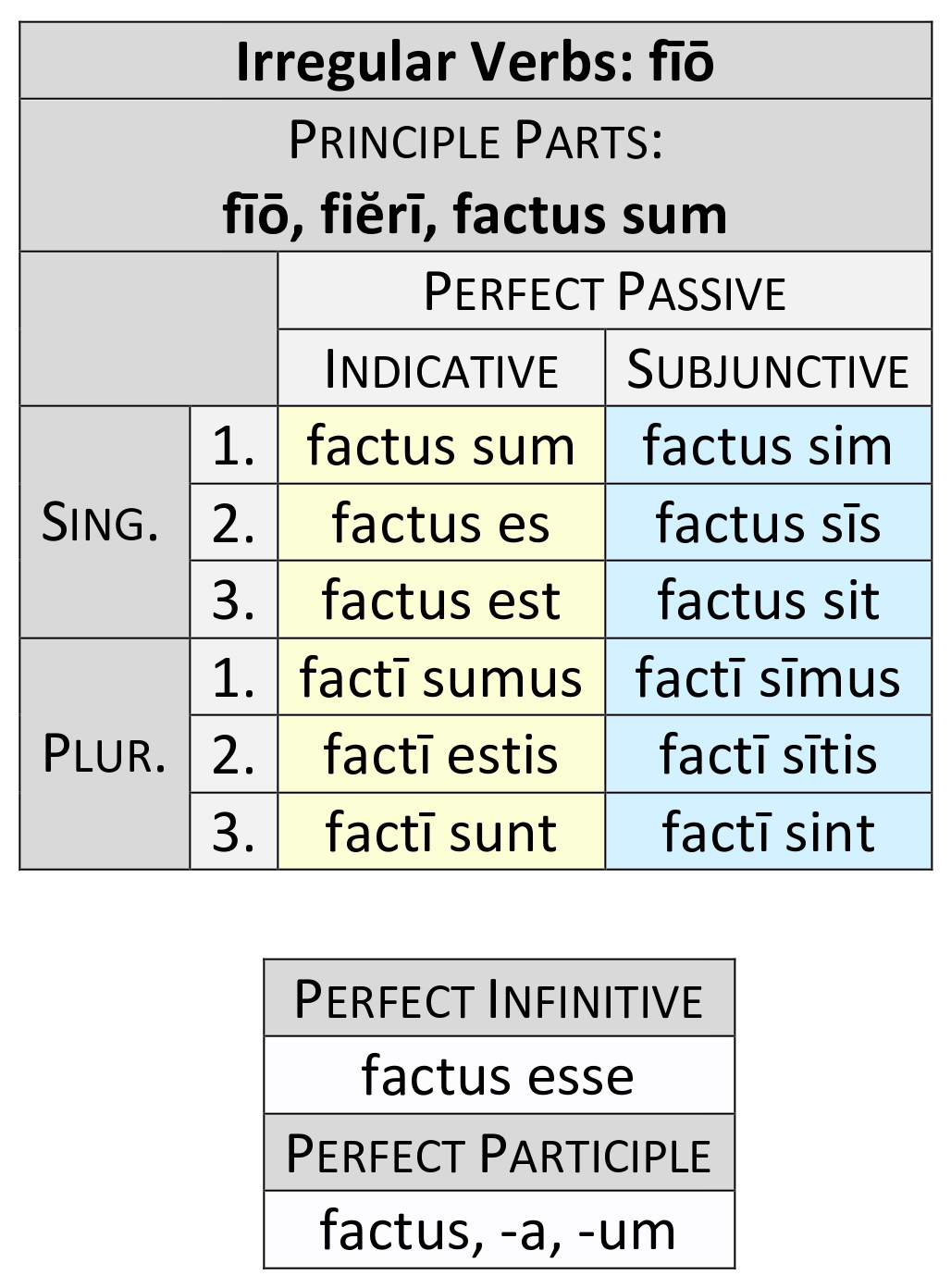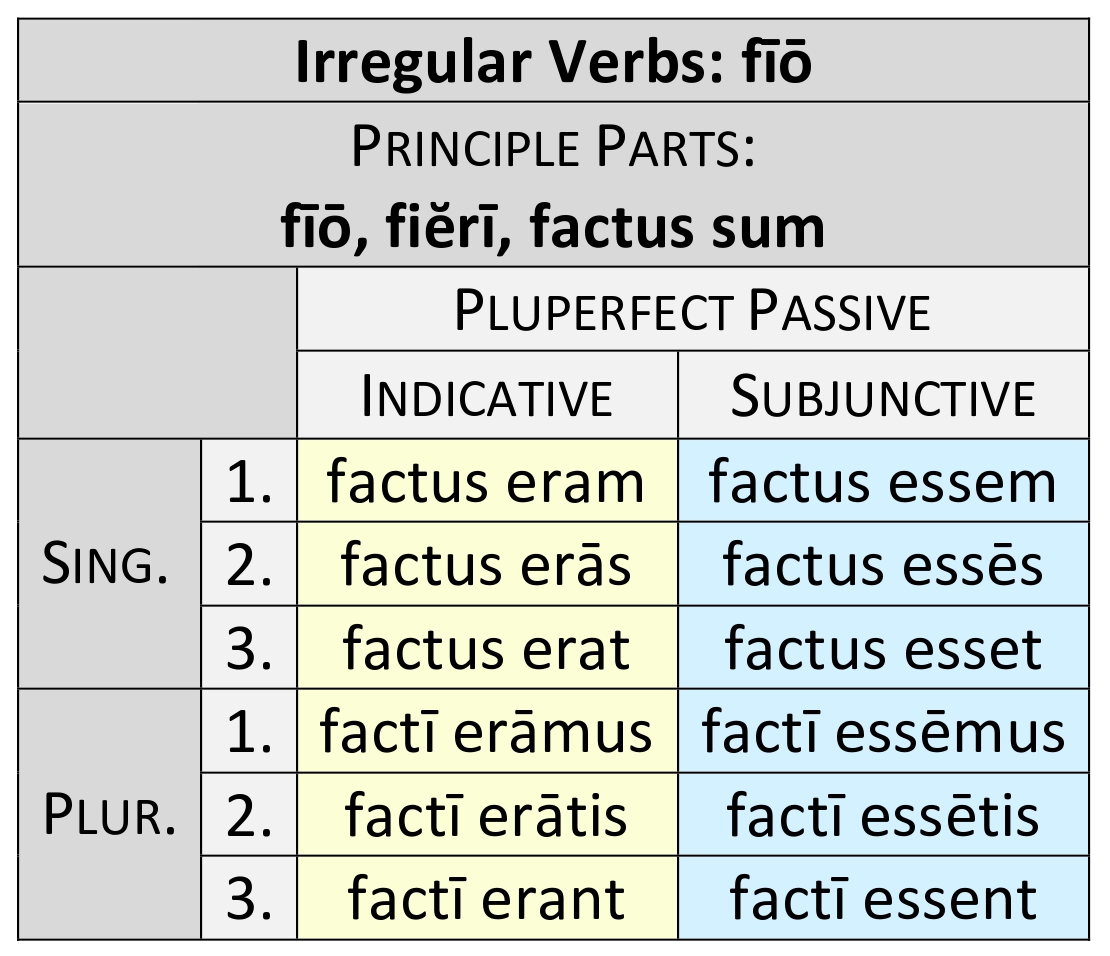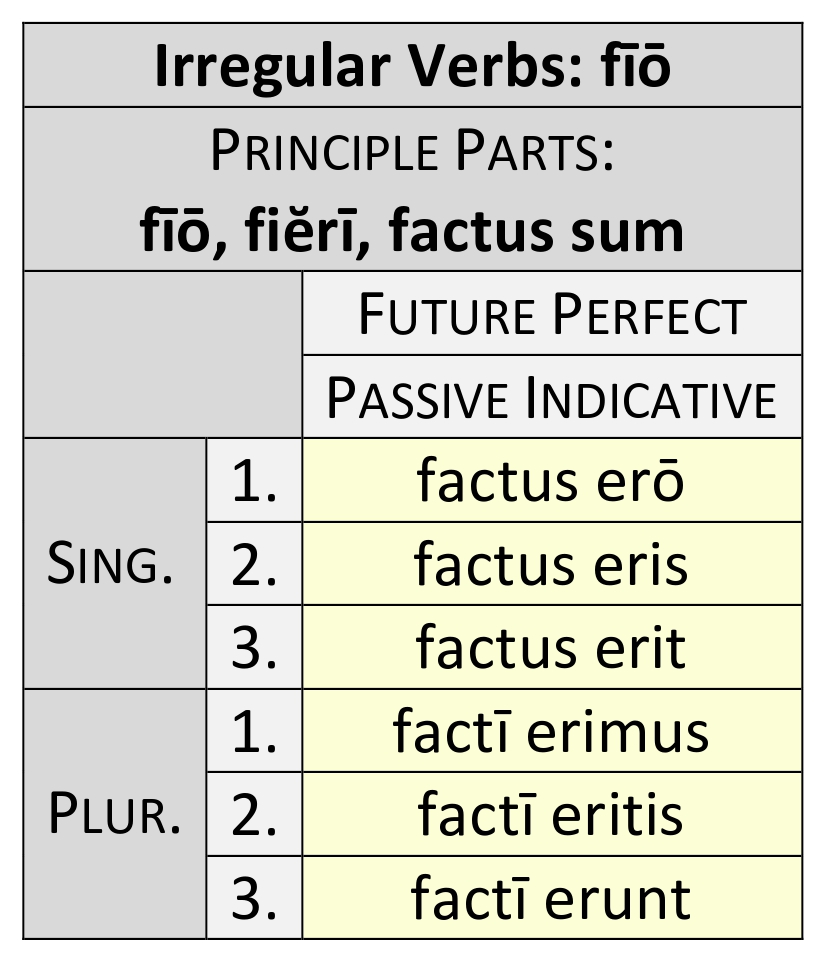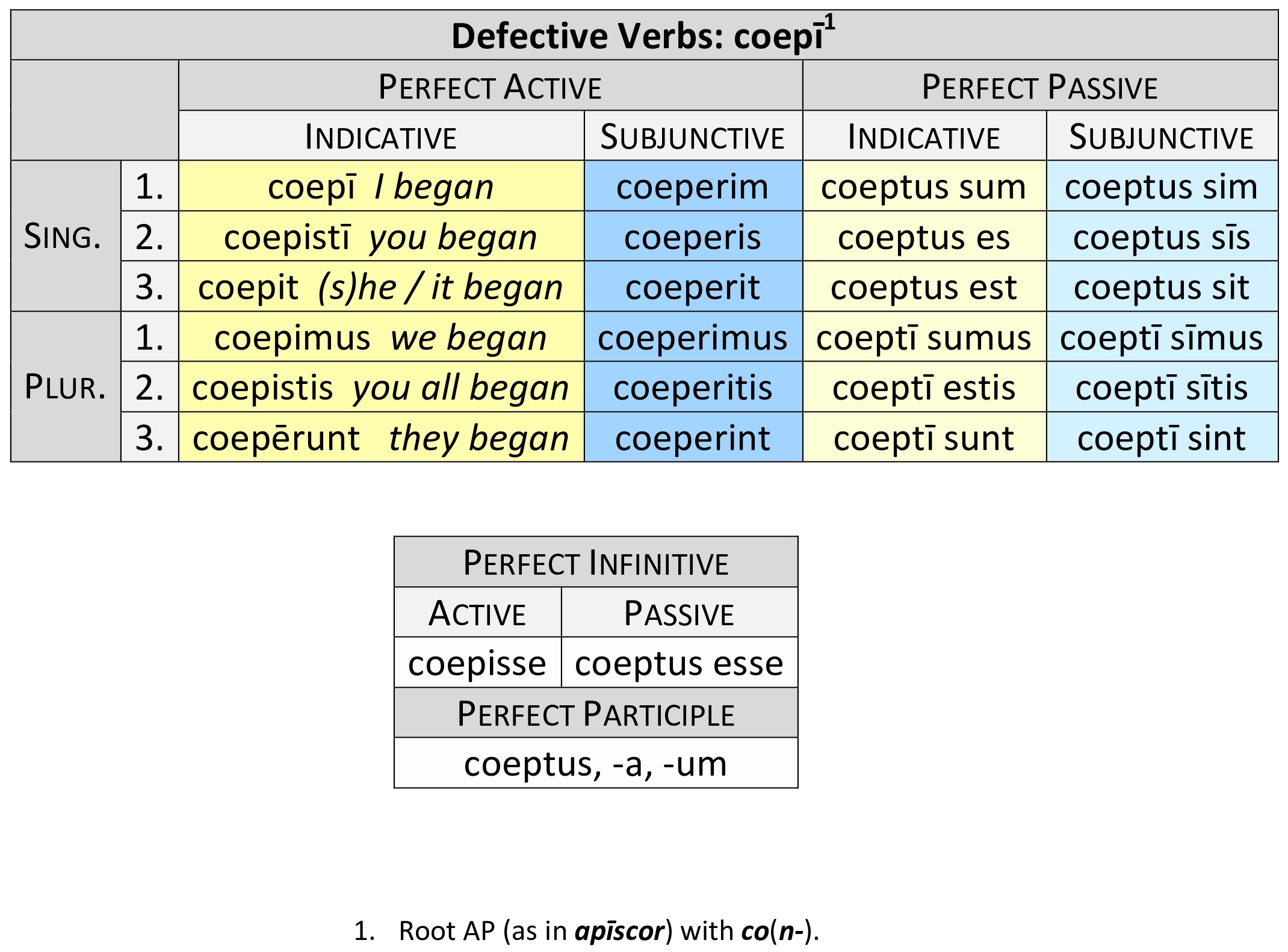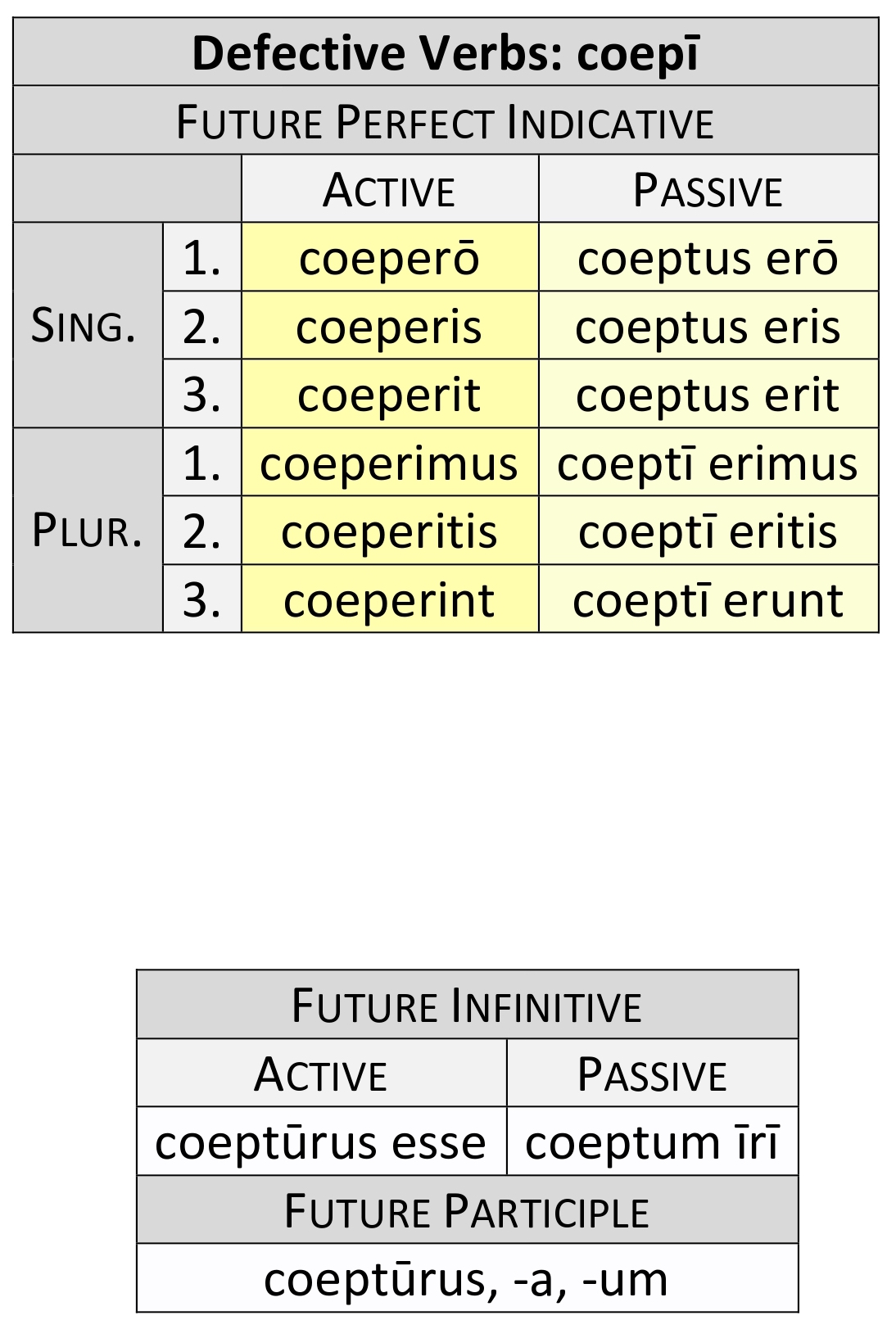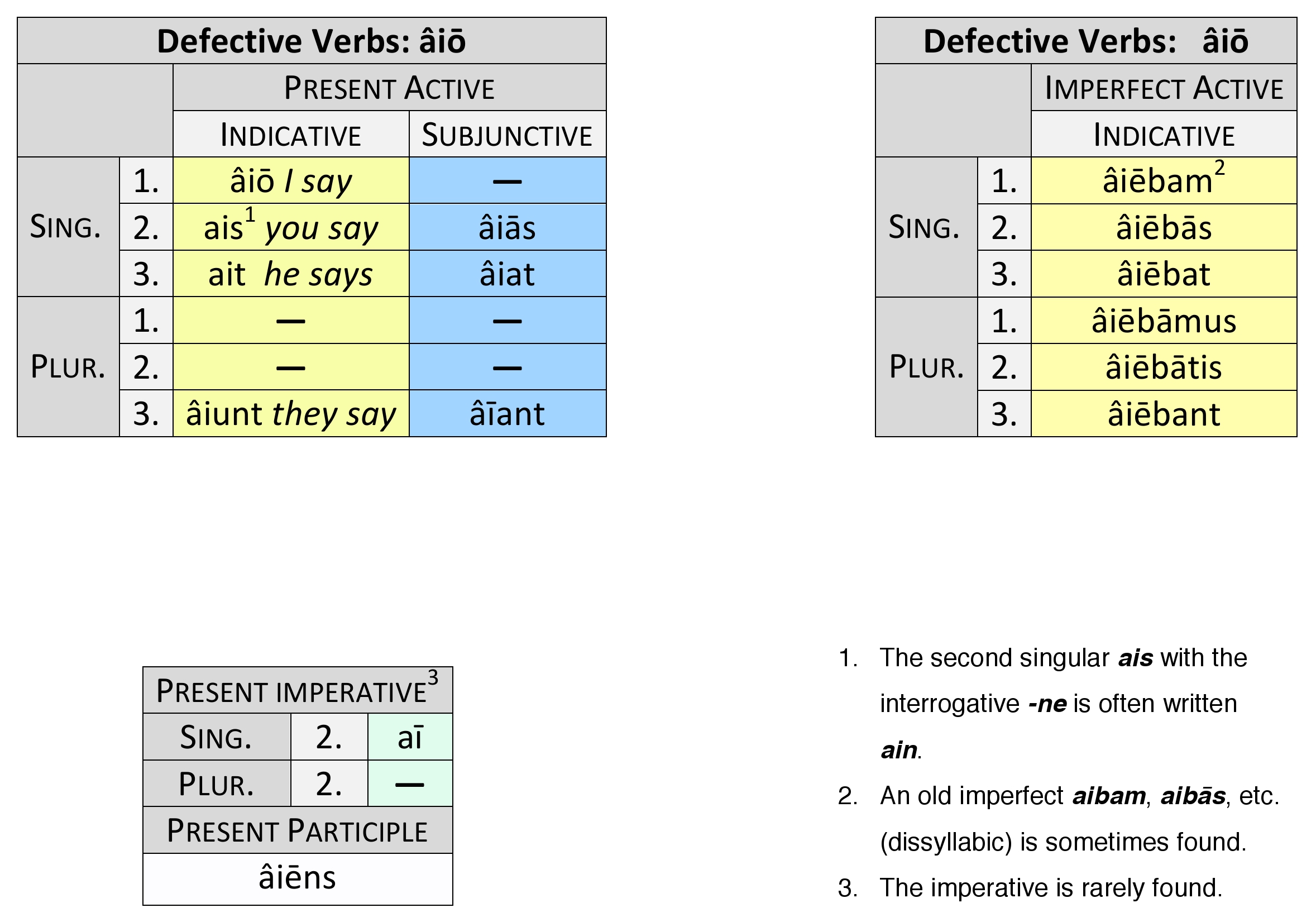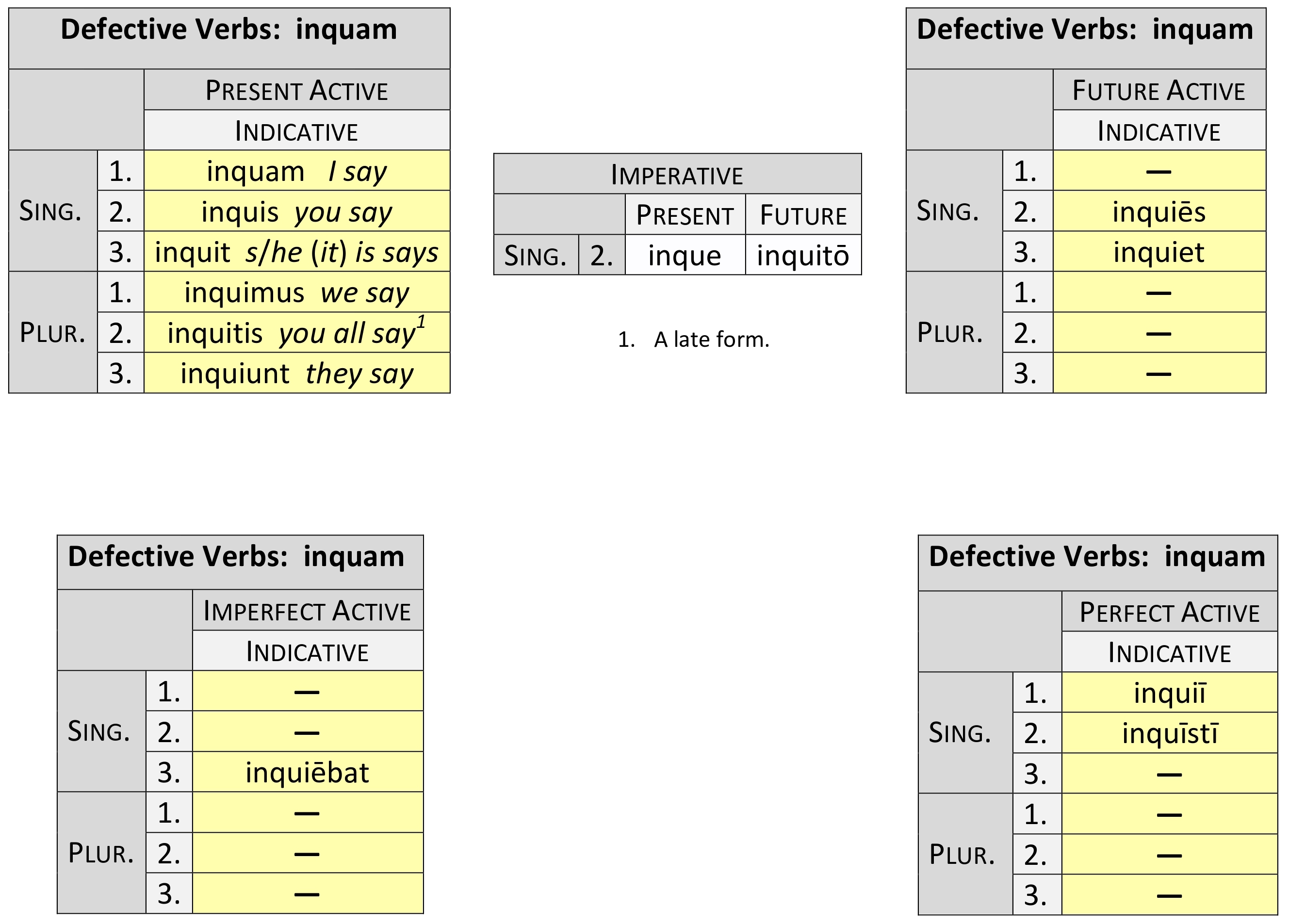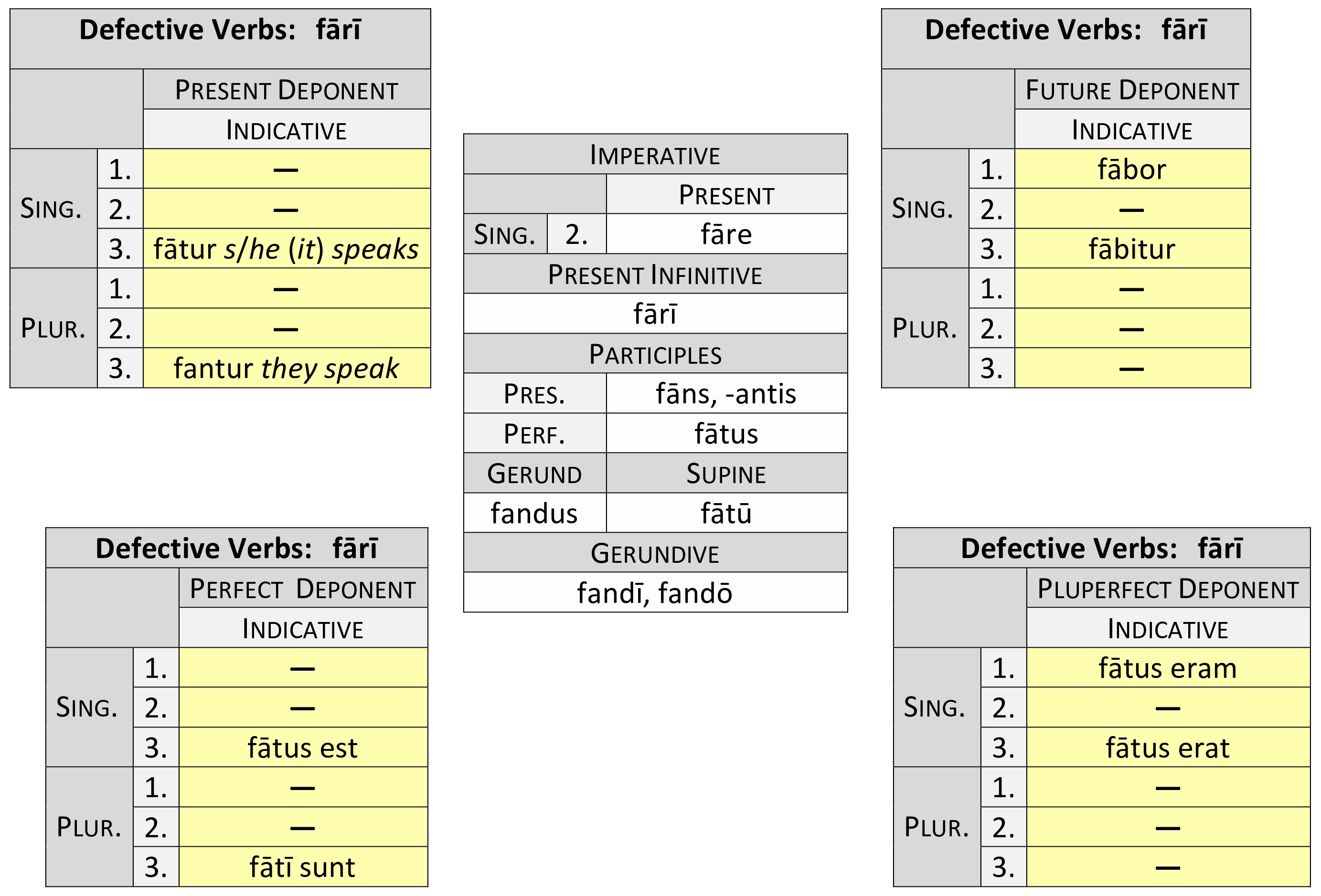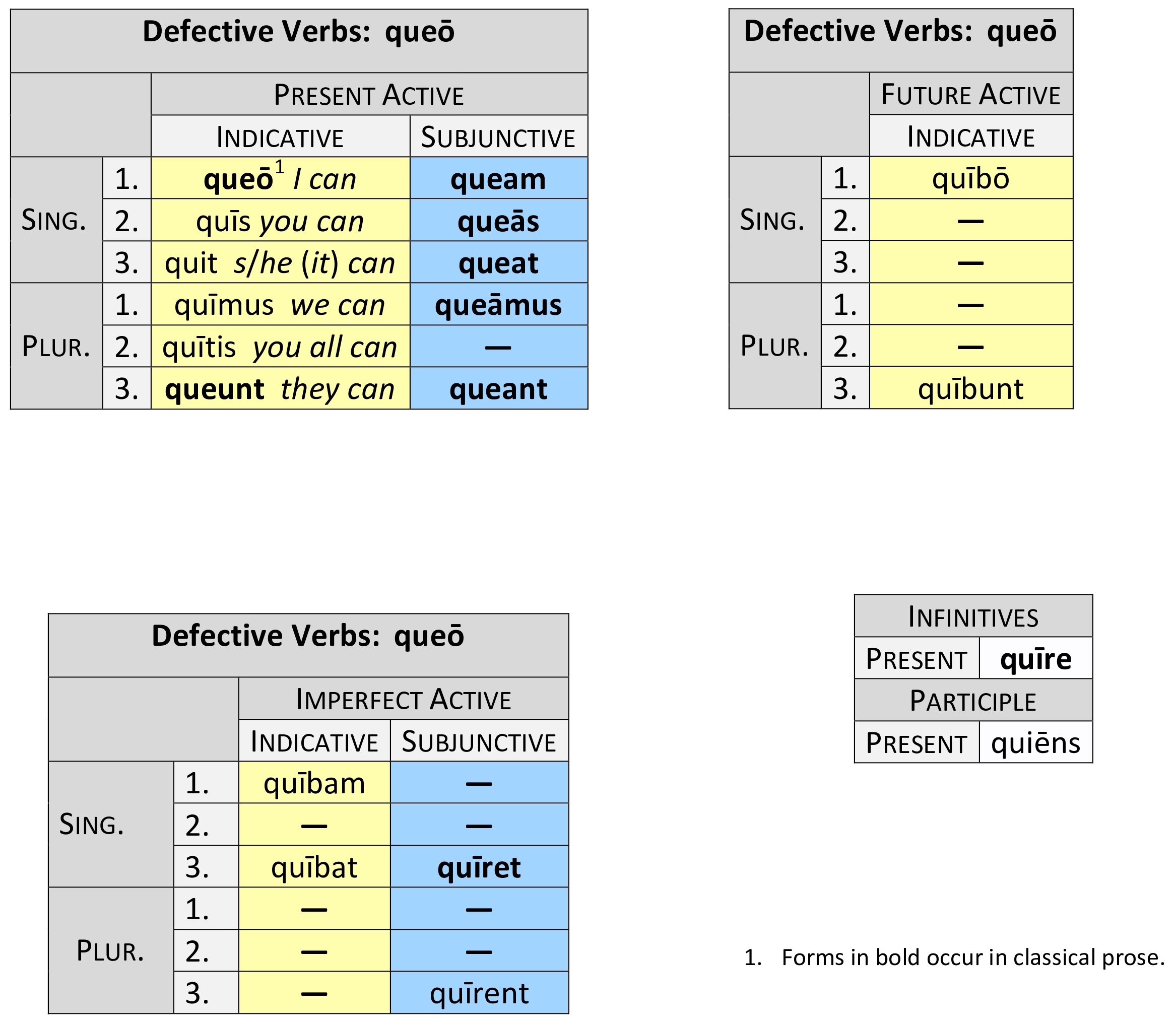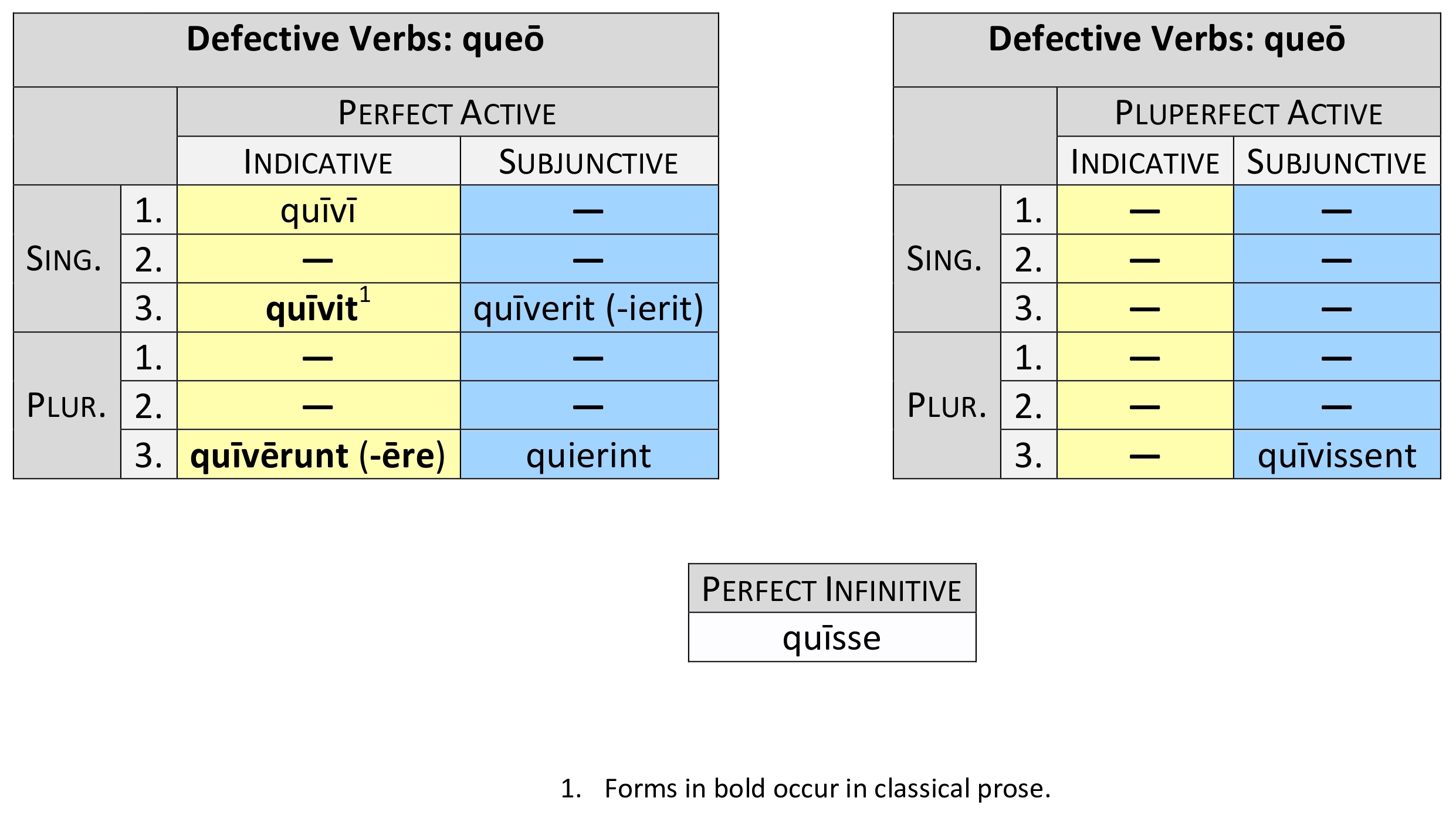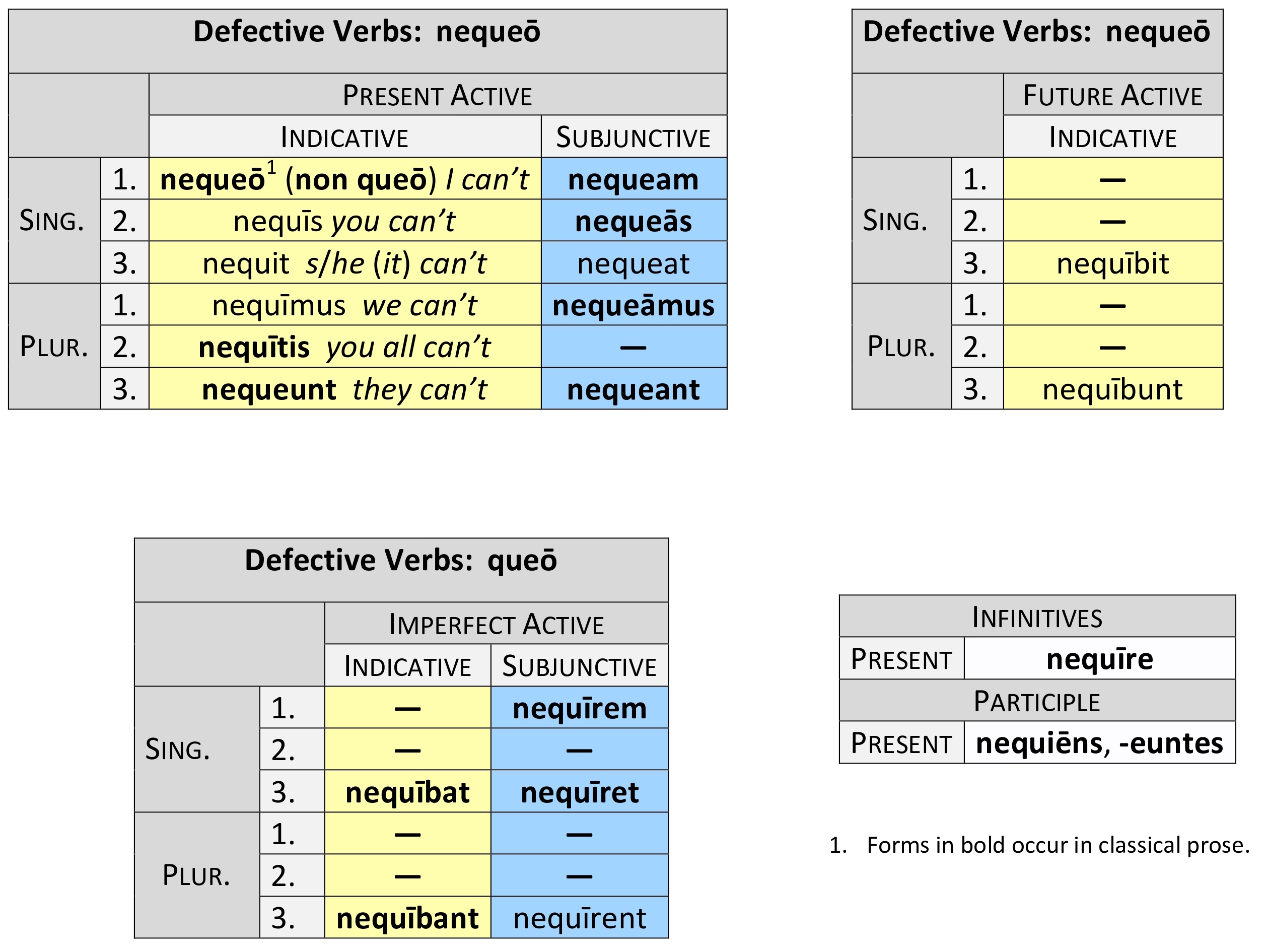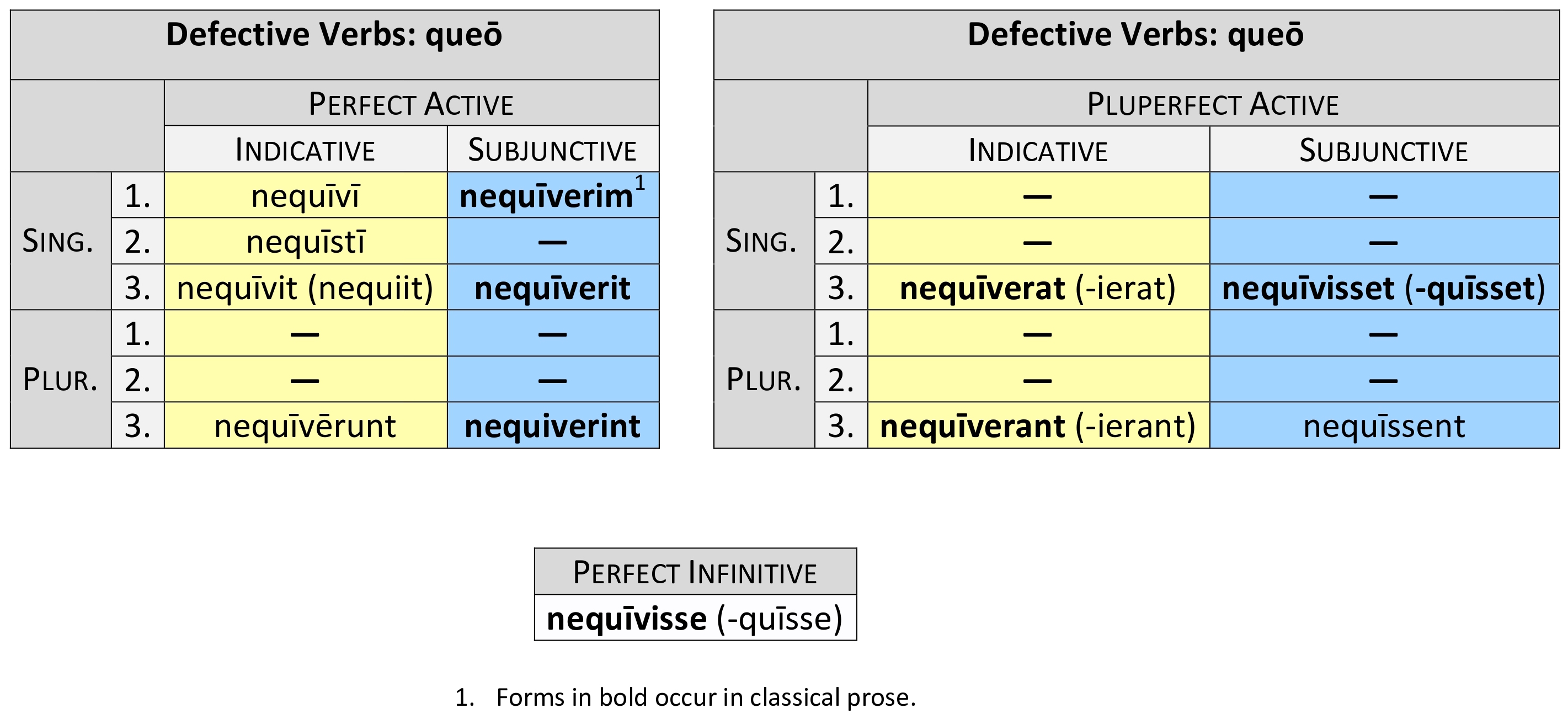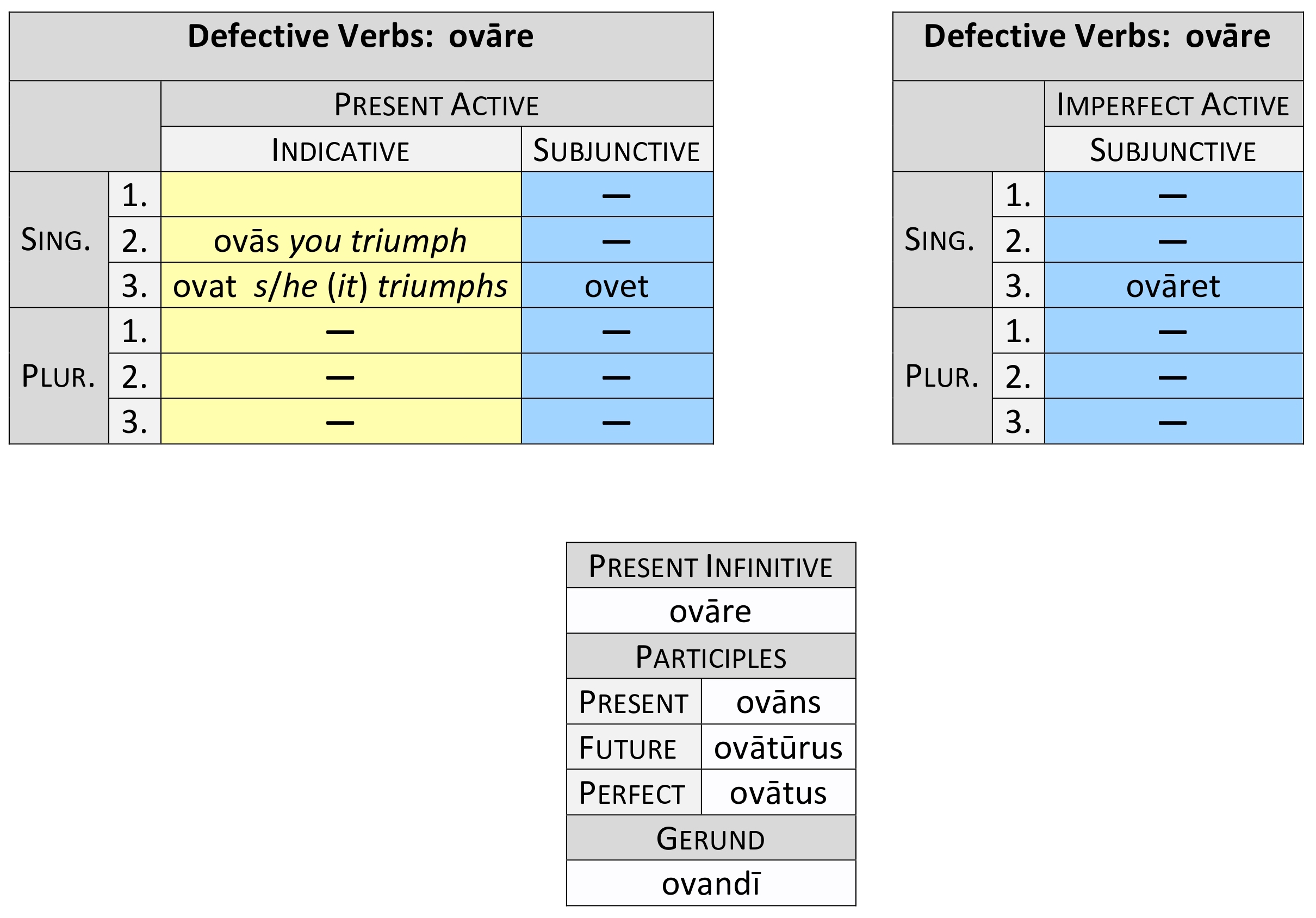CONJUGATIONS
VERB CONJUGATIONS
153. The inflection of the Verb is called its Conjugation.
154. Through its conjugation the Verb expresses Voice, Mood, Tense, Person, and Number.
a. There are two Voices: Active and Passive.
b. The four Moods are: Indicative, Subjunctive, Imperative, and Infinitive.1
Note— The Indicative, Subjunctive, and Imperative are called Finite Moods in distinction from the Infinitive.
c. There are six Tenses.
For continued action: Present, Imperfect, Future
For completed action: Perfect, Pluperfect, Future Perfect
The Indicative Mood has all six tenses, but the Subjunctive has no Future or Future Perfect, and the Imperative has only the Present and the Future. The Infinitive has the Present, Perfect, and Future.
d.The three Persons are: 1st, 2nd, and 3rd.
e. The two Numbers are: Singular and Plural.
155. The following Noun and Adjective forms are also included in the inflection of the Latin Verb.
a. Four Participles.2
Active: the Present and Future participles
Passive: the Perfect participle and the Gerundive.3
b. The Gerund is a neuter noun of the 2nd declension in form, used only in the oblique cases of the singular.
c. The Supine: this is a verbal noun of the 4th declension in the accusative (-um) and dative or ablative (-ū)4 singular.
156. The Active and Passive Voices in Latin generally correspond to the active and passive in English with the following exceptions.
a. The passive voice often has a reflexive meaning.
Ferrō accingor. I gird myself with my sword.
Turnus vertitur. Turnus turns (himself).
Induitur vestem. He puts on his (own) clothes.
Note— This use corresponds very nearly to the Greek Middle voice, and is doubtless a survival of the original meaning of the passive (§ 163, fn 2).
b. Many verbs are passive in form, but active or reflexive in meaning. These are called Deponents (§ 190).5
Hortor. I exhort.
Sequor. I follow.
c. Some verbs with active meaning have the passive form in the perfect tenses; these are called Semi-Deponents.
audeō, audēre, ausus sum dare
157. The Moods are used as follows.
a. The Indicative Mood is used for most direct assertions and interrogations:
Valēsne? Valeō. Are you well? I am well.
b. The Subjunctive Mood has many idiomatic uses, as in commands, conditions, and various dependent clauses. It is often translated by the English Indicative; frequently by means of the auxiliaries may, might, would, should;6 sometimes by the (rare) Subjunctive; sometimes by the Infinitive; and often by the Imperative, especially in prohibitions. The following are a few characteristic examples of its use.
Eāmus. Let us go.
Nē
abeat. Let him not depart.
Adsum ut videam. I am here to see (that I may see).
Tū nē
quaesieris. Do not you inquire.
Beātus sīs. May you be blessed.
Quid morer? Why should I delay?
Nesciō quid scrībam. I know not what to write.
Sī moneam audiat. If I should warn, he would hear.
c. The Imperative is used for exhortation, entreaty, or command, but the Subjunctive is often used instead (§ 439 and § 450).
Līber estō. He shall be free.
Nē ossa legitō. Do not gather the bones.
d. The Infinitive is used chiefly as an indeclinable noun, as the subject or complement of another verb (§ 452 and § 456, Note). In special constructions it takes the place of the Indicative, and may be translated by that mood in English (see Indirect Discourse, § 580 ff.).
Note— For the Syntax of the Moods, see § 436 ff.
Footnotes
2. The Participles are adjectives in inflection and meaning, but have the power of verbs in construction and in distinguishing time.
3. The Gerundive is also used as an adjective of necessity, duty, etc. (§ 158.d). In late use it became a Future Passive Participle.
4. Originally locative.
5. That is, verbs which have laid aside (dēpōnere) the passive meaning.
6. Latin uses the subjunctive in many cases where we use the indicative; and we use a colorless auxiliary in many cases where Latin employs a separate verb with more definite meaning. Thus, I may write is often not scrībam (subjunctive), but licet mihi scrībere; I can write is possum scrībere; I would write is scrībam, scrīberem, or scrībere velim (vellem); I should write, (if, etc.), scrīberem (sī) . . . or (implying duty) oportet mē scrībere.
FORMS OF THE PARTICIPLE
158. The Participles are used as follows.
a. The Present Participle (ending in -ns) has commonly the same meaning and use as the English participle in -ing.
vocāns calling
legentēs reading
(For its inflection, see egēns, § 118.)
b. The Future Participle (ending in -ūrus) is oftenest used to express what is likely or about to happen.
rēctūrus about to rule
audītūrus about to hear
Note— With the tenses of esse (to be) it forms the First Periphrastic Conjugation (see § 195).
Urbs est cāsūra. The city is about to fall.
Mānsūrus eram. I was going to stay.
c. The Perfect participle (ending in -tus, -sus) has two uses:
1. It is sometimes equivalent to the English Perfect passive participle.
tēctus sheltered
acceptus accepted
ictus having been struck
It often simply has an adjective meaning.
acceptus acceptable
2. It is used with the verb to be (esse) to form certain tenses of the passive.
Vocātus est. He was (has been) called
Note— There is no Perfect Active or Present Passive Participle in Latin. For substitutes see §§ 492-493.
d. The Gerundive (ending in -ndus), has two uses:
1. It is often used as an adjective implying obligation, necessity, or propriety (ought or must).
Audiendus est. He must be heard.
Note— When thus used with the tenses of the verb to be (esse) it forms the Second Periphrastic Conjugation.
Dēligendus erat. He ought to have been chosen. (§ 196)
2. In the oblique cases the Gerundive commonly has the same meaning as the Gerund (cf. § 159.a), though its construction is different. (For examples, see § 503 ff.)
GERUND AND SUPINE
159. The Gerund and Supine are used as follows.
a. The Gerund is a verbal noun, corresponding in meaning to the English verbal noun in -ing (§ 502).
loquendī causā for the sake of speaking
Note— The Gerund is found only in the oblique cases. A corresponding nominative is supplied by the Infinitive.
Scrībere est ūtile. Writing (to write) is useful.
BUT
ars scrībendī the art of
writing
b. The Supine is a noun of the 4th declension (§ 94.b) in form, found only in the accusative ending in -tum, -sum, and the dative or ablative ending in -tū, -sū. The Supine in -um is used after verbs and the Supine in -ū after adjectives (§§ 509 - 510).
Vēnit spectātum. He came to see.
mīrābile dictū wonderful to tell
TENSES
160. The Tenses of the Indicative have, in general, the same meaning as the corresponding tenses in English.
a. Of continued action.
1. Present: Scrībō. I write. (I am writing, I do write.)
2. Imperfect: Scrībēbam. I wrote. (I was writing, I did write.)
3. Future: Scrībam. I shall
write.
b. Of completed action.
1. Perfect: Scrīpsī. I have written. (I wrote.)
2. Pluperfect: Scrīpseram. I had
written.
3. Future Perfect: Scrīpserō. I shall have written.
161. The Perfect Indicative has two separate uses—the Perfect Definite and the Perfect Historical (or Indefinite).
- The Perfect Definite represents the action of the verb as completed in present time, and corresponds to the English perfect with have.
Scrīpsī. I have written.
- The Perfect Historical narratesa simple act or state in past time without representing it as in progress or continuing. It corresponds to the English past or preterite and the
Greek aorist.
Scrīpsit. He wrote
162. The Tenses of the Subjunctive are chiefly used in dependent clauses, following the rule for the Sequence of Tenses; but have also special idiomatic uses (see Syntax). For the use of Tenses in the Imperative, see §§ 448 - 449.
PERSONAL ENDINGS
163. Verbs have regular terminations1 for each of the three Persons, both singular and plural, active and passive.2
a. The Perfect Indicative active has special terminations.3
b. The Imperative has the following terminations.
Footnotes
2. The Passive is an old Middle Voice, peculiar to the Italic and Celtic languages, and of uncertain origin.
3. Of these terminations -ī is not a personal ending, but appears to represent an Indo-European tense-sign -ai of the Perfect Middle. In -is-tī and -is-tis, -tī and -tis are personal endings; for -is-, see § 169.c. Note. In -i-t and -i-mus, -t and -mus are personal endings, and i is of uncertain origin. Both -ērunt and -ēre are also of doubtful origin, but the former contains the personal ending -nt.
STEMS
164. The forms of the verb may be divided among three stems, called (1) the Present, (2) the Perfect, and (3) the Supine stem.
1. On the Present stem are formed:
The Present, Imperfect, and Future Indicative, Active and Passive.
The Present and Imperfect Subjunctive, Active and Passive.
The Imperative, Active and Passive.
The Present Infinitive, Active and
Passive.
The Present Participle, the Gerundive, and the Gerund.
2. On the Perfect stem are formed:
The Perfect, Pluperfect, and Future Perfect Indicative Active.
The Perfect and Pluperfect Subjunctive Active.
The Perfect Infinitive Active.
3. On the Supine stem are formed:1
a. The Perfect Passive Participle, which combines with the forms of the verb sum (be) to make—
The Perfect, Pluperfect, and Future Perfect Indicative Passive.
The Perfect and Pluperfect Subjunctive Passive.
The Perfect Infinitive Passive.
b.The Future Active Participle, which combines with esse to make the Future Active Infinitive.
c. The Supine in -um and -ū. The Supine in -um combines with īrī to make the Future Passive Infinitive (§ 203.a).
Note— The Perfect Participle with fore also makes a Future Passive Infinitive (as, amātus fore). For fore (futūrum esse) ut with the subjunctive, see § 569.3.a.
Footnotes
-tūra, etc., see § 238.b, Note 1), were felt by the Romans as belonging to one system, and are conveniently associated with the Supine Stem. Thus, from pingō, we have pictum, pictus, pictūrus, pictor, pictūra; from rīdeō, rīsum (for † rīd-tum), rīsus (participle), rīsus (noun), rīsūrus, rīsiō, rīsor, rīsibilis.
VERB ENDINGS
165. Every form of the finite verb is made up of two parts:
- The STEM (see § 24). This is either the root or a modification or development of it.
- The ENDING, consisting of—
Thus in the verb vocā-bā-s (you were calling) the root is VOC, modified into the verb-stem vocā-, which by the addition of the ending -bās becomes the imperfect tense vocābās; and this ending consists of the tense-sign bā- and the personal ending (-s) of the second person singular.
166. The Verb endings, as they are formed by the signs for mood and tense combined with personal endings, are—
For convenience a table of the Noun and Adjective forms of the verb is here added.
167. A long vowel is shortened before the personal endings -m (-r), -t, -nt (-ntur).
ame-t for older amē-t
habe-t for habē-t
mone-nt, mone-ntur
THE PRESENT SYSTEM
168. The tenses of the Present System are made from the Present Stem as follows.1
a. In the Present Indicative the personal endings are added directly to the Present stem.
present stem arā-:
arā-s
arā-mus
arā-tis
b. In the Imperfect Indicative the suffix -bam, -bās, etc. (originally a complete verb) is added to the Present stem.
arā-bam
arā-bās
arā-bāmus2
c. In the Future Indicative of the 1st and 2nd Conjugations a similar suffix, -bō, -bis, etc., is added to the Present stem.
arā-bō, arā-bis
monē-bō3
d. In the Future Indicative of the 3rd and 4th Conjugations the terminations -am, -ēs, etc., are really Subjunctive endings used in a future sense (see e). The vowel was originally long throughout. For shortening, see § 167.
teg-am, teg-ēs
audi-am, audi-ēs
e. In the Present Subjunctive the personal endings were added to a form of the present stem ending in -ē- or -ā-, which was shortened in certain forms (§ 167).
ame-m, amē-s
tegā-mus, tega-nt
Note 1— The vowel ē (seen in the 1st Conjugation am-ë-s, etc.) is an inherited subjunctive mood sign. It appears to be the thematic vowel e (§ 174.1) lengthened. The ā of the other conjugations (mone-ā-s, reg-ā-s, audi-ā-s) is of uncertain origin.
Note 2— In a few irregular verbs a Present Subjunctive in -im, -īs, etc. occurs.
sim, sīs, sīmus,
velim, velīs,
etc.
This is an old optative, ī being a form of the Indo-European optative mood sign yē- (cf. siem, siēs, siet, § 170.b, Note). The vowel has been shortened in the first and third persons singular and the third person plural.
f. In the Imperfect Subjunctive the suffix -rem, -rēs, etc. is added to the Present stem.
amā-rem, amā-rēs
monē-rem
tege-rem
audī-rem4
Footnotes
2. The form †bam was apparently an Aorist of the Indo-European root BHU (cf. fuī, futūrus, φύω, English be, been) and meant I was. This was added to a complete word, originally a case of a verbal noun, as in I was a-seeing; hence vidē-bam. The form probably began in the 2nd or 3rd Conjugation and was extended to the others. The a was at first long, but was shortened in certain forms (§ 167).
3. The form †bō was probably a present tense of the root BHU, with a future meaning, and was affixed to a noun-form as described in footnote 2.
4. The stem element -rē - is of uncertain origin and is not found outside of Italic. The r is doubtless the Aorist sign s (cf. es-se-m, es-sē-s) changed to r between two vowels (§ 15.4). The ē is probably the subjunctive mood-sign (see e., above).
THE PERFECT SYSTEM
169. The tenses of the Perfect System in the active voice are made from the Perfect stem as follows.
a. In the Perfect Indicative the endings -ī, -istī, etc. are added directly to the Perfect stem.
amāv-istī
tēx-istis
b. In the Pluperfect Indicative the suffix -eram, -erās, etc. is added to the Perfect stem.
amāv-eram
monu-erās
tēx-erat
Note— This seems to represent an older †-is-ām, etc. formed on the analogy of the Future Perfect in -erō (older †-is-ō, see c below) and influenced by eram (imperfect of sum) in comparison with erō (future of sum).
c. In the Future Perfect the suffix -erō, -eris, etc. is added to the Perfect stem.
amāv-erō
monu-eris
tēx-erit
Note— This formation was originally a subjunctive of the -s- Aorist, ending probably in †-is-ō. The -is- is doubtless the same as that seen in the 2nd person singular of the Perfect Indicative (vīd-is-tī), in the Perfect Infinitive (vīd-is-se), and in the Pluperfect Subjunctive (vīd-is-sem), s being the aorist sign and i probably an old stem vowel.
d. In the Perfect Subjunctive the suffix -erim, -eris, etc. is added to the Perfect stem.
amāv-erim
monu-eris
tēx-erit
Note— This formation was originally an Optative of the -s- Aorist (-er- for older
-is-, as in the Future Perfect, see c above). The i after
r is the Optative mood-sign ī shortened (see § 168.e, Note 2). Forms in -īs, -īt, -īmus, -ītis, are sometimes found. The shortening in -ĭs, -ĭmus, -ĭtis, is due to confusion with the Future Perfect.
e. In the Pluperfect Subjunctive the suffix -issem, -issēs, etc. is added to the Perfect stem.
amāv-issem
monu-issēs
tēx-isset
Note— Apparently this tense was formed on the analogy of the Pluperfect Indicative in †-is-ām (later -er-am, see b.), and influenced by essem (earlier †essēm) in its relation to eram (earlier †esām).1
Footnotes
SUM
170. The verb sum (be) is both irregular and defective, having no gerund or supine, and no participle but the future. Its conjugation is given at the outset, on account of its importance for the inflection of other verbs.
a. For essem, essēs, etc., forem, forēs, foret, forent, are often used; so fore for futūrus esse.
b. The Present participle, which would regularly be †sōns,1 appears in the adjective īn-sōns (innocent) and in a modified form in ab-sēns, prae-sēns. The simple form ēns is sometimes found in late or philosophical Latin as a participle or abstract noun, in the forms ēns (being), entia (things which are).
Note— Old forms are:
Future Indicative: escit, escunt (strictly an inchoative present, see § 263.1).
Present Subjunctive:, siem, siēs, siet, sient; fuam, fuās,
fuat, fuant
Perfect Subjunctive: fūvimus
Pluperfect Subjunctive: fūvisset
The root of the verb sum is ES, which in the Imperfect is changed to ER (see § 15.4), and in many forms is shortened to S. Some of its modifications, as found in several languages more or less closely related to Latin, may be seen in the following table— the Sanskrit syām corresponding to the Latin sim (siem).
| SANSKRIT | GREEK | LATIN | LITHUANIAN | ||
| as-mi | syām (optative) | ἔμμι2 | s-um | sim (siem) | es-mi |
| as-i | syās | ἐσσί2 | es | sīs (siēs) | es-i |
| as-ti | syāt | ἐστί | es-t | sit (siet) | es-ti |
| s-mas | syāma | ἐσμέν | s-umus | sīmus | es-me |
| s-tha | syāta | ἐστέ | es-tis | sītis | es-te |
| s-anti | syus | ἐντί2 | s-unt | sint (sient) | es-ti |
The Perfect and Supine stems, fu-, fut-, are kindred with the Greek ἔφυ, and with the English be.
Footnotes
2. Old form.
THE FOUR CONJUGATIONS
171. Verbs are classed in Four Regular Conjugations, distinguished by the stem vowel which appears before -re in the Present Infinitive Active.
| CONJUGATION | INFINITIVE ENDING | STEM |
| 1st | -āre (am-āre) | -ā- |
| 2nd | -ēre (mon-ēre) | -ē- |
| 3rd | -ĕre (reg-ĕre) | -ĕ- |
| 4th | -īre (aud-īre) | -ī- |
172. The Principal Parts of a verb, showing the three stems which determine its conjugation throughout, are—
- The Present Indicative (amō), showing the Present Stem.
- The Present Infinitive (amā-re), showing the Present Stem.
- The Perfect Indicative (amāv-ī), showing the Perfect Stem.
- The neuter of the Perfect Participle (amāt-um), or, if that form is not in use, the Future Active Participle (amāt-ūrus), showing the Supine Stem.
173. The regular forms of the Four Conjugations are seen in the following.
1st Conjugation:
Active— amō, amāre, amāvī, amātum [love]
Passive— amor, amārī, amātu
Present Stem amā-
Perfect Stem amāv-
Supine Stem amāt-
2nd Conjugation:
Active— dēleō, dēlēre, dēlēvī, dēlētum [blot out]
Passive— dēleor, dēlērī, dēlētus
Present Stem dēlē-
Perfect Stem dēlēv-
Supine Stem dēlēt-
In the Second conjugation, however, the characteristic -ē- rarely appears in the Perfect and Perfect Participle. The common type is, therefore:
Active— moneō, monēre, monuī, monitum [warn]
Passive— moneor, monērī, monitus
Present Stem monē-
Perfect Stem monu-
Supine Stem monit-
3rd Conjugation:
Active— tegō, tegĕre, tēxī, tēctum [cover]
Passive— tegor, tegī, tēctus
Present Stem tegĕ-
Perfect Stem tēx-
Supine Stem tēct-
4th Conjugation:
Active— audiō, audīre, audīvī, audītum [hear]
Passive— audior, audīrī, audītus
Present Stem audī-
Perfect Stem audīv-
Supine Stem audīt-
a. In many verbs the principal parts take forms belonging to two or more different conjugations (cf. § 189).
1st and 2nd— domō, domāre, domuī, domitum [subdue]
2nd and 3rd— maneō, manēre, mānsī,
mānsum [remain]
3rd and 4th— petō, petĕre, petīvī, petītum [seek]
4th and 3rd— vinciō,
vincīre, vīnxī, vīnctum [bind]
Such verbs are classified according to which conjugation the Present stem belongs.
THE PRESENT STEM
174. The parent (Indo-European) speech from which Latin comes had two main classes of verbs:
- Thematic Verbs, in which a so-called thematic vowel (e/o, in Latin i/u) appeared between the root and the personal ending.
leg-i-tis (for †leg-e-tes)
leg-u-nt (for †leg-o-nti)1 -
Athematic Verbs, in which the personal endings were added directly to the root.
es-t, es-tis (root ES)2
dă-mus (dō, root DA)
fer-t (ferō, root FER)
Of the Athematic Verbs few survive in Latin, and these are counted as irregular, except those which have been forced into one of the four “regular” conjugations. Even the irregular verbs have admitted many forms of the thematic type.
Of the Thematic Verbs a large number remain. These may be divided into two classes:
- Verbs which preserve the thematic vowel e or o (in Latin i or u) before the personal endings. These make up the 3rd Conjugation. The Present stem is formed in
various ways (§ 176 below), but always ends in a short vowel e/o (Latin i/u).
tegō (stem tege/o-)
sternimus (stem sterne/o-) for †ster-no-mos
plectunt (stem plecte/o-) for †plec-to-ntiSo nōscō (stem gnōsce/o-) for gnō-sc-ō. Verbs like nōscō became the type for a large number of verbs in -scō, called inceptives (§ 263.1).
- Verbs which form the present stem by means of the suffix ye/o-, which already contained the thematic vowel e/o. Verbs of this class in which any vowel (except u) came
in contact with the suffix ye/o- suffered contraction so as to present a long vowel ā-, ē-, ī-, at the end of the stem. In this contraction the thematic e/o disappeared. These became the
types of the 1st, 2nd, and 4th conjugations respectively. In imitation of these long vowel stems numerous verbs were formed by the Romans themselves (after the mode of formation had been entirely forgotten) from noun and adjective stems. This
came to be the regular way of forming new verbs, just as in English the borrowed suffix -ize can be added to nouns and adjectives to make verbs.
macadamize, modernize
Thematic verbs of the second class in which a consonant or u came into contact with the suffix ye/o- suffered various phonetic changes. Such verbs fall partly into the 3rd Conjugation—giving rise to an irregular form of it—and partly into the 4th, and some have forms of both.
(cōn)spiciō (-spicĕre) for †spekyō
veniō (venīre) for †(g)vem-yō
cupiō, cupĕre BUT cupīvī
orior, orĭtur BUT orīrī
Note, however,
pluō (pluere) for †plu-yō
and thus,
acuō (acuere) for †acu-yō
by analogy.
In all these cases many cross-analogies and errors as well as phonetic changes have been at work to produce irregularities. Hence has arisen the traditional system which is practically represented in §§ 175-176 below.
175. The Present Stem may be found by dropping -re in the Present Infinitive.
amā-re, stem amā-
monē-re, stem monē-
tegĕ-re, stem
tegĕ-
audī-re, stem audī-
176. The Present Stem is formed from the Root in all regular verbs in one of the following ways.
a. In the 1st, 2nd, and 4th conjugations, by adding a long vowel (ā-, ē-, ī-) to the root, whose vowel is sometimes changed.
vocā-re (VOC)
monē-re
(MEN, cf. meminī)
sopī-re (SOP)3
Note— Verb stems of these conjugations are almost all really formed from noun stems on the pattern of older formations (see § 174, above).
b. In the 3rd Conjugation, by adding a short vowel e/o4 to the root. In Latin this e/o usually appears as i/u, but e is preserved in some forms.
tegi-s (root TEG)
ali-tis (AL)
regu-nt (REG)
BUT
tegĕ-ris (tegĕ-re)
alĕ-ris
- The stem vowel e/o (i/u) may be preceded by n, t , or sc.5
tem-ni-tis, tem-nu-nt, tem-nĕ-ris (TEM)
plec-ti-s (PLEC)
crē-sci-tis (CRĒ) - Verbs in -iō of the 3rd Conjugation (capiō, capĕre) show in some forms an ibefore the final vowel of the stem.
cap-i-unt (CAP)
fug-i-unt (FUG)
c. The root may be changed:
- By the repetition of a part of it (reduplication).
gi-gn-e-re (GEN)
- By the insertion of a nasal (m or n).
find-e-re (FID)
tang-e-re (TAG)
d. In some verbs the Present stem is formed from a noun stem in u-
statu-e-re (statu-s)
aestu-ā-re (aestu-s)
cf. acuō, acuere6
Note 1— A few isolated forms use the simple root as a present stem.
fer-re, fer-t
es-se
vel-le
vul-t
These are counted as irregular.
Note 2— In some verbs the final consonant of the root is doubled before the stem vowel.
pell-i-tis (PEL)
mitt-i-tis (MIT)
e. Some verbs have roots ending in a vowel. In these the Present stem is generally identical with the root.
da-mus (DA)
flē-mus (stem
flē-, root form unknown)7
But others, as rui-mus (RU), are formed with an additional vowel according to the analogy of the verbs described in d.
Note— Some verbs of this class reduplicate the root: as, si-st-e-re (STA, cf. stāre).
Footnotes
2. Cf. ἐσ-τί, ἐσ-τέ (see § 170, Note).
3. Most verbs of the 1st, 2nd, and 4th Conjugations form the Present stem by adding the suffix -ye/o- to a noun stem. The ā of the 1st Conjugation is the stem-ending of the noun (plantā-re, from plantā-, stem of planta). The ē of the 2nd and the ī of the 4th Conjugation are due to contraction of the short vowel of the noun stem with the ending -ye/o- . Thus albēre is from albo/e-, stem of albus; fīnīre is from fīni-, stem of fīnis. Some verbs of these classes, however, come from roots ending in a vowel.
4. This is the so-called “thematic vowel.”
5. In these verbs the stem-ending added to the root is respectively -ne/o-, -te/o-, -sce/o-.
6. These are either old formations in -ye/o- in which the y has disappeared after the u (statuō for †statu-yō) or later imitations of such forms.
7. In some of the verbs of this class the present stem was originally identical with the root; in others the ending -ye/o- was added, but has been absorbed by contraction.
THE PERFECT STEM
177. The Perfect Stem is formed as follows.
a. The suffix v (u) is added to the verb stem,
vocā-v-ī, audī-v-ī
or to the root.
son-u-ī (sonā-re, root SON)
mon-u-ī (monē-re, MON treated as a root)1
Note— In a few verbs the vowel of the root is transposed and lengthened.
strā-v-ī (sternō, STAR)
sprē-v-ī (spernō, SPAR)
b. The suffix -s- is added to the root.
carp-s-ī (CARP),
tēx-ī (for tēg-s-ī, TEG)2
Note— The modifications of the present stem sometimes appear in the perfect.
fīnx-ī (FIG, present stem fingĕ-)
sānx-ī (SAC, present stem sancī-)
c.reduplicated by prefixing the first consonant—generally with ĕ, sometimes with the root-vowel.
ce-cid-ī (cadō, CAD)
to-tond-ī (tondeō, TOND)
Note—In fid-ī (for †fe-fid-ī, find-ō scid-ī (for †sci-scid-ī, scindō), the reduplication has been lost, leaving merely the root.
d. The root vowel is lengthened, sometimes with vowel change.
lēg-ī (lĕg-ō)
ēm-ī (ĕm-ō)
vīd-ī (vĭd-e-ō)
fūg-ī (fŭg-i-ō)
ēg-ī (ăg-ō)
e. Sometimes the perfect stem has the same formation that appears in the present tense.
vert-ī (vert-ō)
solv-ī (solv-ō)
f. Sometimes the perfect is formed from a lost or imaginary stem.
petī-v-ī (as if from †peti-ō, †petī-re, PET)
Footnotes
2. The -s- Perfect is in origin an aorist. Thus, dīx-ī (for †dīcs-ī) corresponds to the Greek aorist ἔ-δειξ-α (for †ἔ-δεικσ-α ).
FORMATION OF THE SUPINE
178. The Supine Stem may be found by dropping -um from the Supine. It is formed by adding t (or, by a phonetic change, s):
a. To the Present stem.
amā-t-um
dēlē-t-um
audī-t-um
b. To the root, with or without ĭ.
cap-t-um (capiō, CAP)
moni-t-um (moneō, MON used as root)
cās-um (for †cad-t-um, CAD)
lēc-t-um (LEG)
Note 1— By phonetic change dt and tt become s (dēfēnsum, versum for †dē-fendt-um, †vert-t-um); bt becomes pt (scrīp-t-um for †scrīb-t-um); gt becomes ct (rēc-t-um for †reg-t-um).1
Note 2— The modifications of the Present stem sometimes appear in the supine.
tīnc-t-um (tingō, TIG)
tēn-s-um for †tend-t-um (ten-d-ō, TEN)
Note 3— The Supine is sometimes from a lost or imaginary verb stem.
petī-t-um (as if from †peti-ō, †petī-re, PET)
Note 4— A few verbs form the supine stem in s after the analogy of verbs in d and t.
fal-s-um (fallō), pul-s-um (pellō)
Footnotes
FORMS OF CONJUGATION
179. The forms of the several conjugations, including all the moods and tenses, can be made in the following manner by adding the verb-endings in § 166.
a. The 1st Conjugation includes all verbs which add ā- to the root to form the Present stem1 (amā-re) with a few whose root ends in -a-.
†for, fā-rī
flō, flā-re
nō, nā-re
stō, stā-re
1. The stem vowel ā- is lost before -ō.
amō =†amā-(y)ō
In the Present Subjunctive it is changed to ē.
amē-s, amē-mus
2. The Perfect stem regularly adds v, the Supine stem t, to the
Present stem.
amā-v-ī, amā-t-um
For exceptions, see § 209.a.
b. The 2nd Conjugation includes all verbs which add ē- to the root to form the Present stem
monē-re
as well as a few whose root ends in ē, cf. § 176.e.
fle-ō, flē-re
ne-ō, nē-re
re-or, rē-rī
1. In the Present Subjunctive ā is added to the verb stem, cf. § 168.e.
mone-ā-s, mone-ā-mus
2. A few verbs form the Perfect stem by adding v (u), and the Supine stem by adding t, to the Present stem.
dēlē-v-ī, dēlē-t-um
But most form the Perfect stem by adding v (u) to the root, and the Supine stem by adding t to a weaker form of the Present stem, ending in ĭ. For lists, see § 210.
mon-u-ī, monĭ-t-um
c. The 3rd Conjugation includes all verbs (not irregular, see § 197) which add ĕ- to the root to form the Present stem.
tegĕre, capĕ-re
It also includes a few whose root ends in e.
se-rĕ-re for †se-se-re, reduplicated from SE, cf. sătum
1. The stem vowel ĕ is regularly lost before -ō, and becomes u2 before -nt, and ĭ before the other endings of the Indicative and Imperative.
teg-ō, tegi-t, tegu-nt
In the Imperfect Indicative it becomes ē.
tegēbam, tegē-bās, etc.
In the Future, ē.
tegē-s (except in the 1st person singular) tega-m, tega-r
In the Present Subjunctive, ā.
tegā-s
Verbs in -iō lose the i before a consonant, and also before ĭ, ī, and ĕ
(except in the Future, the Participle, the Gerund, and the
Gerundive).
capi-at, capi-unt, capi-ēbat, capi-ēs, capi-et, capi-ent
BUT
cap-it (not †capi-it), cap-eret
2. All varieties of Perfect and Supine stems are found in this conjugation. See lists, § 211. The Perfect is not formed from the Present stem, but from the root.
d. The 4th Conjugation includes all verbs which add ī- to the root to form the Present stem (audī-re).3 In these the Perfect and Supine stems regularly add v or t to the verb stem.4
audī-v-ī, audīt-um
Endings like those of the 3rd conjugation are added in the 3rd person plural of the Present (Indicative and Imperative), in the Imperfect and Future Indicative, and in the Present Subjunctive, the i being regularly short before a vowel.
audi-unt, audi-ēbat, audi-ētis, audi-at
e. The Present Imperative Active, 2nd person singular, is the same as the Present stem.
amā, monē, tegĕ, audī
But verbs in -iō of the 3rd conjugation omit i.
capĕ not †capie
f. The tenses of completed action in the Active voice are all regularly formed by adding the tense-endings (given in § 166) to the Perfect stem.
amāv-ī, amāv-eram, amāv-erō, amāv-erim, amāv-issem, amāv-isse
g. The tenses of completed action in the Passive voice are formed by adding to the Perfect Participle the corresponding tenses of continued action of the verb esse.
Perfect amātus sum, Pluperfect amātus eram, etc.
Footnotes
SYNOPSIS OF THE VERB
180. The following synopsis shows the forms of the verb amō, a regular verb of the 1st conjugation, arranged according to the three stems (§ 164).
PECULIARITIES
181. In tenses formed upon the Perfect Stem, v between two vowels is often lost and contraction takes place.
a. Perfects in -āvī, -ēvī, -ōvī, often contract the two vowels into ā, ē, ō, respectively.
amāsse for amāvisse
amārim for amāverim
amāssem for
amāvissem
cōnsuērat for cōnsuēverat
flēstis for flēvistis
nōsse for nōvisse
So, also, in Perfects in -vī, where the v is a part of the Present stem.
commōrat for commōverat
Note— The 1st person of the Perfect Indicative (as, amāvī) is never contracted, the 3rd very rarely.
b. Perfects in -īvī regularly omit v, but rarely contract the vowels except before st and ss, and very rarely in the 3rd person Perfect.
audieram for audīveram
audīsse for audīvisse
audīstī for
audīvistī
abiit for abīvit
abiērunt for abīvērunt
Note 1— The forms sīris, sīrit, sīrītis, sīrint, for sīveris etc. (from sīverō or sīverim), are archaic.
Note 2— In many forms from the Perfect stem -is-, -iss-, -sis-, are lost in like manner, when s would be repeated if they were retained.
dīxtī for dīxistī
(x = cs)
trāxe for trāxisse
ēvāstī for ēvāsistī
vīxet
for vīxisset
ērēpsēmus for ērēpsissēmus
dēcēsse for dēcessisse
These forms belong to archaic and colloquial usage.
182. Four verbs—dīcō, dūcō, faciō, ferō—with their compounds, drop the vowel termination of the Imperative, making dīc, dūc, făc, fĕr; but compounds in -ficiō retain it (cōnfice).
Note— The Imperative forms dīce, dūce, face (never fere), occur in early Latin.
a. For the Imperative of sciō, the Future form scītō is always used in the singular, and scītōte usually in the plural.
183. The following ancient forms are found chiefly in poetry:
- In the 4th conjugation, -ībam, -ībō, for -iēbam, -iam (future). These forms are regular in eō go (§ 203).
- In the Present Subjunctive, -im (as in duim, perduim is retained in religious formulas and often in comedy. This form is regular in sum and volō and their compounds (§ 170 and § 199).
- In the Perfect Subjunctive and Future Perfect Indicative, -sim, -sō.
faxim, faxō
iussō
recēpsō (= fēcerim etc.)
ausim (= ausus sim) - In the Passive Infinitive, -ier.
vocārier for vocārī
agier for agī - A form in -āssō, -āssere is found used as a Future
Perfect.
amāssis from amō
levāssō from levō
impetrāssere from impetrō
iūdicāssit from iūdicōCf. § 263.2.b, Note
1ST CONJUGATION
184. The 1st Conjugation includes all verbs which add ā- to the root to form the Present stem, with a few whose root ends in a-. The verb amō love, is conjugated as follows.
2ND CONJUGATION
185. The 2nd Conjugation includes all verbs which add ē- to the root to form the Present stem, with a few whose root ends in ē-.
3RD CONJUGATION
186. The 3rd Conjugation includes all verbs (not irregular, see § 197) which add ĕ- to the root to form the Present stem, with a few whose root ends in ĕ-.
4TH CONJUGATION
187. The 4th Conjugation includes all verbs which add ī- to the root to form the present stem.
3RD CONJUGATION -IO VERBS
188. Verbs of the 3rd Conjugation in -iō have certain forms of the Present stem like the 4th conjugation. They lose the i of the stem before a consonant and also before ĭ, ī, and ĕ (except in the Future, the Participle, the Gerund, and the Gerundive).1 Verbs of this class are conjugated as follows.
Footnotes
PARALLEL FORMS
189. Many verbs have more than one set of forms, of which only one is generally found in classic use.
lavō, lavāre or lavĕre wash (see § 211.e)
scateō, scatēre or scatĕre gush forth
lūdificō, -āre or
lūdificor, -ārī mock
fulgō, fulgĕre or fulgeō, fulgēre shine
DEPONENT VERBS
190. Deponent Verbs have the forms of the passive voice, with an active or reflexive signification.
a. Deponents have the participles of both voices.
sequēns following, secūtūrus about to follow
secūtus having followed, sequendus to be followed
b. The Perfect Participle generally has an active sense, but in verbs otherwise deponent it is often passive.
mercātus bought
adeptus gained (or having gained)
c. The Future Infinitive is always in the active form, thus sequor has secūtūrus (-a, -um) esse (not secūtum īrī).
d. The Gerundive, being passive in meaning, is found only in transitive verbs, or intransitive verbs used impersonally.
hōc cōnfitendum est This must be acknowledged.
moriendum est omnibus All must die.
e. Most deponents are intransitive or reflexive in meaning, corresponding to what in Greek is called the Middle Voice (§ 156.a Note).
f. Some deponents are occasionally used in a passive sense.
crīminor I accuse or I am accused
g. About twenty verbs have an active meaning in both active and passive forms.
mereō or mereor I deserve
191. More than half of all deponents are of the 1st Conjugation, and all of these are regular. The following deponents are irregular.
| adsentior, -īrī, adsēnsus assent | nītor, ī, nīsus (nīxus) strive |
| apīscor, (-ip-), -ī, aptus (-eptus) get |
oblīvīscor, -ī, oblītus forget |
| dēfetīscor, -ī, -fessus faint | opperior, -īrī, oppertus await |
| expergīscor, -ī, -perrēctus rouse |
ōrdior, -īrī, ōrsus begin |
| experior, -īrī, expertus try | orior, -īrī, ortus (oritūrus) rise (3rd conj. in most forms) |
| fateor, -ērī, fassus confess | pacīscor, -ī, pactus bargain |
| fruor, -ī, frūctus (fruitus) enjoy |
patior (-petior), -ī, passus (-pessus) suffer |
| fungor, -ī, fūnctus fulfill | -plector, -ī, -plexus clasp |
| gradior (-gredior), -ī, gressus step |
proficīscor, -ī, profectus set out |
| īrāscor, -ī, īrātus be angry | queror, -ī, questus complain |
| lābor, -ī, lāpsus fall | reor, rērī, ratus think |
| loquor, -ī, locūtus speak | revertor, -ī, reversus return |
| mētior, -īrī, mēnsus measure | ringor, -ī, rictus snarl |
| -minīscor, -ī, -mentus think | sequor, -ī, secūtus follow |
| morior, -ī (-īrī), mortuus (moritūrus) die | tueor, -ērī, tuitus (tūtus) defend |
|
nancīscor, -ī, nactus (nānctus) find |
ulcīscor, -ī, ultus avenge |
| nāscor, -ī, nātus be born | ūtor, -ī, ūsus use, employ |
Note— The deponent comperior,
-īrí, compertus, is rarely found for comperiō,
-īre. Revertor, until the time
of Augustus, had regularly the active forms in the Perfect system revertī, reverteram,
etc.
a. The following deponents have no supine stem.
| dēvertor, -tī turn aside (to lodge) | medeor, -ērī heal |
| diffiteor, -ērī deny | reminīscor, -ī call to mind |
| fatīscor, -ī gape | vescor, -ī feed upon |
| līquor, -ī melt (intransitive). |
Note— Deponents are really passive (or middle) verbs whose active voice has disappeared. There is hardly one that does not show signs of having been used in the active at some period of the language.
192. A few verbs having no Perfect stem are regular in the Present, but appear in the tenses of completed action as deponents. These are called Semi-deponents. They are:
| audeō, audēre, ausus dare | gaudeō, gaudēre, gāvīsus rejoice |
| fīdō, fīdĕre, fīsus trust | soleō, solēre, solitus be wont |
a. From audeō there is an old Perfect Subjunctive ausim. The form sōdēs for sī audēs (if you will), is frequent in the dramatists and rare elsewhere.
b. The active forms vāpulō, vāpulāre (be flogged) and vēneō, vēnīre (be sold)—contracted from vēnum īre (go to sale)—have a passive meaning, and are sometimes called neutral passives. To these may be added fierī, to be made (§ 204), and exsulāre (to be banished, live in exile); cf. accēdere, (to be added).
Note— The following verbs are sometimes found as semi-deponents:
iūrō, iūrāre, iūrātus, swear
nūbō, nūbere, nūpta, marry
placeō, placēre, placitus
please
PERIPHRASTIC CONJUGATIONS
193. A Periphrastic form, as the name indicates, is a “roundabout way of speaking.” In the widest sense, all verb phrases consisting of participles and sum are periphrastic forms. The Present Participle is, however, rarely used so, and the Perfect Participle with sum is included in the regular conjugation (amātus sum, eram, etc.). Hence the term Periphrastic Conjugation is usually restricted to verb phrases consisting of the Future Active Participle or the Gerundive with sum.
Note— The Future Passive Infinitive, as amātum īrī, formed from the passive infinitive of eō, go, used impersonally with the supine in -um, may also be classed as a periphrastic form (§ 203.a).
194. There are two Periphrastic Conjugations, known respectively as the 1st (or Active) and the 2nd (or Passive).
a. The 1st Periphrastic Conjugation combines the Future Active Participle with the forms of sum, and denotes a future or intended action.
b. The 2nd Periphrastic Conjugation combines the Gerundive with the forms of sum, and denotes obligation, necessity, or propriety.
c. The periphrastic forms are inflected regularly throughout the Indicative and Subjunctive and in the Present and Perfect Infinitive.
195. The 1st (Active) Periphrastic Conjugation
So in the other conjugations—
2nd: monitūrus sum I am about to advise
3rd: tēctūrus sum I am about to cover
4th: audītūrus
sum I am about to hear
3rd -iō: captūrus sum I am about to take
196. The 2nd (Passive) Periphrastic Conjugation
So in the other conjugations—
2nd: monendus sum I am to be (must be) advised
3rd: tegendus sum I am to be (must be)
covered
4th: audiendus sum I am to be (must be) heard
3rd -io: capiendus sum I am to be (must be) taken
IRREGULAR VERBS: COMPOUNDS OF SUM
197. Several verbs add some of the personal endings of the present system directly to the root,1 or combine two verbs in their inflection. These are called Irregular Verbs. They are sum, volō, ferō, edō, dō, eō, queō, fīō, and their compounds.
The conjugation of sum has already been presented in § 170.
198. Sum is compounded without any change of inflection with the prepositions ab, ad, dē, in, inter, ob, prae, prō (earlier form prōd), sub, super.
a. In the compound prōsum (help), prō retains its original d before e.
b. Sum is also compounded with the adjective potis, or pote (able), making the verb possum (be able, can). Possum is inflected as follows.2
Footnotes
IRREGULAR VERBS: VOLŌ, NŌLŌ, MĀLŌ
IRREGULAR VERBS: FERŌ AND EDŌ
a. The compounds of ferō, conjugated like the simple verb, are the following.
| ad- | adferō | adferre | attulī | allātum |
| au-, ab- | auferō | auferre | abstulī | ablātum |
| con- | cōnferō | cōnferre | contulī | collātum |
| dis-, dī- | differō | differre | distulī | dīlātum |
| ex-, ē- | efferō | efferre | extulī | ēlātum |
| in- | īnferō | īnferre | intulī | illātum |
| ob- | offerō | offerre | obtulī | oblātum |
| re- | referō | referre | rettulī | relātum |
| sub- | sufferō | sufferre | sustulī1 | sublātum |
Note—In these compounds the phonetic changes in the preposition are especially to be noted. ab- and au- are two distinct prepositions with the same meaning.
201. Edō, edere, ēdī, ēsum (eat) is regular of the 3rd conjugation, but also has an archaic present subjunctive and some alternative forms directly from the root (ED), without the thematic vowel. These are in bold-faced type.
a. In the passive the following irregular forms occur in the third person singular.
Present Indicative ēstur
Imperfect Subjunctive ēssētur
Footnotes
IRREGULAR VERBS: DŌ, EŌ AND ADEŌ
202. The irregular verb dō (give) is conjugated as follows.
For compounds of dō, see § 209.a, Note.
a. The compounds adeō (approach), ineō (enter), and some others, are transitive. They are inflected as follows in the passive.
Thus inflected, the forms of eō are used impersonally in the 3rd person singular of the passive.
itum est (§ 208.d)
The infinitive īrī is used with the supine in -um to make the future infinitive passive (§ 193, Note). The verb vēneō, i.e. vēnum eō (be sold, go to sale), has also several forms in the passive.
b. In the perfect system of eō the forms with v are very rare in the simple verb and unusual in the compounds.
c. ii- before s is regularly contracted to ī-
īsse
d. The compound ambiō is inflected regularly like a verb of the 4th conjugation. But it has also ambībat in the imperfect indicative.
e. Prō with eō retains its original d.
prōdeō, prōdīs, prōdit
IRREGULAR VERBS: FĪŌ
204. Faciō, facere, fēcī, factum (make), is regular. But it has the Imperative fac in the active, and, in addition to the regular forms, the future perfect form faxō, and the perfect subjunctive form faxim. The passive of faciō is fīō, fiĕrī, factus sum (be made or become).
The present system of fīō follows the regular 4th conjugation, but the subjunctive imperfect is fierem, and the Infinitive fierī.
a. Most compounds of faciō with prepositions weaken ă to ĭ in the present stem and to ĕ in the supine stem, and are inflected regularly like verbs in -iō.
cōnficiō, cōnficĕre, cōnfēcī, cōnfectum
cōnficior, cōnficī, cōnfectus (finish)
b. Other compounds retain a, and have -fīō in the passive.
benefaciō, -facere, -fēcī, -factum
benefīō, -fierī, -factus (benefit)
These retain the accent of the simple verb: bene-fă'cis (§ 12.a, Exceptions).
c. A few isolated forms of fīo occur in other compounds.
cōnfit [it happens], cōnfīunt; cōnfīat; cōnfieret, cōnfierent; cōnfierī
dēfit [it lacks], dēfīunt; dēfīet; dēfīat; dēfierī
effierī [to be effected]
īnfīō [begin (to speak)], īnfit
interfīat [let him perish]; interfierī to perish
superfit [it remains over]; superfīat, superfierī
DEFECTIVE VERBS
205. Some verbs have lost the present system, and use only tenses of the perfect, in which they are inflected regularly.
a. The passive of coepī is often used with the passive infinitive.
Coeptus sum vocārī. I began to be called.
BUT
Coepī vocāre. I began to call.
For the present system incipiō is used.
Note— Early and rare forms are coepiō, coepiam, coeperet, coepere.
b. The Perfect, Pluperfect, and Future Perfect of ōdī and meminī have the meanings of a Present, Imperfect, and Future respectively.
Ōdī. I hate.
Ōderam. I hated. (was hating)
Ōderō. I shall hate.
Note 1— A present participle meminēns is early and late.
Note 2— Nōvī and cōnsuēvī (usually referred to nōscō and cōnsuēscō) are often used in the sense of I know (have learned) and I am accustomed (have become accustomed) as preteritive verbs. Many other verbs are occasionally used in the same way (see § 476, Note).
206. Many verbs are found only in the present system.
maereō, -ēre be sorrowful (cf. maestus sad)
feriō, -īre strike
In many the simple verb is incomplete, but the missing parts occur in its compounds.
vādō, vādere
in-vāsī, in-vāsum
Some verbs occur very commonly, but only in a few forms.
a. Âiō (I say)
The vowels a and i are pronounced separately (a-is, a-it) except sometimes in old or colloquial Latin. Before a vowel, one i stands for two (see § 6.c); thus, âiō was pronounced ai-yō and was sometimes written aiiō.
b. Inquam (I say), is used only in direct quotations, except in poetry (cf. the English quoth).
The only common forms are inquam, inquis, inquit, inquiunt, and the future forms īnquiēs, inquiet.
c. The deponent fārī (to speak) has the following forms.
Several forms compounded with the prepositions ex, prae, prō, inter, occur.
praefātur, praefāmur, affārī, prōfātus, interfātur, etc.
The compound īnfāns is regularly used as a noun (child). īnfandus, nefandus, are used as adjectives (unspeakable, abominable).
d. Queō (I can) and nequeō (I cannot) are conjugated like eō. They are rarely used except in the present. Queō is regularly accompanied by a negative. The forms given below occur, those in bold-faced type in classic prose. The Imperative, Gerund, and Supine are wanting.
Note— A few passive forms are used with passive infinitives.
quītur, queuntur, quitus sum, queātur, queantur
nequītur, nequitum
But, none of these occurs in classic prose.
e. Quaesō (I ask, beg; original form of quaerō), has the following forms.
PRES. INDIC. quaesō, quaesŭmus
Note—Other forms of quaesō are found occasionally in early Latin. For the perfect system (quaesīvī, etc.), see quaerō (§ 211.d).
f. Ovāre (to triumph) has the following forms.
g. A few verbs are found chiefly in the Imperative.
PRES. singular salvē, plural salvēte
FUT. salvētō hail! (from salvus safe and sound).
An Infinitive salvēre and the indicative forms salveō, salvētis, salvēbis, are rare.
PRES. singular avē (or havē), plural avēte
FUT. avētō hail (or farewell)
An infinitive avēre also occurs.
PRES. singular cĕdo, plural cĕdite (cette) give, tell
PRES. singular apage begone (properly a Greek word).
IMPERSONAL VERBS
207. Many verbs, from their meaning, appear only in the 3rd person singular, the infinitive, and the gerund. These are called Impersonal Verbs, as they have no personal subject.1 The passive of many intransitive verbs is used in the same way.
| 1st Conj. | 2nd Conj. | 3rd Conj. | 4th Conj. | 1st Conj. Pass. |
| it is plain | it is allowed | it chances | it results | it is fought |
| cōnstat | licet | accidit | ēvenit | pūgnātur |
| cōnstābat | licēbat | accidēbat | ēveniēbat | pūgnābātur |
| cōnstābit | licēbit | accidet | ēveniet | pūgnābitur |
| cōnstitit | licuit , -itum est | accidit | ēvēnit | pūgnātum est |
| cōnstiterat | licuerat | acciderat | ēvēnerat | pūgnātum erat |
| cōnstiterit | licuerit | acciderit | ēvēnerit | pūgnātum erit |
| cōnstet | liceat | accidat | ēveniat | pūgnētur |
| cōnstāret | licēret | accideret | ēvenīret | pūgnārētur |
| cōnstiterit | licuerit | acciderit | ēvēnerit | pūgnātum sit |
| cōnstitisset | licuisset | accidisset | ēvēnisset | pūgnātum esset |
| cōnstāre | licēre | accidĕre | ēvenīre | pūgnārī |
| cōnstitisse | licuisse | accidisse | ēvēnisse | pūgnātum esse |
| -stātūrum esse | -itūrum esse |
— |
-tūrum esse | pūgnātum īrī |
208. Impersonal Verbs may be classified as follows.
a. Verbs expressing the operations of nature and the time of day.
|
vesperāscit it grows late |
ningit it snows |
| lūcīscit hōc it is getting light | fulgurat it lightens |
| grandinat it hails | tonat it thunders |
| pluit it rains | rōrat the dew falls |
Note— In these no subject is distinctly thought of. Sometimes, however, the verb is used personally with the name of a divinity as the subject
Iuppiter tonat. Jupiter thunders.
In poetry other subjects are occasionally used
Fundae saxa pluunt. The slings rain stones.
b. Verbs of feeling, where the person who is the proper subject becomes the object, being himself affected by the feeling expressed in the verb (§ 354.b).
| miseret it grieves | paenitet (poenitet) it repents |
| piget it disgusts | pudet it shames |
| taedet it wearies | |
| miseret mē I pity (it distresses me) | pudet mē I am ashamed |
Note— Such verbs often have also a Passive form
misereor I pity (am moved to pity)
and occasionally other parts.
paenitūrus (as from †paeniō)
paenitendus, pudendus
pertaesum
est
pigitum est
c. Verbs which have a phrase or clause as their subject (cf. §454, § 569.2).
| accidit, contingit, ēvenit, obtingit, obvenit, fit it happens | |
| libet it pleases | dēlectat, iuvat it delights |
| licet it is permitted | oportet it is fitting, ought |
| certum est it is resolved | necesse est it is needful |
| cōnstat it is clear | praestat it is better |
| placet it seems good (pleases) | interest, rēfert it concerns |
| vidētur it seems, seems good | vacat there is leisure |
| decet it is becoming | restat, superest it remains |
Note— Many of these verbs may be used personally.
Vacō. I have leisure.
Libet and licet also have the passive forms libitum (licitum) est etc. The participles libēns and licēns are used as adjectives.
d. The passive of intransitive verbs is very often used impersonally (see synopsis in § 207 above).
ventum est they came (there was
coming)
pūgnātur there is fighting (it is
fought)
ītur some one goes (it is gone)
parcitur mihi I am spared (it is spared to me, see
§ 372)
Note— The impersonal use of the passive proceeds from its original reflexive (or middle) meaning, the action being regarded as accomplishing itself (compare the French cela se fait).
Footnotes
CLASSIFIED LISTS OF VERBS: 1ST AND 2ND CONJUGATIONS
209.There are about 360 simple verbs of the 1st Conjugation, most of them formed directly on a noun or adjective stem.
armō arm (arma arms)
caecō to blind (caecus blind)
exsulō be an exile (exsul an exile, § 259)
Their conjugation is usually regular, like amō; though of many only a few forms are found in use.
a. The following verbs form their perfect and supine stems irregularly. Those marked * also have regular forms.
| crepō, crepuī (-crepāvī), -crepit- resound | plicō, * -plicuī, * -plicit- fold |
| cubō, * cubuī, -cubit- lie down | pōtō, pōtāvī, * pōt- drink |
| dō, dăre, dedī, dăt- give (DA) | secō, secuī, sect- cut |
| domō, domuī, domit- subdue | sonō, sonuī, sonit-1 sound |
| fricō, fricuī, * frict- rub | stō, stetī, -stat- (-stit-) stand |
| iuvō (ad-iuvō), iūvī, iūt-1 help | tonō, tonuī, * -tonit- thunder |
| micō, micuī, — glitter | vetō, vetuī, vetit- forbid |
| necō, * necuī, necāt- (-nect-) kill2 | |
Note— Compounds of these verbs have the following forms.
crepō: con-crepuī, dis-crepuī or -crepāvī; in-crepuī or -crepāvī
dō: circum-, inter-, pessum, satis, super, vēnum-dō, dedī, dat, of the 1st conjugation. Other compounds belong to the root DHA (put) and are of the 3rd conjugation: condō, condĕre, condidī, conditum
micō: dī-micāvī, micāt-; ē-micuī, -micāt-
plicō: re-, sub- (sup-), multi-plicō, -plicāvī, -plicāt-; ex-plicō (unfold), -uī, -it- (explain), -āvī, -āt-; im-plicō, -āvī (-uī), -ātum (-itum)
stō : cōn-stō , -stitī , (-stātūrus ); ad- , re-stō , -stitī , —; ante- (anti- ), inter- , superstō , -stetī , —; circum-stō , -stetī (-stiti ), —; prae-stō , -stitī , -stit- (-stāt- ); dī-stō , ex-stō , no perfect, no supine (fut. part. ex-stātūrus )
210. There are nearly 120 simple verbs of the 2nd Conjugation, most of them denominative verbs of condition, having a corresponding noun and adjective from the same root, and an inceptive in -scō (§ 263.1).
caleō be warm; calor warmth; calidus warm; calēscō grow warm
timeō fear; timor fear; timidus timid; per-timēsco to take fright
a. Most verbs of the 2nd conjugation are inflected like moneō, but many lack the supine (as, arceō ward off; careō lack; egeō need; timeō fear), and a number have neither perfect nor supine (as, maereō be sad).
b. The following keep ē in all the systems.
| dēleō destroy | dēlēre | dēlēvī | dēlētum |
| fleō weep | flēre | flēvī | flētum |
| neō sew | nēre | nēvī | [nētum] |
| vieō plait | viēre | [viēvī] | viētum |
| com-pleō fill up3 | -plēre | -plēvī | -plētum |
c. The following show special irregularities.
| algeō alsī be cold | mulceō, mulsī, muls- soothe |
| ārdeō, ārsī, ārsūrus burn | mulgeō, mulsī, muls- milk |
| audeō, ausus sum dare | (cō)nīveō, -nīvī (-nīxī), — wink |
| augeō, auxī, auct- increase | (ab)oleō, -olēvī, -olit- destroy |
| caveō, cāvī, caut- care | pendeō, pependī, -pēns- hang |
| cēnseō, cēnsuī, cēns- value | prandeō, prandī, prāns- dine |
| cieō, cīvī, cit- excite | rīdeō, rīsī, -rīs- laugh |
| doceō, docuī, doct- teach | sedeō, sēdī, sess- sit |
| faveō, fāvī, faut- favor | soleō, solitus sum be wont |
| ferveō, fervī (ferbuī), — glow | sorbeō, sorbuī (sorpsī), — suck |
| foveō, fōvī, fōt- cherish | spondeō, spopondī, spōns- pledge |
| fulgeō, fulsī, — shine | strīdeō, strīdī, — whiz |
| gaudeō, gāvīsus sum rejoice | suādeō, suāsī, suās- urge |
| haereō, haesī, haes- cling | teneō (-tineō), tenu, -tent- hold |
| indulgeō, indulsī, indult- indulge | tergeō, tersī, ters- wipe |
| iubeō, iussī, iuss- order | tondeō, -totondī (-tondī), tōns- shear |
| liqueō, licuī (līquī), — melt | torqueō, torsī, tort- twist |
| lūceō, lūxī, — shine | torreō, torruī, tost- roast |
| lūgeō, lūxī, — mourn | turgeō, tursī, — swell |
| maneō, mānsī, māns- wait | urgeō, ursī, — urge |
| misceō, -cuī, mixt- (mist-) mix | videō, vīdī, vīs- see |
| morde, momordī, mors- bite | voveō, vōvī, vōt- vow |
| moveō, mōvī, mōt- move | |
Footnotes
2. Necō has regularly necāvī, necātum, except in composition.
3. And other compounds of -pleō
CLASSIFIED LISTS OF VERBS: 3RD CONJUGATION
211. The following lists include most simple verbs of the 3rd Conjugation, classed according to the formation of the Perfect Stem.
a. Forming the Perfect stem in s [x] (§ 177. b and Note).
| angō, ānxī, — choke | claudō, clausī, claus- shut |
| carpō, carpsī, carpt- pluck | cōmō, cōmpsī, cōmpt- comb, deck |
| cēdō, cessī, cess- yield | coquō, coxī, coct- cook |
| cingō, cīnxī, cīnct- bind | -cutiō, -cussī, -cuss- shake |
| dēmō, dēmpsī, dēmpt- take away | quatiō, (-cussī), quass- shake |
| dīcō, dīxī, dict- say | rādō, rāsī, rās- scrape |
| dīvidō, dīvīsī, dīvīs- divide | regō, rēxī, rēct- rule |
| dūcō, dūxī, duct- guide | rēpō, rēpsī, — creep |
| ēmungō, -mūnxī, -mūnct- clean out | rōdō, rōsī, rōs- gnaw |
| fīgō, fīxī, fīx- fix | scalpō, scalpsī, scalpt- scrape |
| fingō [FIG], fīnxī, fict- fashion | scrībō, scrīpsī, scrīpt- write |
| flectō, flexī, flex- bend | sculpō, sculpsī, sculpt- carve |
| -flīgō, -flīxī, -flīct-, — smite | serpō, serpsī, — crawl |
| fluō, flūxī, flux- flow | spargō, sparsī, spars- scatter |
| frendō , —, frēs- (fress-) gnash | -spiciō, -spexī, -spect- view |
| frīgō, frīxī, frīct- fry | -stinguō, -stīnxī, -stīnct- quench |
| gerō, gessī, gest- carry | stringō, strīnxī, strict- bind |
| iungō, iūnxī, iūnct- join | struō, strūxī, strūct- build |
| laedō, laesī, laes- hurt | sūgō, sūxī, sūct- suck |
| -liciō, -lexī, -lect-, (ēlicuī, -licit-) entice | sūmō, sūmpsī, sūmpt- take |
| lūdo, lūsī, lūs- play | surgō, surrēxī, surrēct- rise |
| mergō, mersī, mers- plunge | tegō, tēxī, tēct- shelter |
| mittō, mīsī, miss- send | temnō, -tempsī, -tempt- despise |
| nectō [NEC], nexī (nexuī), nex- weave | tergō, tersī, ters- wipe |
| nūbō, nūpsi, nūpt- marry | tingō, tīnxī, tīnct- stain |
| pectō, pexī, pex- comb | trahō, trāxī, trāct- drag |
| pergō, perrēxī, perrēct- go on | trūdō, trūsī, trūs- thrust |
| pingō [PIG], pīnxī, pict- paint | unguō (ungō), ūnxī, ūnct- anoint |
| plangō [PLAG], plānxī, plānct- beat | ūrō, ussī, ust- burn |
| plaudō, plausī, plaus- applaud | vādō, -vāsī, -vās- go |
| plectō, plexī, plex- braid | vehō, vēxī, vect- draw |
| premō, pressī, press- press | vīvō, vīxī, vīct- live |
| prōmō, -mpsī, -mpt bring out | |
b. Reduplicated in the Perfect (§ 177.c).
| cadō, cecĭdī, cās- fall | pariō, peperī, part- (paritūrus) bring forth |
| caedō, cecīdī, caes- cut | pellō, pepulī, puls- drive |
| canō, cecinī, — sing | pendō, pependī, pēns- weigh |
| currō, cucurrī, curs- run | poscō, poposcī, — demand |
| discō [DIC], didicī, — learn | pungō [PUG], pupugī (-pūnxī), pūnct- prick |
| -dō [DHA], -didī, -dit- (as in ab-dō, etc., with crēdō, vēndō) put | sistō [STA], stitī, stat- stop |
| fallō, fefellī, fals- deceive | tangō [TAG], tetigī, tāct- touch |
| pangō [PAG], pepigī (-pēgī), pāct- fasten, fix, bargain | tendō [TEN], tetendī (-tendī), tent- stretch |
| parcō, pepercī (parsī), (parsūrus) spare | tundō [TUD], tutudī, tūns- (-tūs-) beat |
c. Adding u (v) to the verb root (§ 177.a).
| alō, aluī, alt- (alit-) nourish | compēscō, compēscuī, — restrain |
| cernō, crēvī, -crēt- decree | cōnsulō, -luī, cōnsult- consult |
| colō, coluī, cult- dwell, till | crēscō, crēvī, crēt- increase |
| -cumbō [CUB], -cubuī -cubit- lie down |
rapiō, rapuī, rapt- seize |
| depsō, depsuī, depst- knead | scīscō, scīvī, scīt- decree |
| fremō, fremuī, — roar | serō, sēvī, sat- sow |
| gemō, gemuī, — groan | serō, seruī, sert- entwine |
| gignō [GEN], genuī, genit- beget | sinō, sīvī, sit- permit |
| metō, messuī, -mess- reap | spernō, sprēvī, sprēt- scorn |
| molō, moluī, molit- grind | sternō, strāvī, strāt- strew |
| occulō, occuluī, occult- hide | stertō, -stertuī, — snore |
| (ad)olēscō, -ēvī, -ult- grow up | strepō, strepuī, — sound |
| pāscō, pāvī, pāst- feed | suēscō, suēvī, suēt- be wont |
| percellō, -culī, -culs- upset | texō, texuī, text- weave |
| pōnō [POS], posuī, posit- put | tremō, tremuī, — tremble |
| quiēscō, quiēvī, quiēt- rest | vomō, vomuī, — vomit |
d. Adding iv to the verb root (§ 177.f).
| arcessō,1 -īvī, arcessīt- summon | petō, petīvī, petīt- seek |
| capessō, capessīvī, — undertake | quaerō, quaesīvī, quaesīt- seek |
| cupiō, cupīvī, cupīt- desire | rudō, rudīvī, — bray |
| incessō, incessīvī, — attack | sapiō, sapīvī, — be wise |
| lacessō, lacessīvī, lacessīt- provoke | terō, trīvī, trīt- rub |
e. Lengthening the vowel of the root (cf. § 177.d).
| agō, ēgī, āct- drive | iaciō, iēcī, iact- (-iciō, -iect-) throw |
| capiō, cēpī, capt- take | lavō, lāvī,
lōt- (laut-) wash (also regular of 1st conjugation) |
| edō, ēdī,
ēsum eat (see § 201) |
legō,2 lēgī, lēct- gather |
| emō, ēmī, ēmpt- buy | linō [LI], lēvī (līvī), lit- smear |
| faciō, fēcī,
fact- make (see § 204) |
linquō [LIC], -līquī, -lict- leave |
| fodiō, fōdī, foss- dig | nōscō [GNO], nōvī, nōt- (cō-gnit-, ā-gnit-, ad-gnit-) know |
| frangō [FRAG], frēgī, frāct- break | rumpō [RUP], rūpī, rupt- burst |
| fugiō, fūgī, (fugitūrus) flee | scabō, scābī, — scratch |
| fundō [FUD], fūdī, fūs- pour | vincō [VIC], vīcī, vict- conquer |
f. Retaining the present stem or verb-root (cf. § 177.e).
| acuō, -uī, -ūt- sharpen | imbuō, -uī, -ūt- give a taste of |
| arguō, -uī, -ūt- accuse | luō, luī, -lūt- wash |
| bibō, bibī, (pōtus) drink | mandō, mandī, māns- chew |
| -cendō, -cendī, -cēns- kindle | metuō, -uī, -ūt fear |
| (con)gruō, -uī, — agree | minuō, -uī, -ūt- lessen |
| cūdō, -cūdī, -cūs- forge | -nuō, -nuī, — nod |
| facessō, -iī (facessī), facessīt- execute | pandō, pandī, pāns- (pass-) open |
| -fendō, -fendī, -fēns- ward off | pīnsō, -sī, pīns- (pīnst-, pīst-) bruise |
| findō [FID], fidī,3 fiss- split | prehendō, -hendī, -hēns- seize |
| īcō, īcī, ict- hit | ruō, ruī, rut- (ruitūrus) fall |
| scandō, -scendī, -scēnsus climb | suō, suī, sūt- sew |
| scindō [SCID], scidī,4 sciss- tear | (ex)uō, -uī, -ūt- put off |
| sīdō, sīdī (-sēdī), -sess- settle | tribuō, -uī, -ūt- assign |
| solvō, solvī, solūt- loose, pay | vellō, vellī (-vulsī), vuls- pluck |
| spuō, -uī, — spit | verrō, -verrī, vers- sweep |
| statuō, -uī, -ūt- establish | vertō, vertī, vers- turn |
| sternuo, -uī, — sneeze | vīsō [VID], vīsī, vīs- visit |
| strīdō, strīdī, — whiz | volvō, volvī, volūt- turn |
Note— Several have no perfect or supine.
claudō limp
fatīscō gape
hīscō yawn
tollō (sustulī, sublātum, supplied from sufferō)
raise
vergō incline
Footnotes
2. The following compounds of legō have -lēxī: dīligō, intellegō, neglegō.
3. In this the perfect stem is the same as the verb root, having lost the reduplication (§ 177.c, Note).
4. See footnote 3.
CLASSIFIED LISTS OF VERBS: 4TH CONJUGATION
212. There are about 60 verbs of this conjugation—besides a few deponents and some regular derivatives in -ŭriō, as, ēsuriō be hungry (cf. § 263.4). A large proportion of these are descriptive verbs.
crōciō croak
mūgiō bellow
tinniō tinkle
a. Most verbs of the 4th Conjugation are conjugated regularly, like audiō, though a number lack the supine.
b. The following verbs show special peculiarities.
| amiciō, amixī, (-cuī), amict- clothe | saepiō, saepsī, saept- hedge in |
| aperiō, aperuī, apert- open | saliō (-siliō),
saluī (saliī), [salt- (-sult-)] leap |
| comperiō, -perī, compert- find | sanciō [SAC], sānxī, sānct- sanction |
| farciō, farsī, fartum stuff | sarciō, sarsī, sart- patch |
| feriō , —, — strike | sentiō, sēnsī, sēns- feel |
| fulciō, fulsī, fult- prop | sepeliō, sepelīvī, sepult- bury |
| hauriō, hausī, haust- (hausūrus) drain | veniō, vēnī, vent- come |
| operiō, operuī, opert- cover | vinciō, vīnxī, vīnct- bind |
| reperiō, repperī, repert- find | |
